Dairy farmers in Kenya are being hit hard by climate change.
The country is seeing increased droughts, and, with dry spells projected to increase up to 27% in severity and heat waves likely to increase in duration by up to 30 days, climate change will continue to exacerbate the multitude of challenges farmers and their families face.
Access to water is key for dairy farmers and is a significant challenge in Kenya, especially in rural areas where the majority of the population lives. 76% of households in rural areas do not have piped water access, and spend an average of 3.5 hours per week fetching water (KIHBS 2018).
Continuous access to clean water is vital for dairy production, with an adult healthy dairy animal requiring about 75 liters of water daily, animals can die without water in 2-3 days. Increased herd movement to water sources impacts cow health and also imposes a substantial time burden, particularly for women and girls, with negative consequences such as dropping out of school.
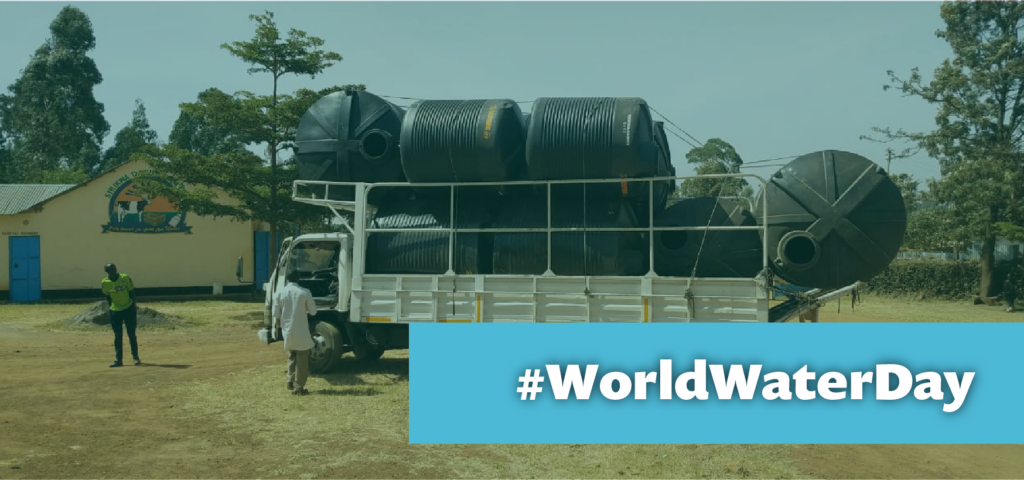
With changing weather patterns and unpredictable rainfall, rainwater harvesting can provide a sustainable source of water for agriculture and livestock production. This is particularly important in dairy farming, as water scarcity and poor-quality water can lead to decreased milk production and health issues in dairy animals. Large water tanks are an efficient method for storing harvested rainwater.
However, financial constraints limit smallholder farmers’ ability to invest in rainwater harvesting tanks for climate adaptation and improved dairy productivity. Lack of access to credit, limited financial resources, and competing household expenses are major barriers to investing in water storage tanks.
Against this backdrop, PxD’s program on Asset Collateralized Loans (ACLs) for water tanks presents innovative financing mechanisms to address water scarcity and liquidity bottlenecks to improve climate resilience and dairy productivity in developing countries.
How dairy ACL works
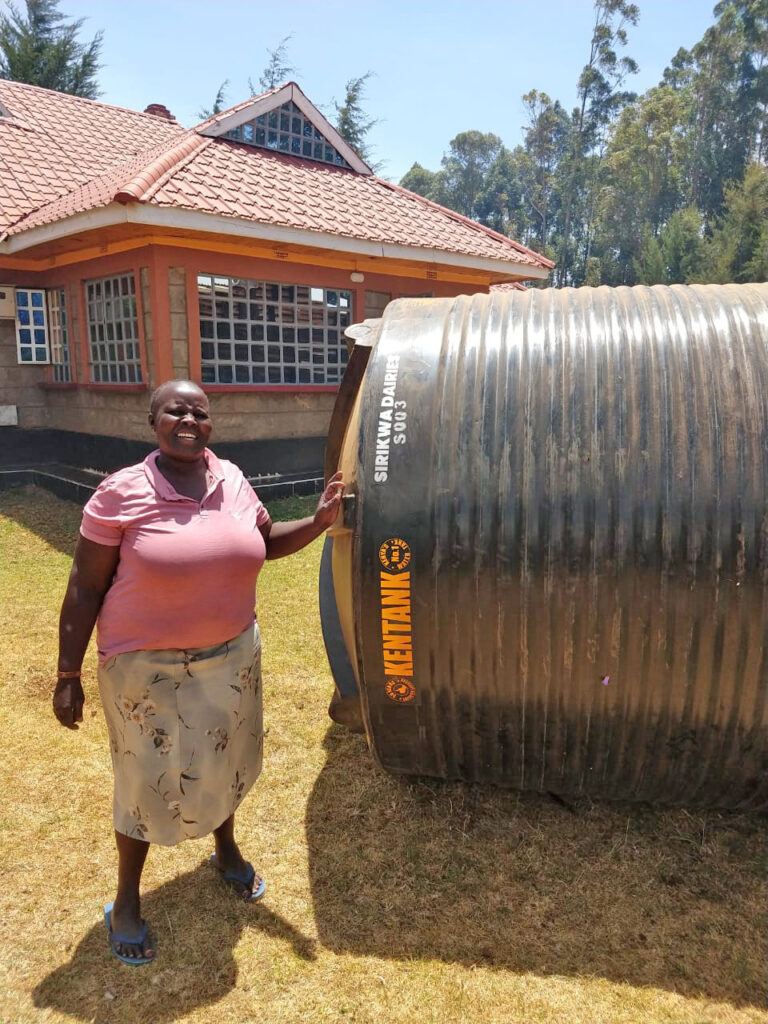
Water tanks pose a unique financing opportunity. They are large and difficult to move, and they retain their market value over time, meaning the assets themselves can serve as the collateral for a loan.
This removes the need for guarantors, which often poses a significant barrier to access to credit. Repayment is made automatically from the milk income earned through milk sales from the farmers throughout the month. If the farmer was to default on the loan, the tank could be resold at close to the original value.
About 1.8 million smallholder farmers depend on dairy farming for their livelihoods in Kenya but a bulk of them are unable to obtain loans from traditional lenders, such as banks, because they do not have the collateral or credit history required.
The ACL approach, therefore, has several advantages over traditional lending methods, which often require extensive paperwork and collateral that many smallholder farmers do not have.
Our Research Project
PxD has been implementing a two-year research project on ACLs for water tanks in collaboration with the University of Chicago’s Development Innovation Lab (DIL) and two dairy cooperatives (Lessos and Sirikwa Dairies) in Kenya’s Rift Valley region.
A previous study (Jack et al., 2019) demonstrated strong evidence that the ACL model for water tanks could improve farming and household health, as well as well-being outcomes among smallholder dairy farmers.
The study, conducted in partnership with the Nyala Savings and Credit Co-Operative Society (SACCO), randomly offered some farmers the opportunity to replace loans with high down payments and stringent guarantor requirements with loans collateralized by the asset itself.
At the end of the study, default rates were extremely low (less than 1%). Milk sales to the cooperative increased by 6-10%. And, because of the increased water supply within households, girls spent 19% less time fetching water, and school dropout for girls decreased by 85%.
This new study aims to evaluate the impact of ACLs for water tanks on economic and household outcomes among dairy farmers in Kenya. The main outcomes of interest include milk production and milk sales, loan performance, dairy farming practices, water use, time use (particularly for girls and women), household welfare, and well-being.
Delivering tanks to farmers
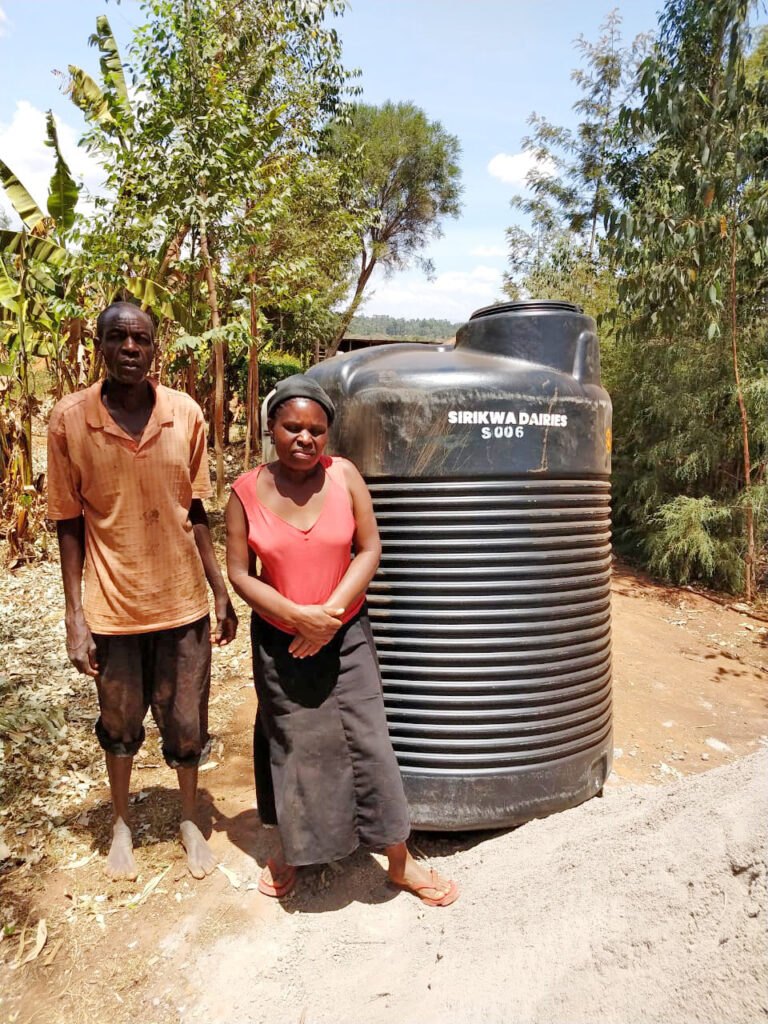
In partnership with the dairy cooperatives, PxD identified farmers that are eligible to receive the water tanks.
Eligible farmers need to pay an upfront deposit (currently 20%) to receive the tank, followed by monthly loan repayments over a two-year period. Farmers can choose between a 2500-liter or a 5000-liter tank depending on their needs. They receive the tanks at their doorstep for free, with a water tap that is ready to install. Starting from January 2023, PxD rolled out the tanks to a small group of 100 farmers. As of mid-March, 15 farmers had received the tank.
Farmers like Philip Too, a farmer from Sirikwa Dairy who has four dairy cows. Most of the people in his village rely on wells for their household water needs but unfortunately, they do not have sufficient water storage equipment. He is one of the few lucky farmers who are connected to electricity and thus he intends to fill his tank with water from a well within his farm using an electric water pump. With the tank, he hopes to have enough water to not only meet domestic needs for his family and livestock but also irrigate his small kitchen garden from which he expects to fetch some income by selling surplus vegetables to his neighbors.
Esther Sambai, a farmer from Sirikwa dairy, decided to get a 5000-liter capacity tank instead of a 2500-liter tank to meet the needs of her household and neighbors. She said, “My well does not dry up and many people in my village get water from my household for free in the morning when I am at home. As you can see, we pump water directly from the well and therefore I decided to get a bigger tank so that I can store enough water for my family and neighbors. With a tank, my neighbors will be able to access water even when I am away. I will also use the tank to supply water to my animals.” Esther has a solar-powered pump but before the ACL for water tanks, she did not have a water storage tank. The ACL has enabled her to finance a tank easily.
Way Forward
In the coming months, we plan to roll out the tanks to additional farmers (with the goal of reaching 750 farmers in total).
From our early interactions, we have learned that several factors influence take-up including time of the year, competing financial needs such as school fees, and low trust in new financial products which could limit farmers’ take-up of the product.
To address this, we hope to pilot low-risk ways of making the ACLs for water tanks more accessible, such as by lowering the deposit or offering a grace period. We will continue to test similar loan flexibility mechanisms until we can define a product that is interesting, safe, and accessible to farmers across contexts and geographies.
PxD is also making its first foray in Kenya into using low-power radio communications for remote sensing by experimenting with water sensors in this study. These sensors will allow us to measure real-time water levels for dairy farmers so that we can correlate supply, consumption, and dairy output. We hope this paves the way for us to explore the use of other sensors (such as those that measure soil moisture or air quality) to improve farmers’ access to real-time information.
Our first few months of rolling out water tanks have given us insight into the potential for ACLs to enhance credit access for productive assets by reducing the financial burden and collateral obligation that smallholder farmers typically face.
We believe this initiative can have a profound impact on farmers and their families in different contexts struggling with access to water, and could be a path not only to increase profits for farmers and the welfare of their livestock, but improve the well-being of women and girls who are those being most impacted by climate change.
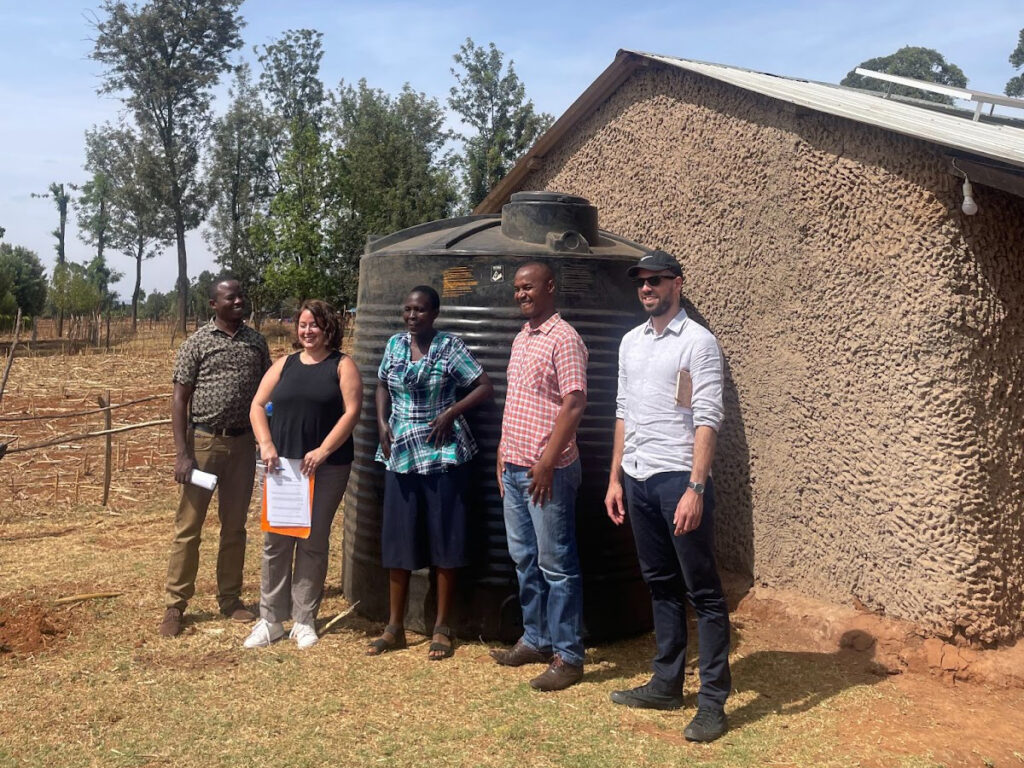
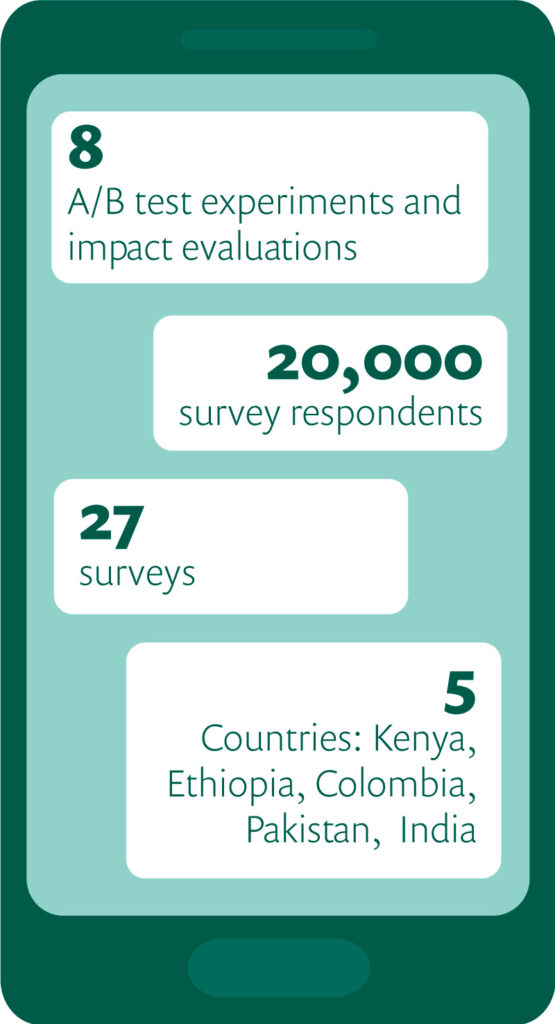
2022 was a tremendous leap forward for research at PxD. Our research and operations teams completed a total of eight A/B test experiments and impact evaluations. We collected data in person and over the phone from approximately 20,000 survey respondents in 27 distinct surveys that took place in Kenya, Ethiopia, Colombia, Pakistan, and three states in India.
We generated new insights to build future programming such as an SMS agro-dealer directory to reduce input market information frictions, built evidence-based proofs of concepts for innovative service design such as WhatsApp-based crowdsourcing chatbot and learned to leverage research partnerships for scalability with dairy cooperatives. We used research insights to shift and refine our approach and we are excited about further impact evidence from forthcoming analysis in 2023.
Devastating events in 2022 from drought in the Horn of Africa to the 100-year flood in Pakistan emphasize that climate change is one of the most urgent challenges facing our users. As such, we have intensified our research efforts to identify interventions that can improve smallholder livelihoods whilst incorporating climate adaptation and mitigation efforts into our existing services. We’ll continue this innovation research agenda in the coming year to explore high-value innovations to supplement our core digital agricultural advisory.
New insights to build future programming
Across a diverse portfolio of research projects, we have demonstrated the value of PxD’s services and contributed to an expanded knowledge base on digital agricultural extension. A particularly promising finding is establishing that digital tools can be effective in improving in-person extension services.
Performance goal reminders sent via SMS messages could increase extension volunteers’ performance: Through a large-scale randomized evaluation in Rwanda, we demonstrated that performance goal reminders sent via SMS messages – particularly goals that were ambitious but attainable – could improve community extension volunteers’ (known as Farmer Promoters – FPs) performance and therefore generate positive impacts on farmers’ outcomes. Sending goal reminders to FPs significantly increased the number of farmers trained by 3.1 percent, led to a significant 4.3 percent more training sessions being delivered, and increased farmers’ registration for subsidized inputs by 1.9 percent (statistically insignificant) over FPs who did not receive goal reminders. Given that the unit cost for each SMS is $0.006 and the average number of farmers assigned to each of the ~14,000 FPs across Rwanda is 190, the effect sizes of these messages are likely to be highly cost-effective.
The results of the Rwanda project support the expansion and replication of extension agent interventions in other settings targeting different populations in the future. In addition, these results point to areas for future research and development that could enhance the effectiveness of extension agent services. For example, we are interested in exploring how digital tools can be used to help extension agents set performance-increasing goals, direct them to farmers most in need, and extend information access to farmer populations that may not benefit from direct digital advisory services.
A digital directory of agro-dealers has the potential to increase the adoption of recommended inputs: In Kenya, we found evidence that farmers can benefit from the provision of an SMS agro-dealer directory by reducing input market information frictions. Our preliminary empirical findings suggest that – particularly for a directory that includes stock and price information about agro-dealers – access to this tool prompts farmers to refine their choice of agro-dealers before an in-person visit. Farmers in the treatment arm who had access to the agro-dealer directory and stock information contacted 21 percent more agro-dealers, but visited 4 percent fewer agro-dealers relative to the control group which did not have access to the tool. This suggests that farmers in this treatment arm used the contact information to call more agro-dealers before spending time and money to travel to the shops themselves.
Farmers given access to the agro-dealer directory were more likely to purchase PxD-recommended inputs and experienced fewer stockouts than those who didn’t have access to the directory. When pooling the two treatment arms, we observe that consistent with PxD’s advisory recommendations, treated farmers were 6 percent more likely than control farmers to use hermetic bags to store maize – a practice shown in rigorous studies like Ndegwa et al. (2016) to prevent post-harvest losses from pests. Farmers in the treatment arm with access to the directory but not stock info appeared to contact and visit agro-dealers at the same rate as the control group but then were 22 percent less likely than the control group to report facing an input shortage when they shopped (meaning they were more likely to find and purchase the product they were looking for).
Building on these promising findings, we hope to identify opportunities to further develop a scalable digital agro-dealer directory tool. Specifically, we are interested in exploring ways to onboard a large number of agro-dealers and update the stock information at a low cost.
Building proofs of concepts
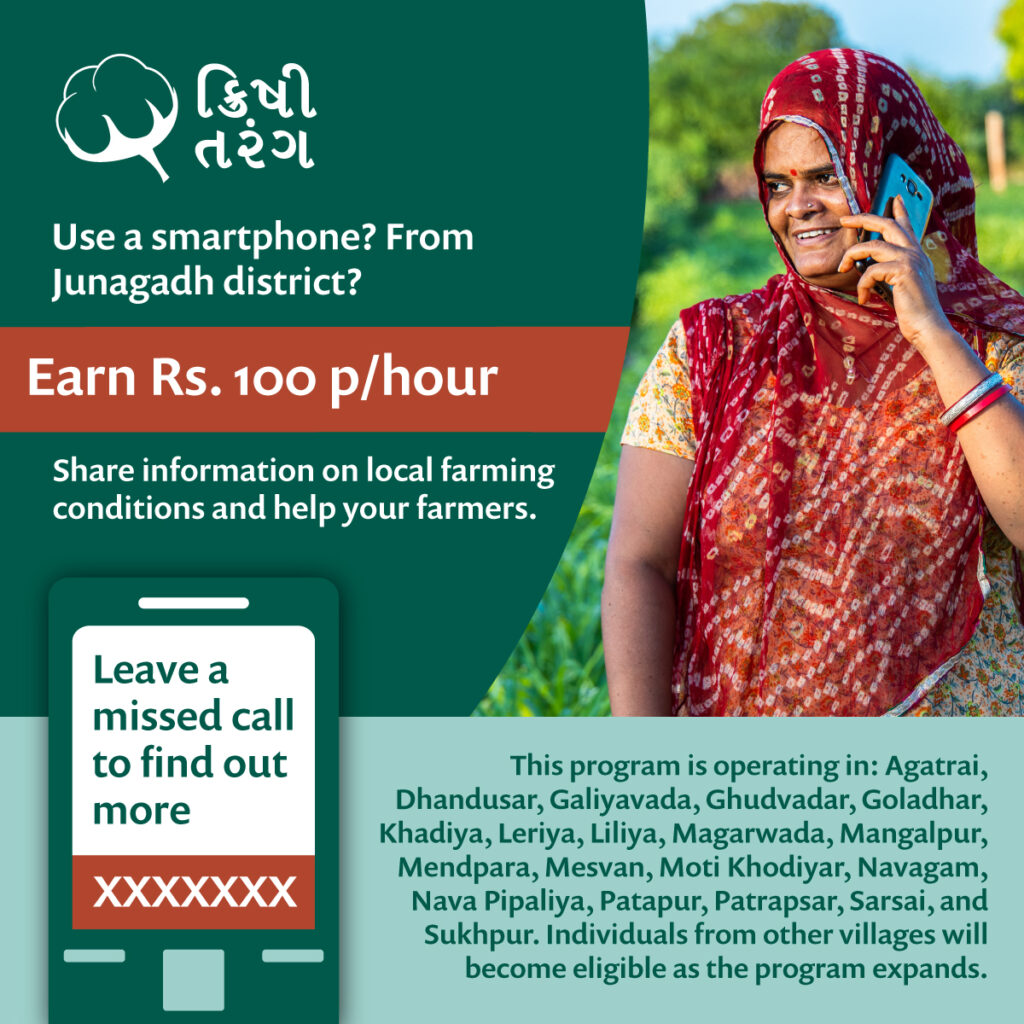
Digital peer groups increase farmer interactions and potentially increase the adoption of recommended practices, but we need creative ways to form groups at a low cost: Various research projects aimed to demonstrate proof of concept for novel interventions that PxD was exploring for the first time. For example, we now have empirical evidence that an intervention in Kenya to organize farmers into groups and send them SMS nudges to communicate with each other was effective at increasing both engagement with PxD’s service and communication between group members. Treatment farmers who were organized into digital peer groups had higher interaction levels than their control group counterparts and were 43 percent more likely to meet with their group members on a farm than control farmers. Interacting with one’s group members on a farm was also associated with increased adoption and knowledge of recommended practices.
A gig-worker model for crowdsourcing agricultural field photos has the potential to generate real-time data on field conditions: We acquired institutional knowledge, both technical and regulatory, to build and operationalize crowdsourcing platforms to demonstrate the feasibility of crowdsourcing information from agro-dealers and farmers in Gujarat. In a pilot, we set up a WhatsApp chatbot, integrating a WhatsApp Business Account with our in-house user communications platform, Paddy, to guide users through a systematic inspection of a field for crop health issues and send reports back to PxD with their findings.
Eighteen of our recruited farmer agents consistently engaged with the program over 10 weeks, with a median of nine crop health reports per agent. The quality of field reports was high – approximately 94 percent of reports are usable. In total, we received 220 field reports with accurate GPS locations and usable photographs. Each of these reports costs INR 125 (USD 1.67), which is substantially below the cost of a 15-minute phone survey. This suggests that crowdsourced data could be a cost-effective method of collecting local data.
PxD aims to further build this knowledge to crowdsource various types of information and use it to improve future service offerings by customizing advisory to be more locally relevant and actionable.
Working with smallholder farmers in the fight against climate change
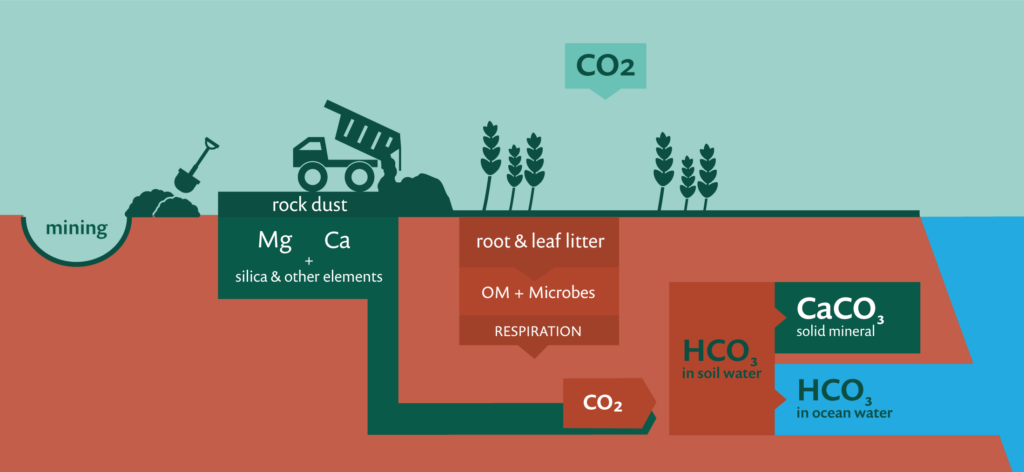
We are intensifying our efforts to provide information to smallholder farmers that will allow them to make informed decisions to reduce the risks that climate change presents to their livelihoods and to consider adopting practices that can actively reduce greenhouse gas emissions. We approach this work with the guiding principle of farmer welfare first: smallholder farmers cannot be expected to pay the price for climate change mitigation. Climate change-related advisory should directly support livelihood gains via improved agricultural output or renumeration .
PxD, in collaboration with the Institute for Governance and Sustainable Development (IGSD), worked to assess opportunities to benefit poor farming communities through their participation in climate mitigation activities and to direct tangible returns to participating smallholder communities.
The PxD-IGSD collaboration has focused on exploring four mitigation areas with most promise in agriculture: Carbon dioxide sequestration through enhanced rock weathering; Carbon dioxide sequestration with organic carbon storage in soils and plant biomass; Nitrous oxide mitigation through precision nutrient management; and Methane mitigation in dairy through improved livestock feeding practices.
- Enhanced rock weathering (ERW), an emerging technology that permanently draws down carbon from the atmosphere and has the potential for agricultural co-benefits makes it an attractive mitigation strategy in the smallholder farmer context.
- There is evidence that conservation agriculture practices that many farmers are already familiar with – such as reduced tillage, the use of cover crops, and intercropping – promote the sequestration of organic carbon in soils.
- In terms of nitrous oxide emissions, simple decision support tools following the Site Specific Nutrient Management approach, i.e. Leaf Color Charts (LCC), have been shown to reduce nitrous oxide emissions from nitrogen fertilizer use as well as improve farmer outcomes.
- For methane, improving feeding practices that increase milk production and closing the dairy yield gap in the Global South per cow can lower the methane intensity of production and contribute to methane mitigation, as well as improving farmer livelihoods.
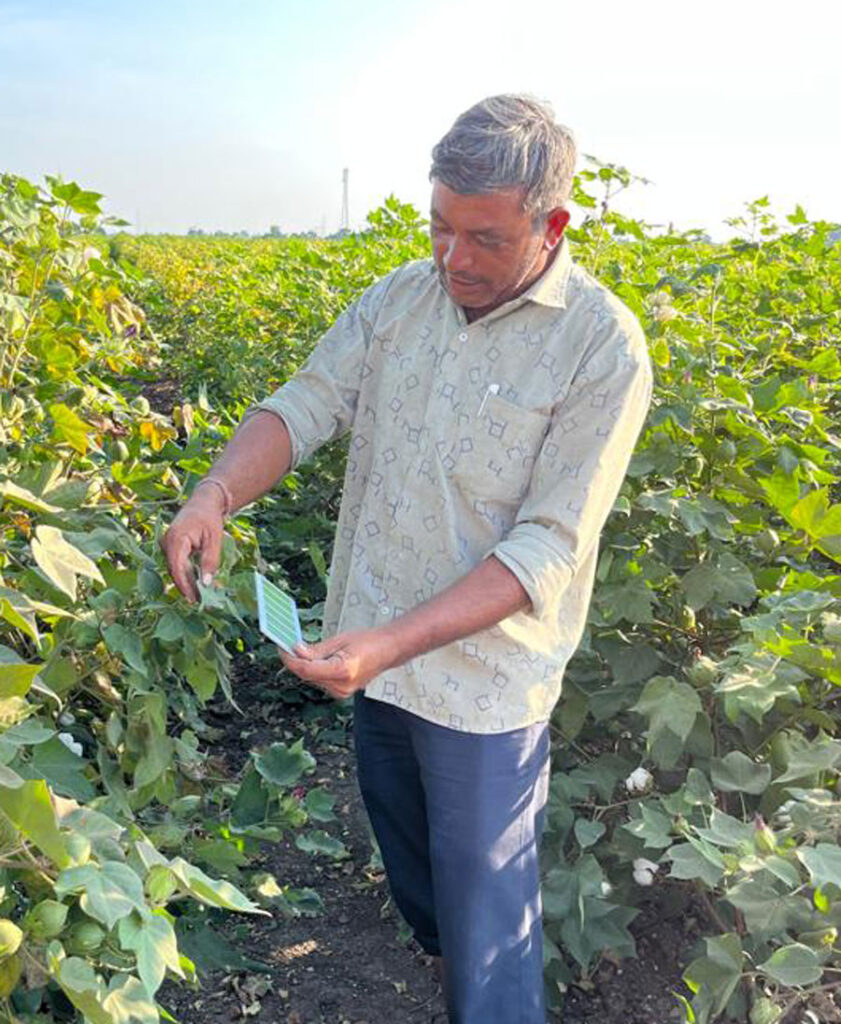
We’re excited to be on the cutting edge of exploring the potential of these climate change mitigation opportunities- like scoping a digital version of Leaf Color Charts to enable the tool to reach a wider scale and Advanced Market Commitments to incentivize R&D for enhanced rock weathering. Our research initiative with IGSD has enabled PxD to identify future activities within each opportunity area to advance climate change mitigation in the smallholder farmer context and we are actively pursuing partnership and funding opportunities to advance these activities.
Learning to leverage research partnerships for scalability
Partnerships have proven to be a critical pathway to increasing impact and scaling evidence-based programs across our project portfolio.
By collaboratively identifying and developing high-impact opportunities with dairy cooperatives in Kenya, PxD has identified a new partnership model in which PxD serves as a technical and analytical partner for innovating and testing service offerings for cooperatives, and builds cooperatives’ capabilities for generating greater impact at scale. We kicked off the partnerships with Lessos Dairy and Sirikwa Dairy by adapting an asset-collateralized loan product for water tanks which has been shown to dramatically increase access to water tanks among dairy farmers in a research study (Jack et al, 2022) and setting up an evaluation to measure its impact on economic and household outcomes.
In Gujarat, India we surmise that identifying low-cost and scalable approaches to crowdsource pest information will require leveraging local organizations and existing social networks for cost-efficient recruitment and training of agents.
To further explore opportunities to support women farmers in Gujarat, we successfully established partnerships that allow us to better understand the constraints women farmers face in engaging in economic activities and their access to information and other services. These partnerships allow us to design and implement group-based digital services to address those specific constraints.
Insights to shift and refine our approach
Our scoping activities allowed us to identify when a change in approach was needed or when interventions did not turn out to be as promising as we had hoped.
In the dairy sector in Kenya, we learned that existing market and coordination failures, such as credit constraints, need to be addressed to create an environment in which digital advisory can effectively improve smallholder dairy productivity.
In testing social learning mechanisms in Kenya, we did not find evidence that the designed intervention increased farmers’ knowledge or the likelihood of adopting recommended practices, despite finding that peer learning was effective at increasing both engagement with PxD’s service and communication between group members.
While subsequent qualitative interviews suggest that some farmers visited the farm fields of their peers and experimented with the recommended practices in a small portion of their plot, developing the digital peer group advisory further is likely to require a substantial investment in basic research to understand farmers’ social learning process and identify creative ways to reduce the relatively high costs associated with forming peer groups.
Finally, we learned to exercise caution in working with established women’s groups in Gujarat in a way that does not exacerbate local power dynamics within communities to ensure PxD’s services are designed in a sensitive way to promote the inclusion of marginalized groups that may face particularly challenging digital access gaps.
Looking forward to continue building our evidence base
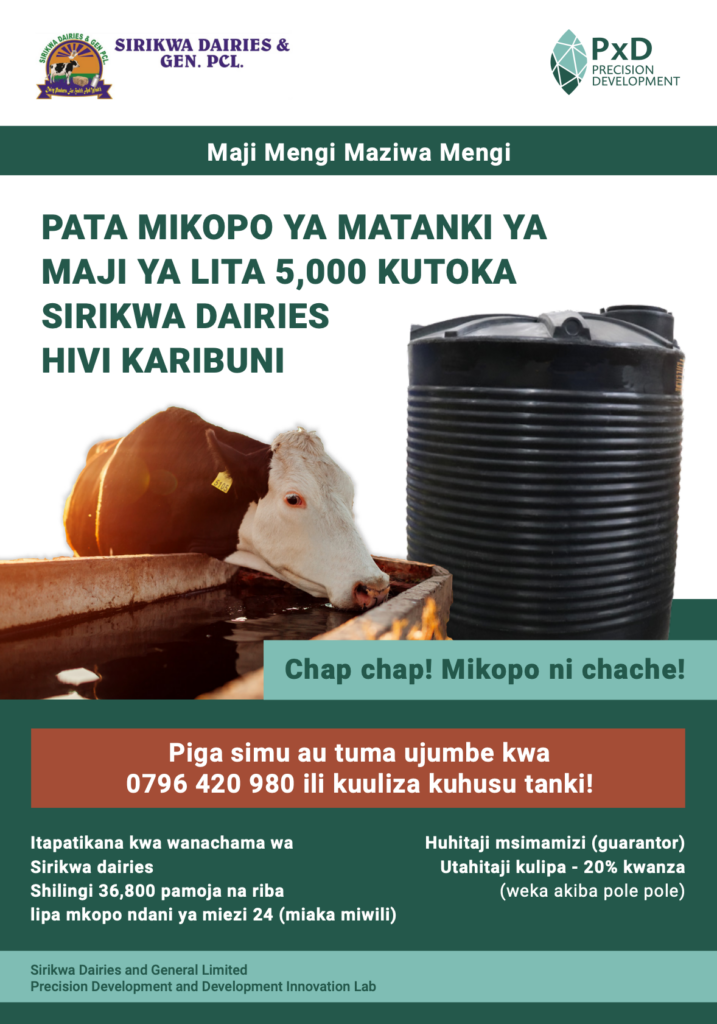
In the coming year we are looking forward to continuing to build our evidence base with forthcoming insights on PxD’s impact on farmer welfare from several large-scale RCTs in India, Uganda, and Kenya.
For the impact evaluation of our largest service offered to date for rice farmers in India, endline data collection and analysis are expected following the second season of implementation in 2023. In addition to outcome data on farmers yields and profits, we’re excited to generate additional insights on scalable measurement options for detecting yield changes among rice farmers using remote sensing data.
In Uganda, our work with coffee farmers enabled PxD to explore several dimensions of digital advisory, including comparing a stand-alone digital advisory service to the provision of digital advisory as a complement to in-person training and studying social spillovers from our advisory services. An endline analysis of the effects of this program will be forthcoming in 2023.
We are also excited to generate initial insights on the impact of asset-collateralized loans for water tanks on economic and household outcomes among dairy farmers in Kenya. Using frequent administrative data from dairy cooperatives on milk production, we’ll be able to understand how improved access to water tanks helps farmers mitigate productivity shocks and domestic water shortages as farmers adapt to more dry spells from a changing climate.
In addition to evaluation research with rigorous RCTs, we look forward to building out our research innovation agenda in the coming year. We are exploring a variety of new, evidence-based high-value product innovations that can build on our agricultural impact for smallholder farmers, such as interventions to facilitate market linkages and access complementary financial services. We are committed to using rigorous evidence and deep user research to identify and prioritize which ideas to pursue.
We look forward to sharing new insights with you throughout 2023! If you’d like to learn more or partner with PxD on specific areas highlighted please get in touch!
Paying people for actions that contribute to climate change mitigation, known as payment for ecosystem services (PES), has the potential to address both environmental and poverty alleviation goals. For example, there is a strong history of PES programs to reverse and slow deforestation in communities in the Global South. Emerging evidence of PES in the agricultural context also shows incentivizing smallholder farmers monetarily can be effective in encouraging behavior change for climate change mitigation.
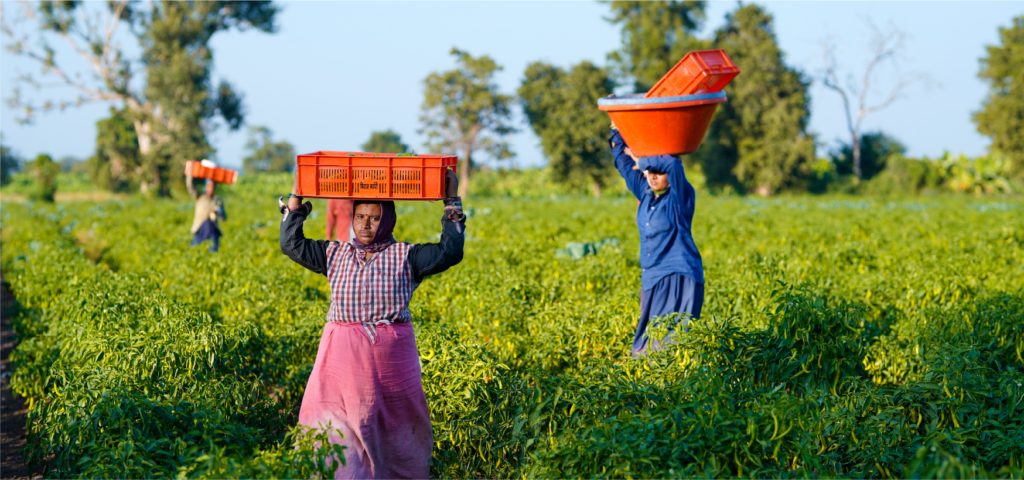
One way to finance PES programs gaining increasing interest from both the public and private sector is the voluntary carbon market, expected to be worth $50 billion by 2030. Connecting farmers to the amount of climate financing potentially available in the voluntary carbon credit market may help facilitate a sustainable agriculture transformation. However, a key variable still poorly understood is what the value of carbon credit prices should be to appropriately compensate farmers while also achieving carbon removal goals. The low and volatile prices of current nature-based carbon sequestration projects, ranging from $5–$15/ton of carbon from 2021 to 2022, can exacerbate the equity challenges PES programs face, especially in smallholder farmer contexts where ensuring procedural fairness and safeguarding the rights of smallholder farmer communities are critical.
There is currently little transparency into how prices for voluntary carbon market projects are determined, as well as the percentage farmers ultimately receive. As there is no standard system for carbon credit pricing, most pricing is determined between individual buyers and the specific project developer. If the buyer is a corporation that has set an internal carbon price, then there can be a degree of transparency in the price that the buyer is willing to offer for carbon credit projects. However, as the World Bank stated in a report on carbon pricing:
The market for credits from independent crediting mechanisms is heterogeneous, with buyers placing a range of values on characteristics such as the sector (e.g., type of activity), geography, age/vintage, and co-benefits of credits. While recent years have seen some moves toward offering standardized contracts…prices vary widely, with trading platforms offering contracts representing credits from different sectors.
There are also few voluntary carbon market projects available right now which involve smallholder farmers, which makes assessing the true price potential of these types of projects difficult.
Yet, the market is developing rapidly and the long-term vision for the sector will be to ensure standard processes (i.e. contracts, measurement, reporting, and verification (MRV) of climate change mitigation outcomes, etc) exist so buyers are certain of the carbon removals they are purchasing and the supply of carbon credit projects consists primarily of those for which carbon removals can be verified. The combination of the two will help ensure higher voluntary carbon credit credits in the future and any smallholder farming communities involved are appropriately compensated. A Bloomberg report estimates in a scenario where only verified carbon removals are allowed in the carbon market supply, “prices shoot up to $224/ton” by 2029.
There is another side to having prices this high, as the same report states that under this high price scenario, carbon credits may be seen as too expensive and be regarded as a “niche, luxury product” that few buyers can afford. However, while we may not want to be in a world where carbon credit prices are in the hundreds of dollars, it is clear there are fixable market failures in the current voluntary carbon market – information costs and transaction costs – which prevent smallholder farmers from getting full value for emissions reductions.
The Science Based Targets Initiative and the Voluntary Carbon Markets Integrity Initiative are examples of organizations working to advance rigor, transparency, and standardization in the voluntary carbon credit market. Higher and more stable prices will strengthen the power of the voluntary carbon credit market to provide equitable payments for ecosystem services programs for smallholder farmer behavior change.
Achieving such prices will require investment in the standard market process mentioned above which will improve the credibility and verifiability of carbon credit projects as well as make the voluntary carbon market a realistic pathway for smallholder farmers to increase their incomes by participating in carbon removals.
PxD published an analysis of the opportunities for smallholder farmers to drawdown of carbon which discusses both the evidence for such strategies (including conservation agriculture practices, agroforestry, and biochar) and the barriers to widespread implementation. We aim to leverage our scale – PxD services reached over seven million farmers in nine geographies last year – to continue to explore ways for farmers to engage in voluntary carbon credit markets and push for market developments which facilitate their participation. We welcome connections with organizations and funders who are also interested in such work so we may work together to improve both livelihoods and protect our planet.
Punjab means “five rivers”, and those five rivers are the reason that the Punjab region in Pakistan is the country’s bread basket. Tomoko and I were in Punjab last week visiting the PxD Pakistan country team. As many of you will know, PxD in Pakistan is housed within a local economics research institute, CERP, a partnership that has enabled us to be more effective and flexible.
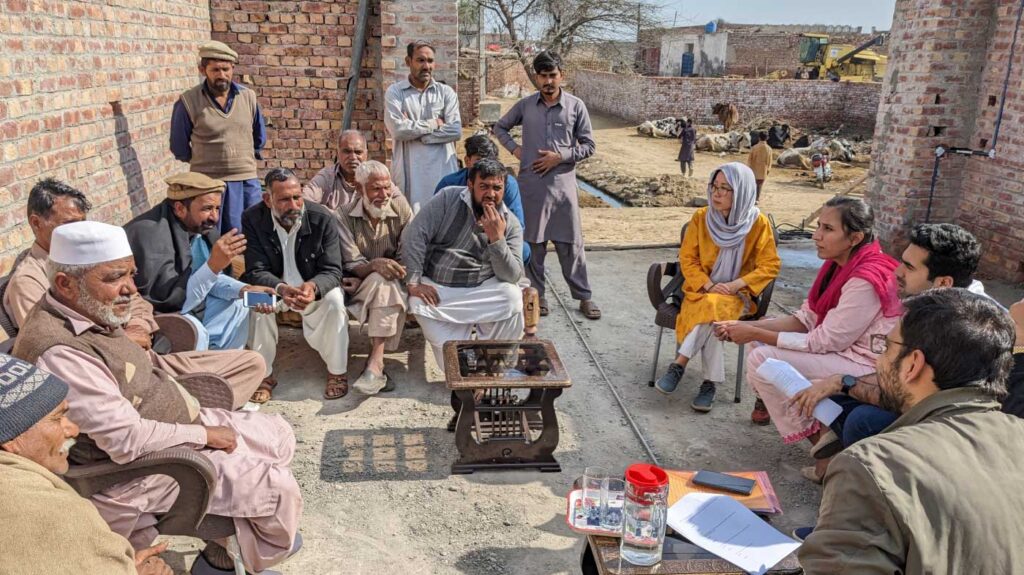
This week much of our attention has been on smallholder rice production. The staple food in Pakistan is of course wheat (for roti), but rice is a major crop for both domestic consumption and export. (We were in town at the same time as the IMF delegation, negotiating a package of macroeconomic reforms to stabilise the economy, so those export earnings are important right now).
Punjab is famous for its basmati rice, a variety much prized for its aroma, fluffiness and grain length. It is very popular in traditional dishes like biryani and pulau. We visited Kala Shah Kaku Rice Research Institute, established in 1926, where basmati rice varieties have been developed since the 1930s. Farmers in Pakistan typically grow wheat in the Rabi season and then many grow rice in the Kharif season, especially in the basmati belt in Punjab. The yield of basmati rice is around half as much per hectare as hybrid rice varieties, but it sells for around twice the price, so generating similar revenues and broadly similar net income per hectare. (An exciting development on the horizon is the prospect of hybrid basmati rice that may have a much higher yield while retaining much of the quality for which basmati rice is famous.)
Many of the people we met were keen to stress that Pakistan, rather than India, is the home of basmati rice. I’d be very glad if the rivalry between these two great nations were confined to arguing about the origin of basmati rice and, far more importantly, their relative prowess in cricket.
Pakistan’s farmers produce on average around 4 tonnes of rice per hectare, about the same as in India. In China, the yield is 7 tonnes per hectare and in Australia 10 tonnes per hectare. The yield gap (that is, the gap between what farmers produce and what they could produce with the land and other inputs available to them) is estimated to be about 50% – about 3.5 tonnes per hectare – for basmati rice, and closer to 60% – 6 tonnes per hectare – for the higher yield but lower price varieties. In other words, farmers could, in principle, at least double their yields. So what is holding them back?
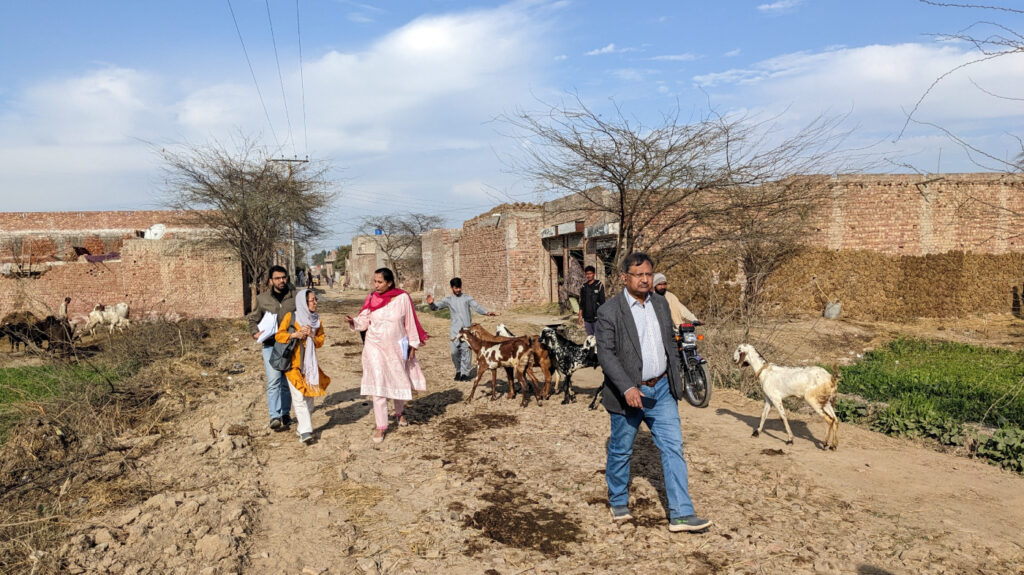
You would expect farmers to be more interested in increasing their profit than their yield, so one possible explanation – in theory – could be that the additional inputs are too costly, and the value of the extra output does not justify the investment. In that case, it would be rational for farmers not to increase their output this way. But that doesn’t seem to be the problem. The additional cost of the recommended inputs, at market prices, is small relative to the price that basmati farmers could get for the roughly extra 3-4 tonnes per hectare that they could be producing. Despite extra input costs, the extra yield on this scale would lead to much higher profits – perhaps multiples of profits now being earned. If you are doing only a little better than breaking even, then moving to a reasonable surplus could mean a transformational increase in net income.
So what is getting in the way? We spent two days in villages outside Lahore talking to farmers, extension agents, and private and public sector experts to try to get a better picture.
My main take-away is that it seems that expensive credit for agricultural inputs and low prices paid by middlemen (called aahrtis) leaves farmers with little surplus. Farmers are unwilling to take on a large, expensive debt which – if the harvest is bad – they may not be able to repay, especially when they know that a big chunk of any profit, if the harvest is good, will go to the middleman. So they stick to limited use of inputs, which gives them lower yields and less debt and thus lower risk. Thus it is the cost of credit, and the associated risk, rather than the cost of the inputs themselves, that stops them from investing more.
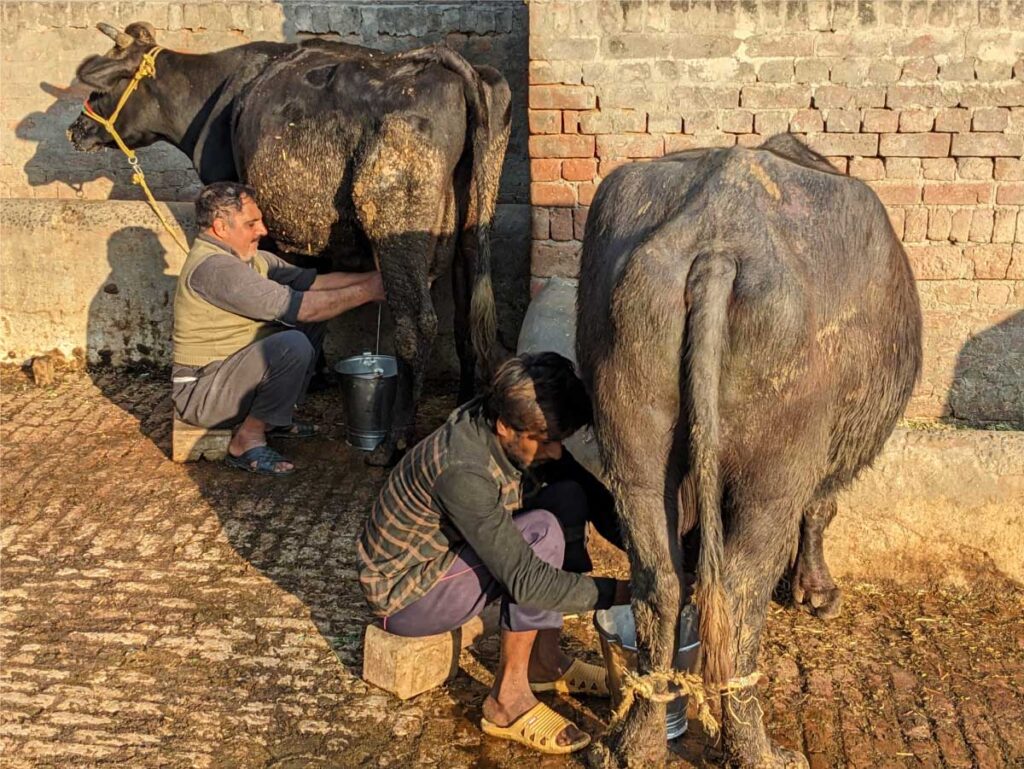
I’m conscious that we met farmers close to Lahore, who are relatively well-off, and who are already in contact with extension services. So we should be careful about drawing too many conclusions. Based on these few conversations with an atypical group of farmers, I find it hard to convince myself that there are very many practices that farmers could adopt that they do not already know about. That said, there may be some value to encouraging practices that cost the farmer little or nothing to implement – or which save inputs such as using the right amount of urea – for example by issuing timely reminders. But it looks as if the larger gains would come if we could find a way to reduce the risk of increased investment in inputs, reduce the cost of credit, provide high-resolution weather information, or perhaps improve planning and coordination in the use of scarce machinery or casual labour.
It is harder to notice what is missing than what is in front of you. As you may see from the photos, we did not meet any women farmers. We met a female scientist at the rice institute, but everyone else we spoke to was a man. In every conversation, farmers were routinely and unthinkingly referred to as “he”. Yet we know that women provide a substantial part of labour in agriculture, and are hugely affected by all the decisions that are made. If we want to understand what it would take for farmers to adopt practices that would increase their yield and their incomes, we are likely to learn a lot by talking to women too.
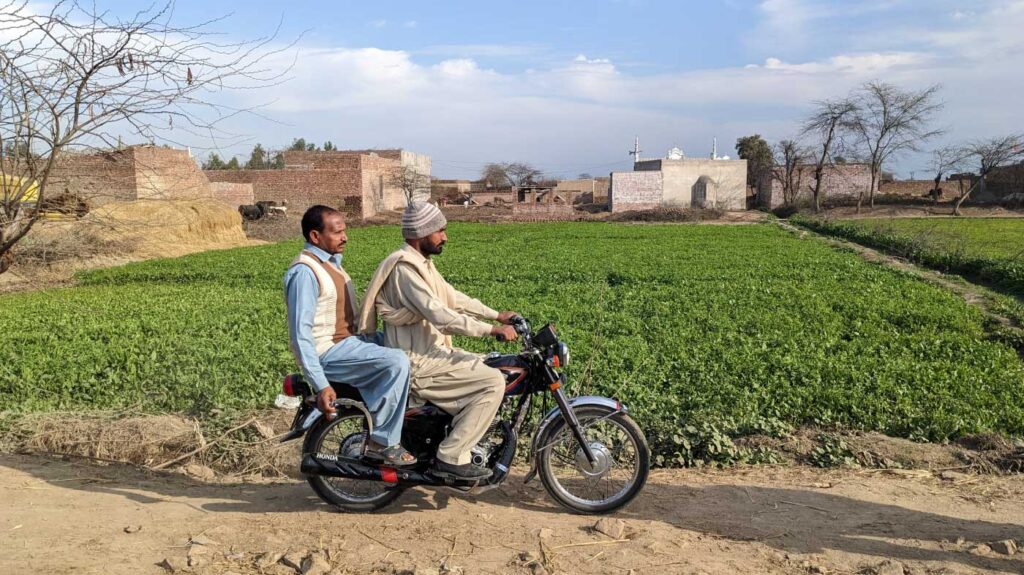
I leave Pakistan optimistic but uncertain. Optimistic because the opportunities are huge for large increases in yield and potentially transformative increases in farmer incomes. The constraints are real, but there may be solutions that have a low marginal cost per farmer and so would be hugely cost-effective at scale. Uncertain because we do not yet have enough information to arrive at robust ideas for higher-impact services that we could design and test.
I want to thank Adeel, and all the team, for giving up so much of their time and energy to host us – including taking us to the old Walled City of Lahore to have dinner overlooking the famous Badshahi Mosque (Mosque of Kings) and the Lahore Fort (Shahi Qila in Urdu), an ancient citadel of the Mughal Empire. I look forward to returning to Pakistan soon and hope to combine my next trip with some tourism in your beautiful country.

A new PxD report details fee-for-service private sector collaboration to support free digital extension service delivery to farmers in poverty

With support from the Swiss Re Foundation, PxD investigated the viability of new forms of partnership with private sector firms to offset the costs of delivering digital advisory information to poor smallholder farmers at no cost to the end-user. PxD initiated a series of pilots that, for a fee paid by private sector partners, connected farmers to agricultural services offered by the same private firms. The pilots investigated the potential for fees derived from partnerships to offset the cost of delivering free information to farmers.
Platforms built and supported by PxD provide scientifically validated and customized digital advice to poor smallholder farmers. This information helps our users make more informed decisions to improve productivity, yields, and incomes, and advance more resilient livelihoods. A majority of our users receive information via platforms we have built in partnership with governments and non-governmental organizations. The overwhelming majority of our users pay nothing to receive information from these platforms. But that does not mean that the information is free of costs. We rely on funding from donors and governments to cover the costs of the service, and sustainable service delivery.
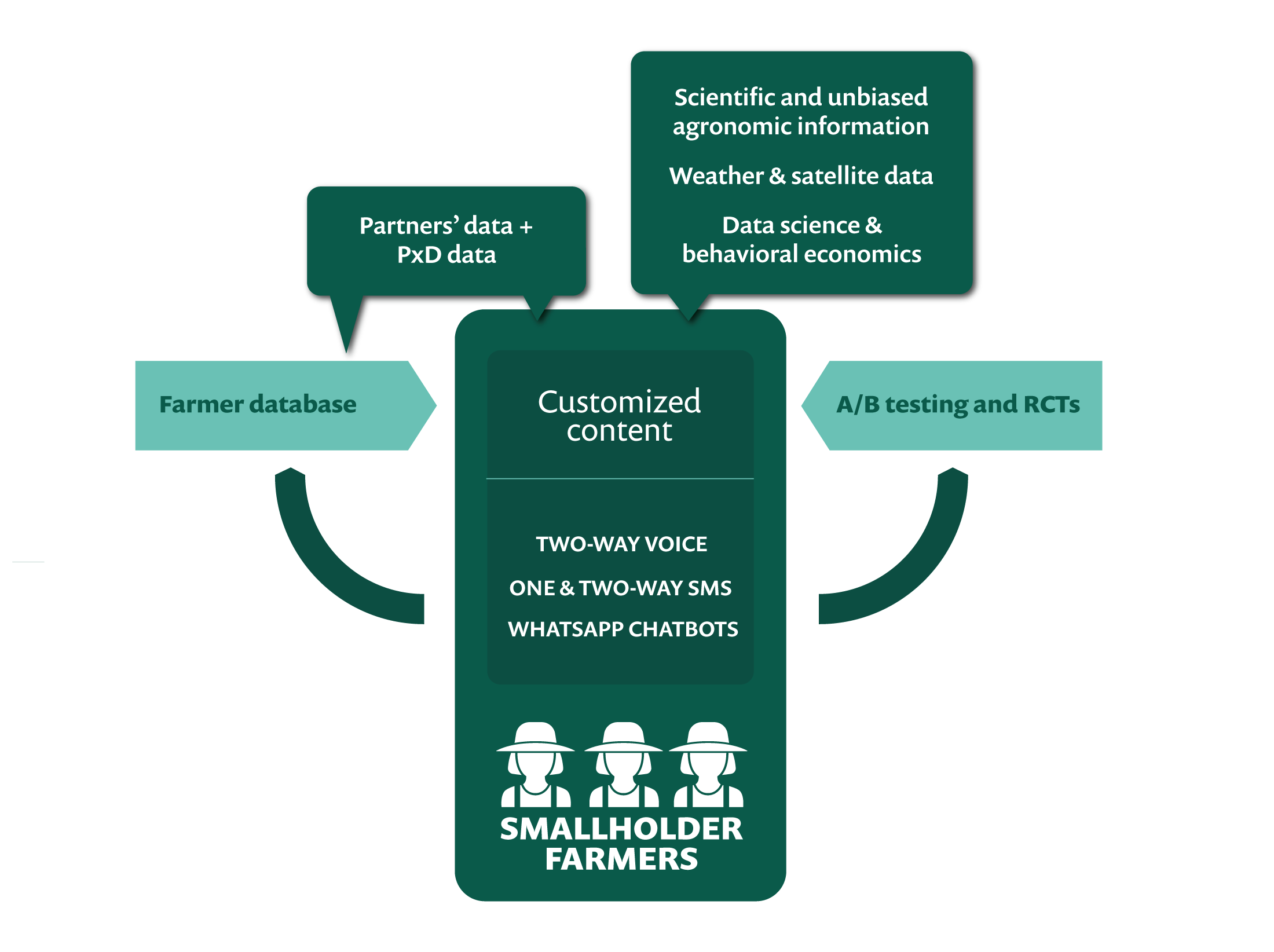
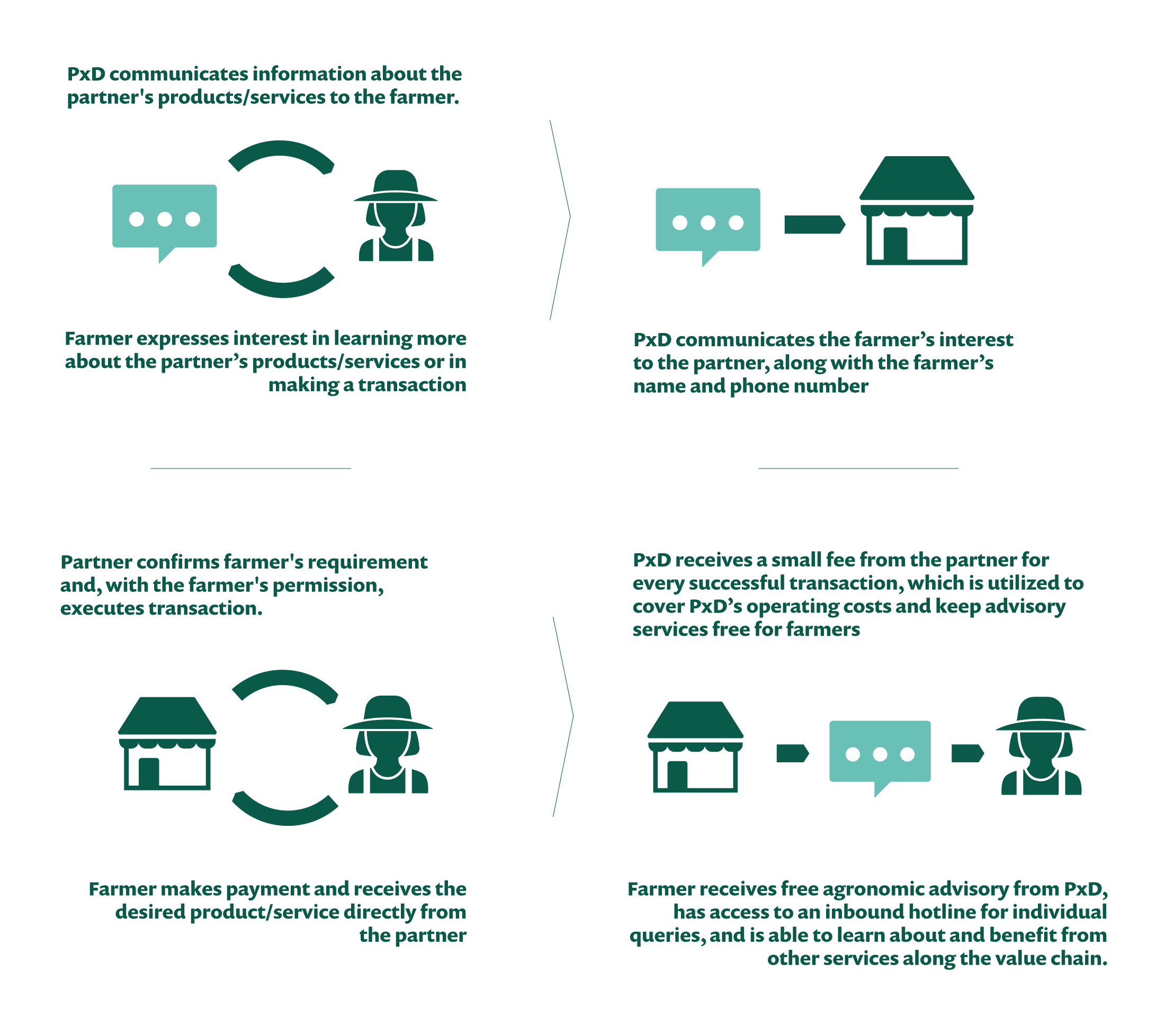
A new report by PxD presents the findings of these investigations. Support from the Swiss Re Foundation enabled PxD to uncover new insights about models of private sector collaboration with the potential for revenue generation at scale and a range of insights about the effectiveness of these services and the viability of new models for partnership. The project also enabled PxD to grow Krishi Tarang, our existing wholly-owned digital advisory service in Gujarat, India, to over 100,000 farmers.
PxD is collaborating with the Institute for Governance and Sustainable Development (IGSD) to identify opportunities to benefit poor farming communities through their participation in climate mitigation activities.

The 27th Conference of the Parties (COP 27) to the United Nations Framework Convention on Climate Change, is currently taking place in Sharm El-Sheikh, Egypt. COP27 has been dubbed the “African COP” due to its location as well as its strong focus on food systems and agriculture, both of which present pressing climate-related challenges for the continent and many other Global South geographies.
The adoption of improved inputs, new technologies, and practices enabled the agriculture sector to build many ladders for smallholder farmers to climb out of poverty, particularly following the Green Revolution. As yields have increased and farmers produce more than their families consume, selling surplus production has progressively increased farming families’ incomes, reduced the incidence of famine, and improved global food security.
Yet, from drought in the Horn of Africa to the 100-year flood in Pakistan, climate change is devastating smallholder livelihoods. Among its many pernicious effects, a warming climate will accelerate desertification and the incidence of drought, expose farming families and their animals to extended and escalated levels of heat stress, increase the incidence of catastrophic weather events, further erode the viability of marginal land worked by poor farmers, and contribute to the migration of new pests and disease, as well as the intensification of existing sources of blight and infestation in smallholders’ fields.
The impacts of climate change on agriculture are complicated by the fact that the agricultural sector is a significant emitter of Greenhouse Gases (GHGs), particularly methane – associated with livestock and rice production – and nitrous oxide – associated with nitrogen-rich fertilizers and animal waste. Recent estimates suggest that food production accounts for approximately one-third of global GHG emissions associated with human activities.
The effects of climate change, and agriculture’s role in generating GHG emissions, will undermine agriculture’s historic role as a critical engine for economic growth and lifting people from poverty. It is critical that we develop innovative solutions to combat climate change while assisting those who bear disproportionate effects. Marginal livelihoods will need to be further supported to adapt to a changing climate to mitigate the risk of deepening poverty. Concurrently, it is critical that we identify opportunities for poor farmers in low- and middle-income countries to contribute to emissions reduction to secure and advance their livelihoods.
In partnership with the Institute for Governance and Sustainable Development (IGSD), Precision Development is investigating opportunities that equip smallholders as agents of climate change mitigation and direct tangible returns, whether through payments for their environmental services or private agronomic benefits, to participating smallholder communities.
This work is guided by the following principles:
- Farmer benefit first: Smallholder farmers can not be expected to pay the price for climate mitigation. Climate-related advisory should support livelihoods and if it is difficult to understand a priori how a specific agricultural practice or technology might impact yields or income, we commit to exploring ways to compensate early adopters as payment for the broader social benefit.
- Consider the cost-benefit ratio: We aim to determine smallholders farmers’ private returns to the adoption of new technologies or agricultural practices, as well as the societal return of such adoption, as measured through the impact of these innovations on our main outcomes of interest in the climate mitigation space (i.e., GHG emissions).
- Replicate and Scale: We aim to deliver impact at scale. We are particularly interested in feasible low-cost innovations with a high potential for impact at scale that can be customized to local contexts.
The results of our investigations will be published as several analytical reports in the coming months. In advance of those publications, this post collates an overview of our findings about practices that are most likely to meet these criteria.
Carbon Dioxide Mitigation through Enhanced Rock Weathering (ERW)
Enhanced rock weathering is a new technology to draw down carbon that leverages the natural weathering process of certain types of rocks. Finely ground rocks are applied to soils to drive chemical reactions which capture atmospheric carbon and convert it into stable forms. This stable carbon then flows through groundwater into the oceans, where it can be stored for thousands of years. The application of ERW has significant potential for scale, and permanent carbon drawdown, particularly on agricultural land. However, the implementation of ERW technologies has been limited largely to study environments in high-income countries. Even in these contexts, market, scientific, and technical mechanisms for its successful deployment require further development (i.e. carbon crediting methodology). There is significant interest from climate financing organizations. For example, Frontier – an entity with significant backing from the tech industry – is pursuing an advanced market commitment to fund carbon removal through ERW. However, given the current focus of ERW development in Global North geographies in the absence of a concerted parallel effort in the Global South, it is likely that any future economic benefits accruing to farmers from ERW in the form of carbon offset payments will disproportionately benefit farmers in rich countries. Our research aims to shift some of these actions and benefits to include poor smallholder farmers in low- and middle-income countries.
Carbon Mitigation through Organic Carbon Strategies (e.g. Soil Organic Carbon (SOC) sequestration)
There is evidence that conservation agriculture practices – such as reduced tillage, the use of cover crops, and intercropping – promote the sequestration of carbon in soils. However, the outcomes of SOC sequestration as a mitigation strategy and the exact amount of carbon stored by different types of soil and under different climatic conditions are still being investigated. For example, because the carbon and nitrogen cycles of soils are closely intertwined, increasing SOC requires sufficient nitrogen. However, increasing nitrogen in soils can create conditions for the leakage of nitrous oxide, which could offset SOC gains.
Conservation agriculture practices such as SOC sequestration do not facilitate permanent carbon drawdown and must be implemented continuously to sustain carbon sequestration, an important consideration when assessing SOC’s potential for persistently increasing carbon drawdown over time. Due to these constraints, there is a growing scientific consensus to emphasize the soil health benefits (i.e. bulk density, improved water retention, etc) and farmer outcomes (i.e. yields, profits) associated with these conservation agricultural practices, rather than solely their carbon sequestration potential. The productivity gains associated with improved soil health can be significant, especially for balancing climate change mitigation goals with global food security needs.
Another potential benefit of SOC sequestration interventions is the connection to nature-based carbon credit projects which can provide smallholder farmers with payment for their mitigation efforts. However, while many SOC-sequestration-based voluntary credit market projects exist (for example, Indigo Ag), the absence of standardized measurement, reporting, and verification (MRV) protocols for climate outcomes (like the amount of carbon stored), remains a challenge. This absence of MRV protocols makes it difficult to compare and evaluate the efficacy of SOC-based mitigation interventions, and – as a consequence – complicates efforts to create high-quality credits with higher prices for optimal farmer payout. Moreover, accurately measuring SOC sequestration is likely to require soil sampling, an expensive enterprise with negative implications for the cost-effectiveness of SOC sequestration projects. Concurrently, prices for nature-based projects in voluntary carbon market regimes are low and volatile which may limit the effectiveness of payouts to farmers.
Ensuring that organic carbon strategies, such as SOC sequestration, meaningfully contribute to mitigation, will require coordination and mutual investment in MRV protocols and pathways and careful consideration of the ways in which carbon mitigation projects impact small farmers’ bottom lines.
Nitrous Oxide Mitigation through Precision Nutrient Management
Emissions of nitrous oxide from human activities are primarily driven by inefficient nitrogen fertilizer use in agriculture, particularly overuse. One mitigation strategy with proven potential for reducing nitrous oxide emissions as well as improving farmer outcomes is Site Specific Nutrient Management (SSNM), mainly through decision-support tools like Leaf Color Charts (LCCs). These tools enable farmers to make more informed decisions about the management of nitrogen fertilizer applications based on site-specific needs and their own environment, reducing the overuse or underuse of N-based fertilizers. There are notable considerations to address in scaling and operationalizing these tools, including their calibration across value chains and agroecological conditions, instruments distribution channels, and user experience. PxD gained first-hand experience deploying LCCs on the ground during the implementation of a pilot project to test their effectiveness in Gujarat, India. We are working to find innovative solutions, such as creating a digital LCC, that can reach farmers at scale. Further experimentation and farmer-led innovation will help to address these challenges and increase the use, and subsequent impact, of SSNM decision support tools which have proven potential for nitrous oxide emissions reduction.
Methane Mitigation in Dairy through Improved Livestock Feeding Practices
Milk yields in low- and middle-income countries are significantly lower than their potential, resulting in high methane emissions per liter of milk. A key mitigation strategy to curb methane emissions in livestock farming, particularly for large ruminants like dairy cows, is to improve feeding practices that increase milk production per cow and lower the methane intensity of production. Coupled with a decrease in herd sizes, an increase in milk productivity can decrease net methane emissions in the dairy sector and relieve the overall land pressure of livestock, which can further mitigate GHG emissions. Studies examining the mitigation potential of various livestock interventions underscore the significant potential of improved feeding and digestibility compared to other strategies like manure management, rangeland rehabilitation, and the use of feed additives. For example, in India, the world’s largest producer of milk, improving livestock feeds for local cattle breeds can double current milk yields. Findings from PxD research with smallholder farmers in Kenya suggest that there are significant knowledge gaps about ways to improve livestock feeds, including available methods, some of which are already implemented by peers (i.e. feeding cows sweet potato vines, napier grass, etc). Coupling the optimization of feeds for dairy cows with a parallel effort on market development will not only provide farmers with the tools to intensify production, and thereby mitigate methane emissions, but also generate incentives to do so.
Future Work on Climate Mitigation at PxD
Poor smallholder farmers should have the same opportunities as farmers in high-income countries to be rewarded for contributing to climate change mitigation. PxD is working to identify high-impact opportunities for climate change mitigation that leverage local knowledge in low- and middle-income countries as well as our expertise to combine at-scale product development, behavioral science, and human-centered design with robust experimentation. We are particularly interested in exploring climate financing mechanisms and MRV protocols that bridge the environmental efforts of smallholder farmers and global climate finance.
In the past year, systems built and developed by PxD serviced over seven million farmers in nine geographies. We aim to leverage our scale to generate sizable impacts to reduce GHG emissions associated with smallholder economies. As we do so, we aim to benefit farmers working in the service of mitigation, be it in the form of private returns or payments for environmental services. In pursuing these goals we will need to partner with nonprofits and research institutions to develop robust mitigation programs. We welcome connections with organizations and funders who believe – like we do – that there are opportunities for smallholder farmers to actively mitigate climate change, and that by activating these opportunities, we can add new agrarian ladders out of poverty to those that have come in decades and centuries past.
**this text was amended to include new information on 22 November 2022
When disease and a heatwave, followed by devastating floods ravaged Pakistan’s Punjab province, PxD’s LMAFRP digital information service, which we implement in partnership with the Rural Community Development Society (RCDS) with support from the International Fund for Agricultural Development (IFAD), assisted women livestock farmers navigate new and unprecedented challenges. This International Day of Rural Women, we highlight the important role women play in Punjab’s rural farming economy and our work to promote information to enhance more productive and resilient livelihoods.
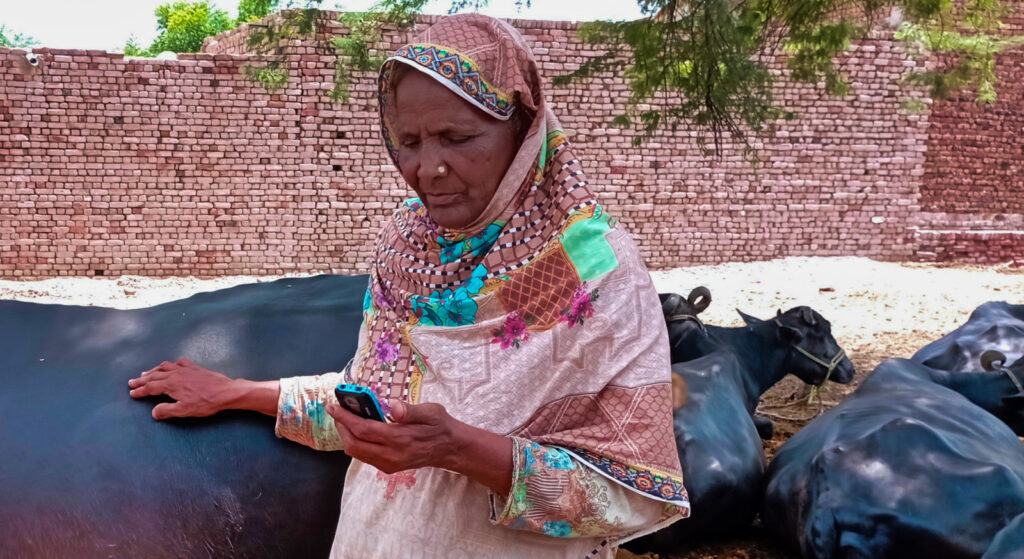
Introduction
Livestock husbandry and livestock-related products (dairy, meat, leather goods, etc.) constitute an important sub-sector of Pakistan’s agriculture sector: Pakistan is the fourth largest milk-producing country in the world1Sattar, Abdul, “Milk Production in Pakistan” PIDE Blog, pide.org.pk/blog/milk-production-in-pakistan , and the share of livestock products in the generation of foreign exchange is approximately 13%2Government of the Punjab, “Livestock Contribution” , livestock.punjab.gov.pk/livestock-contribution. As is the case in many smallholder economies, in Pakistan, women are largely responsible for the care of livestock and for the production of many livestock-related products, particularly dairy3Ibid..
In rural areas, livestock plays an outsize role in livelihoods, with the Punjab provincial government estimating that “livestock is an integral part (30-40%) of the livelihood of about 30 to 35 million rural farmers”4Ibid.. Livestock-related products, such as butter, eggs, meat, and animal fats (oils), contribute important nutrients for all households – rural and urban – and play a critical role in meeting the nutritional needs of rural children. Further, livestock contribute an important source of continuous income which can sustain poor rural households between seasonal crop-related revenues, and insulate them from shocks5Ahmad, Tusawar Iftikhar and Tanwir, Farooq, “Factors Affecting Women’s Participation in Livestock Management Activities: A Case of Punjab-Pakistan”, mpra.ub.uni-muenchen.de/93312/1/MPRA_paper_93312.pdf..
For these reasons and more, supporting the development and improvement of livestock farming can have a considerable impact on improving the livelihoods of Pakistan’s rural population, and can impact the livelihoods and status of rural women. We believe significant gains can accrue to rural farming families through the promotion of best practices to women. Improved practices can improve yields and minimize losses, leading to increases in income from livestock farming.
Many rural women are unaware of best practices that can optimize outputs associated with livestock, and access to information and economic opportunities can be constrained by cultural and geographic barriers. As documented elsewhere on this blog, digital extension services offer cost-effective and easily scalable solutions with very low marginal costs. In rural Pakistan, where many women rarely leave their homesteads, the portability of digital information offers additional advantages for navigating geographically and culturally hard-to-reach spaces.
Geographic and cultural constraints to attending in-person RCDS livestock training sessions were exacerbated by social distancing introduced to mitigate the COVID-19 pandemic. RCDS’s in-person activities were suspended in the initial months of the pandemic, but the utility of advisory information increased as rural households navigated new challenges in a time of escalated economic stress. It was at this time that RCDS and PxD initiated a partnership to deliver advice to livestock-rearing women in rural regions of Punjab province in Pakistan. This collaboration, supported by IFAD, provides customized and actionable digital information to livestock-rearing women. Combining PxD’s experience in delivering digital extension services to Punjabi farmers and RCDS’s extensive local knowledge and expertise, the service draws on demographic insights, and cultural practices to deliver information that is accessible, comprehensible, and actionable for recipients.
The resultant digital advisory service has proven to be an effective, cost-efficient, and scalable supplement to in-person training, and is now extended in the absence of COVID-19-related social-distancing constraints. The service demonstrated new advantages when unfamiliar disease- and climate-related threats subsequently impacted rural households.
The Service
RCDS’s experience and local trust in their services have been integral to the success of the initiative. Over the past two decades, RCDS has partnered with local, federal, and international institutions to build a significant rural network to promote and implement development programs to assist poverty-stricken segments of society in rural areas of Pakistan.
Advisory content was developed in partnership with local livestock consultants who were well-informed about local livestock issues and output-increasing best practices. The advisory information distributed by the service covers a wide array of topics, including disease identification, information about and access to vaccinations, disease prevention and remedies, practices to increase milk yields, and guidance on protecting livestock against climate-related shocks.
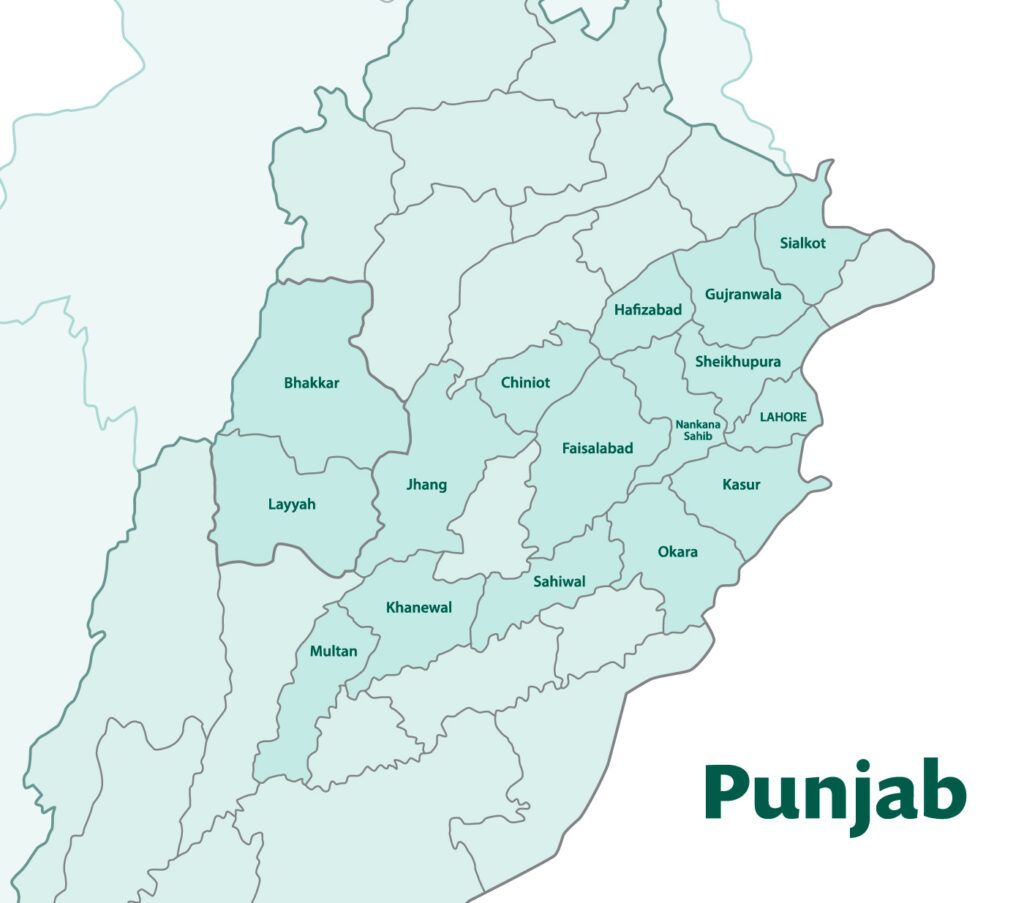
After conducting a baseline survey to systematically understand the informational needs of women farmers in four districts in Punjab, and the development of advisory information, PxD piloted digital services among 3,160 rural women associated with RCDS. The four districts, in which the pilot was concentrated, are among the poorest districts of Punjab, all of which are located in the south of the province. Given the success of the initial pilot, the service has subsequently been expanded to more than 50,000 livestock-rearing women in 16 rural districts of Punjab.
One of the key components that PxD assessed during the initiative was the extent of knowledge retention by participating women after they received the advisory. Pilot testing in the early stages showed that the advisory information was not only useful but was also retained for a significant period after it was delivered.
RCDS maintains a dataset of women who have either attended in-person sessions of livestock advisory or shown an interest in livestock advisory or have taken a microfinance loan for livestock farming. This data, and its quality, were instrumental in helping PxD deliver the advisory directly to the women via their phones. Furthermore, the data also contained the districts in which each woman resided. This was used to help decide in which of the two local languages – Punjabi and Saraiki – the advisory would be conveyed.
Advisory information is delivered through a voice call. A text message is sent 24 hours before the call to alert users that they should expect a call the next day. This is done to ensure that the advisory is received by women. A barrier highlighted by the baseline survey was limited access to mobile phones on the part of women in the region. Cultural and financial constraints make it far more likely that men have primary access to cell phones. Hence, the time allotted for the voice calls is set at a specific hour in the evening, so that the call is received in the evening when the family is no longer busy with agricultural activities, men are more likely to be home, and when family members can collectively listen to the advisory in their homes.
The voice call has local cultural music layered in the background, to assist the participant in developing trust in and comfort with the message. The information is delivered in the local dialect – Punjabi or Saraiki – to enhance understanding of and familiarity with the recorded message. Further, listeners are told that the advisory is from RCDS since it is well-known as a trusted organization in these regions. As a general protocol, to improve pick-up rates when the voice call is unanswered, another call is placed after a 15 to 30-minute interval.
Lumpy Skin Disease
A significant advantage of digital extension is the ability to send timeous information. This is particularly valuable to address and prevent viral diseases that can have a drastically negative impact on the well-being of the livestock.
In April 2022, Pakistan saw a viral outbreak of lumpy skin disease in cattle. The disease was transmitted between cattle via blood-feeding insects. The disease has a high virulence and fatality rate and killed thousands of cattle in the country.
A significant hurdle that seriously hindered timely prevention and actions to curtail the impacts of the infestation was the lack of baseline knowledge and awareness of the disease. Moreover, misinformation was rife, with misplaced rumors about negative effects of vaccines abounding. Many people mistakenly believed that it was the vaccines that were causing deaths among animals, when animals that had died were either already infected with lumpy skin disease, or were generally sick and should not have been vaccinated at the time.
Understanding these knowledge gaps, PxD and RCDS collaborated to provide timely information about the infestation. Initial infections were observed in the southern part of the country and slowly spread north towards Punjab province, where our users reside. PxD started providing information about lumpy skin before the disease had become widespread in the province.
Our farmer-users were given information about the disease and its virulence, how it is spread, and traditional preventative measures. Following that, to increase the survival rate of infected cattle, users of the service were advised to vaccinate their cattle as soon as vaccines became available. Participants were also informed about how to identify early signs of the disease on the animal.
Anecdotal feedback received by RCDS in the field suggests that the messages were very useful. Users with whom PxD surveyed reported that in many instances they were able to avoid fatal infections in their animals due to timely vaccines, even if their animals did get infected.

The Floods
In the summer of 2022, Pakistan witnessed firsthand the severe impacts of climate change. In March and April, the country experienced a crippling heat wave, followed by a record-breaking monsoon season in Punjab, Sindh, and Balochistan spanning June, July, and August. An unparalleled monsoon, coupled with unprecedented melting of glaciers in the north due to the initial heatwave, led to extreme flooding in rivers that flow from the north of Pakistan to the south. The floods are estimated to have impacted at least one-third of Pakistan, including the livelihoods of 33 million people.
Prior to the floods, the extreme heat waves had contributed to a general belief that floods were imminent. To counter the threat, the PxD team in Pakistan worked with RCDS to preemptively identify areas prone to flooding, and prepare advisory messages with useful information about managing floods, and adaptive strategies to protect assets and livelihoods.
A major problem with livestock is their slow mobilization, making them and their rearers prone to becoming flood victims. Timely warnings and regular updates via voice call advisory messages provided participants with information for ensuring the safety of their livestock during the floods. PxD and RCDS made use of their existing program to deliver instructions, warnings, measures, and assistance via voice call messages, to inform participating women and their families about floods and ways to protect themselves and their livestock.
Meeting today’s challenges
The advisory service designed by PxD, and delivered in partnership with RCDS, provided an effective method to deliver timely information to livestock farmers. Due to its effectiveness in the regions where it was being delivered, the advisory service was extended to address other unforeseen challenges, such as the virulent lumpy skin disease, and flooding.
In addition, our project has demonstrated the core strengths of digital communication: it is cost-effective, scalable, and capable of reaching regions and communities that are disconnected or hard to access due to difficult terrain, long distances, or cultural constraints.
Our advisory content was designed to deliver information in a manner that does not require the recipient to have prior knowledge, or education to understand the subject. The use of familiar dialects and carefully crafted messages made the information accessible, easy to understand, and ultimately very effective.
PxD aims to further extend the benefits of digital communication to support other low-cost interventions among rural communities of Pakistan. More specifically, feedback received from users has prompted PxD to further our partnership with RCDS to envisage interventions to support digital veterinary services. We are motivated to continue to harness the power of digital communication to facilitate more productive and resilient livelihoods in rural communities of Pakistan.
From confronting cataclysmic floods in Pakistan, to biblical pest infestations in east Africa, smallholder farmers are on the frontline of an escalating climate crisis. Poor farmers, whose livelihoods disproportionately depend on rainfed agriculture, are particularly vulnerable. The destabilizing impacts of a changing climate will drive many millions of farming families deeper into poverty.
At PxD, we work with millions of farmers to give them the information they need to make more informed decisions about unfamiliar and escalating challenges. We are honored that our MoA-INFO service in Kenya was chosen by the Global Center for Adaptation (GCA) as a case study to highlight the utility of digital information for assisting smallholder farmers as they struggle to adapt to climate change.
In the video below, funded and produced by GCA, Kuboka Maureen, a member of our agronomic team based in Kakamega, is joined by MoA-INFO farmers to explain how the service has assisted Kenyan farmers to navigate climate-related threats.
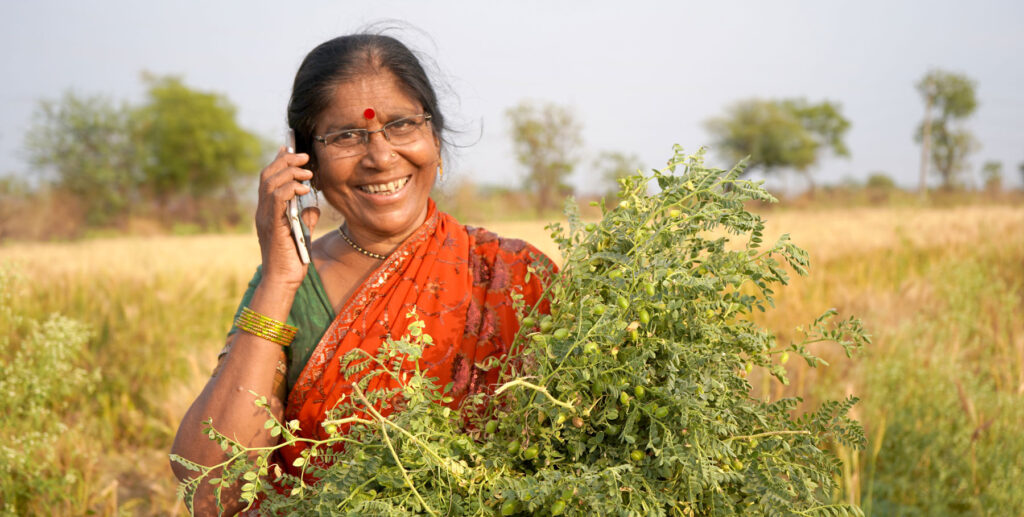
On 1 August 2022, PxD completed the transition of the management and operations of Ama Krushi – our largest digital service – to Tatwa Technologies Limited, a third-party firm that won a competitive government tender. This post reflects on Ama Krushi’s journey from concept to a fully-fledged digital advisory service providing customized agronomic advice to over three million farmers, and recounts some of the hard truths, lessons learned, and innovations uncovered.
The successful handover of Ama Krushi to Tatwa is bittersweet, marking the culmination of years of work to build a sophisticated digital extension service from scratch. But the transition also means the end of a remarkable journey and a farewell not only to a service we are justly proud of, but also to longstanding colleagues who have transitioned with the service to new management.
In 2018, PxD (then Precision Agriculture for Development) – in partnership with the Department of Agriculture and Farmer Empowerment (DAFE), the Bill and Melinda Gates Foundation (BMGF), and the Abdul Latif Jameel Poverty Action Lab (J-PAL) – launched “Ama Krushi” (“farmers’ friend” in Odia, the most commonly spoken language in Odisha State). Ama Krushi was envisioned as a digital farmer-advisory platform to deliver timely, customized digital advice free of charge to smallholder farmers in the state of Odisha via their mobile phones. Conceived as a build, operate, and transfer (BOT) project, its design envisaged the transition of the management of Ama Krushi to the government of Odisha at the conclusion of the implementation and scaling period. The partners imposed an ambitious target for Ama Krushi: by March 2021, the service would have leveraged research and evidence to build and scale a cost-efficient, statewide digital extension service to serve one million farmers.
As is often the case with well-laid plans, PxD’s journey was very different from what was envisioned in 2018. The initial transition timeline to transfer day-to-day management of the service in 2021 was revised as the impacts of the COVID-19 pandemic were felt.
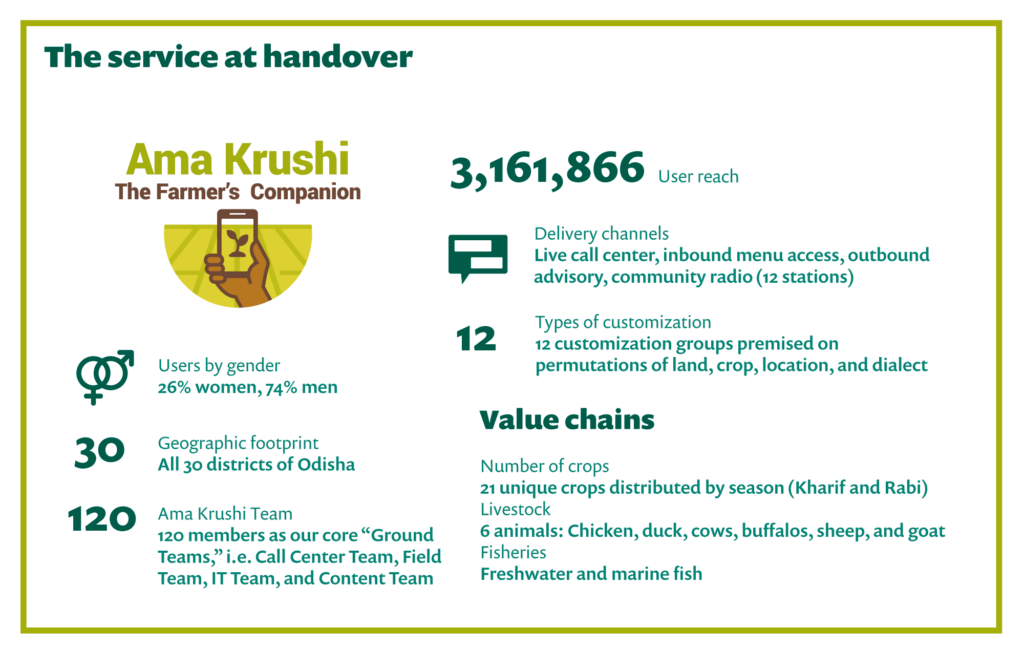
The formal transition ultimately commenced on 1 April 2022 with the initiation of an intensive capacity-building and transfer plan. Tatwa began operating Ama Krushi independent of PxD on 1 June, with continued technical support from PxD staff. Tatwa assumed full responsibility – with PxD becoming entirely hands off – on 1 August. At transfer, Ama Krushi was actively servicing over 3.1 million farmers.
The early days
During the first two years of project implementation, Ama Krushi grew to provide advisory and information for 16 crops across all 30 districts of the state of Odisha. After consenting to be registered, each farmer added to the service was profiled by enumerators. In profiling, a cropping profile for each farmer was created and was populated by our call center team or by our field team on the ground. An accurate profile enabled the service to direct customized content to each farmer, timed to align with critical decision points on the agricultural calendar.
In the early years, the team focused on building out Ama Krishi’s core service: an interactive voice response (IVR) push call service that delivered weekly advisory information tailored to each farmer’s profile information, and a complementary farmer hotline. By placing a missed call to the hotline, farmers received a free return call, enabling them to access a library of advisory information and frequently asked questions, and the option to leave messages to be serviced by agronomists via a recorded push call within 48 hours (typically fulfilled within 24). While any farmer could ask a question, only profiled farmers received weekly advisory.
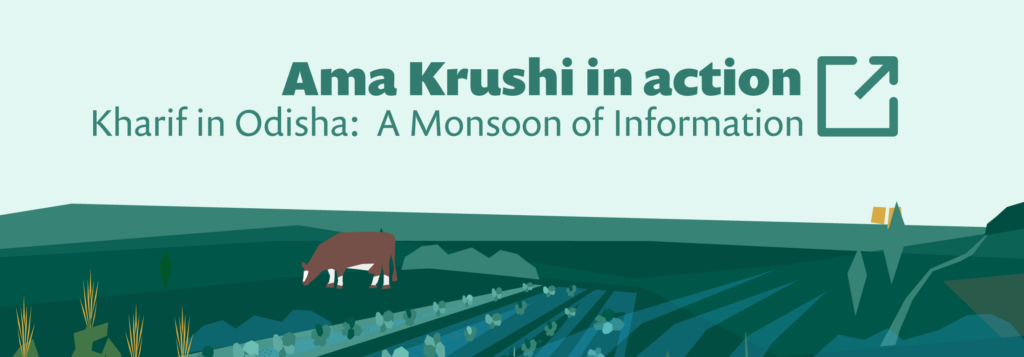
By analyzing trends in engagement and directly interacting with users during field visits and focus groups, we gather information to inform new products and service innovations that are relevant to the needs of users. Two prominent examples include the integration of Kitchen Garden Advisory, aimed at women who engage in subsistence farming, with our regular programming, and the expansion of our advisory to include non-crop-related value chains, specifically livestock and fisheries. During the first two years of operation, the Ama Krushi team explored different avenues for expansion while deploying A/B tests to iteratively improve modes of information delivery. At the end of 2019, Ama Krushi was serving over 620,000 farmers.
Similarly, in response to demand from farmers and our partners at DAFE, PxD added new digital channels to expand our reach to smallholder farmers. Radio remains an important medium for information dissemination in rural India. Accordingly, PxD piloted advisory dissemination via a local community radio station in early 2019. By September 2020, the pilot had evolved into a formal collaboration with the Community Radio Association of Odisha, with Ama Krushi broadcasting weekly advisory across 12 community radio stations. Community radio enabled us to reach many more farmers who were not registered on the service and advise them on how to register to receive the full suite of AK digital services.
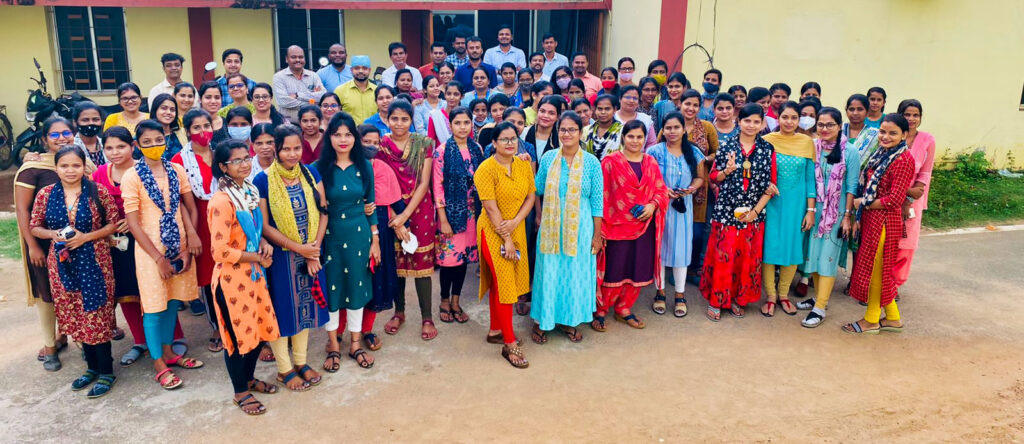
We also added a live call center (LCC) in December 2019 so that farmers could call in to be connected to a live agent. Given farmers’ limited digital literacy, we observed that many farmers had trouble navigating the inbound hotline. To make the service more accessible, DAFE requested that we build out an LCC to help reduce the technological burden on farmers. Propelled by the government of Odisha’s request to have all services offered by Ama Krushi available under one short code, the LCC was added to the main menu in February 2021 – now, should the farmer wish to, they can call 155 333 and choose whether or not to engage with a live agent to have their concerns addressed. This is supplemented by an escalation system that ensures that the farmer receives the answer on the spot or through a push call within 48 hours.
In early 2019, PxD also ramped up the training and onboarding of extension workers and other village-level champions, which allowed us to grow the number of agents that could sensitize farmers on the Ama Krushi service. It also meant that content could be disseminated via a hybrid model to these groups (e.g. IVR and district-level WhatsApp groups).
Scaling through the pandemic
At the start of 2020, in consultation with our colleagues at DAFE and BMGF, we formulated a transition plan to transfer day-to-day management of the service to a third party in 2021, as per the initial BOT agreement.
No sooner had the execution of the transition begun, however, than our plans were upended by the COVID-19 pandemic, which presented challenges that we (and most organizations across the world) did not have the experience or knowledge to contend with. We reconfigured our operations to continue offering the service while adapting our operations to work-from-home.
The move to a fully remote, work-from-home operation underscored a cornerstone advantage of digital extension services: the ability to operate at times and places that traditional extension services cannot reach. In the first month after the pandemic, we transitioned our hundred-strong call center team to work-from-home arrangements, established a system to service agriculture-related distress calls (for example, being stopped by police when taking perishable crops to market after the issuance of a statewide authorization communique) and questions from farmers during the nationwide lockdown, and assisted the government of Odisha to deliver key agriculture-related updates to remote areas. The Ama Krushi team demonstrated remarkable resilience, maintaining and then building their capacity to serve farmers. The Ama Krushi service was available every day of the nationwide lockdown and subsequent phases of physical-distancing protocols, .
Despite significant operational adjustments imposed by the pandemic, Ama Krushi surpassed its target of servicing one million farmers in November 2020, five months ahead of DAFE’s initial target. Bolstered by Ama Krushi’s success, the government of Odisha issued a directive defining new targets and goals in March 2021. With additional support from BMGF, we received approval to launch advisory channels to support livestock and fisheries on the Ama Krushi platform. The government of Odisha also revised the end goal of onboarding 1 million farmers by March 2021 to 2.5 million farmers by June 2021.
While these requests reflected the Odisha government’s faith in Ama Krushi and our team, the revised targets and deadlines presented challenges for the handover of the service. COVID-19-related concessions had allowed for the extension of the original transition timeline from March 2021 to September 2021, but the addition of livestock and fisheries went beyond the scope of the original agreement and required us to test, launch, stabilize, and hand over a new version of the service within six months.
Undeterred, the Ama Krushi team quickly commenced piloting and testing to support the development of livestock and fisheries advisory, launching the two new advisory channels in January and April 2021, respectively. Concurrently, we continued to leverage research and user feedback to improve the service and began preparing operations and management materials in preparation for the handover.

Collating and organizing information about the service and the platform operations was an extensive exercise that required the creation of a large vault of documents. These documents detailed how the service worked (even as the service continued to change), outlined a framework to facilitate capacity building to support the transition of workstream ownership from PxDs’ team to government officers, and created a learning agenda to document and monitor the transition and inform future efforts.
Transition
Coordinating with the government during the pandemic was challenging – understandably, as their focus had shifted to the resolution of pressing issues. Coupled with the adjustment to work-from-home arrangements and personnel changes in critical official roles, discussions, and decisions to guide the Ama Krushi transition slowed.
At a meeting in March 2021, the government committee, chaired by the then Principal Secretary, met to decide what form the Ama Krushi transition would take. Early considerations had included embedding government staff within the Ama Krushi team, but given the complexity of operations, the government indicated a strong preference for a procurement process to contract out management of the service to a third party, while retaining government oversight and ownership. Naturally, this development led to a series of internal considerations. What form would the transition now take? How would the third party engage with the government and the program? What would happen to program staff who had been trained with a view of being transitioned to government management? How would the service remain government-owned and -funded in the long term?
After exploring the route of procurement via impaneled agencies with the Government of Odisha, PxD and DAFE came to the conclusion that, given the size and complexity of Ama Krushi and its teams, the identification of a new implementing partner would require a full public procurement process facilitated by a request for proposals (RFP). 1An RFP is essentially an open tender:an advertisement for a service that the government requires (in this case, the management of the Ama Krushi program) is put out for a minimum period of time with a set of eligibility criteria. It invites bidders to submit a tentative budget and uses a careful scoring system to identify the best-qualified party for the task. In July 2021, the government published an RFP inviting candidates to take up the tender. The plan of transitioning the service in 2021 seemed unlikely.
The PxD team running Ama Krushi was funded by both BMGF and DAFE and comprised “ground teams” running everyday operations like profiling, content delivery, fieldwork, and IT maintenance, in addition to a dynamic data and management team. The RFP proposed a different model: the entire program would now be funded by DAFE, with the management team comprised of a Program Lead – to be filled by a government official – in charge of a program management team staffed by the organization identified through the tender, who in turn would manage the work of the ground/operational teams. We had expected that the ground teams would remain in place given that they are critical for program continuity, but there was no guarantee that the new entity would absorb the existing operational team. Suddenly, the future of our 120-people strong operational team looked uncertain.
Handover to Tatwa
Given the repeated delays and shifting parameters of the transition, we agreed with DAFE and BMGF to further extend the transition timeline to 31 March 2022.
At the conclusion of the RFP process, the government appointed Tatwa Technologies Limited as the third-party firm to take over Ama Krushi’s management and operations. Following the announcement, PxD facilitated an extensive capacity-building program premised on in-person workshops and intensive shadowing. Tatwa wisely chose to retain the program’s existing ground teams, ensuring that Ama Krushi’s operations would run smoothly, with little to no inconvenience to Ama Krushi’s now 3.1 million farmers. On 31 May 2022, PxD successfully transferred the day-to-day management of the Ama Krushi program to Tatwa Technologies. After an additional two months of technical support, PxD is no longer involved in the delivery and development of Ama Krushi’s services.
Needless to say, building and then handing over the program has been an immense learning experience. Odisha farmers relied on traditional knowledge for generations to navigate challenges associated with drought, cyclones, and other input-based complexities. Ama Krushi attempted to complement this traditional knowledge with an agricultural digital extension service capable of delivering credible, scientifically validated, and evidence-based digital information to improve decision-making, agricultural productivity, and smallholder livelihoods. We scaled a program from 50,000 farmers in 2018 to over three million in 2022, from one crop to 29 value chains spanning crops, livestock, and fisheries – all with the support of a growing team of content experts, field coordinators, and surveyors. Today, we can proudly say that Ama Krushi is an entirely government-funded and government-owned service running at scale. The transition formally concluded on 31 July 2022.
A fond farewell
Building a successful digital extension service like Ama Krushi and overseeing its successful handover was the product of years of hard work and effort. The learning curve has been steep, with unexpected accelerations in the ascent, as well as detours and changed plans. No success would have been possible without the active and sustained support of the BMGF and all of the government officials from DAFE. As a team, we learned to consistently check our assumptions and biases, systematically plan for contingencies, tailor our communications, manage expectations, and make ourselves more attuned to context-specific nuances. We will catalog these learnings as part of the post-transition monitoring exercise to inform future transition efforts (both internal and external) and provide insights for different use cases. We hope to leverage active learning from this transition to identify best practices for laying a foundation for a successful transition during the build and operate phases of development, and for successfully executing transition as the fulfillment of the build, operate, and transfer design.
Uzoamaka Ugochukwu, PxD’s Nigeria Country Launch Manager, was selected to present a “tech demonstration” at the 2022 rendition of the Global Digital Development Forum. The demonstration presents how PxD leveraged our in-house tech platform, Paddy, and our experience implementing digital advisory services to rapidly build, deploy and scale services to 107,000 smallholder farmers in Nigeria.
PxD’s forthcoming 2021 Annual Report will be conveyed primarily via video using a similar design to that deployed in this video. Watch this space!
Precision Development (PxD) has completed a landscape analysis to more systematically understand the challenges faced by users of the Coffee Krishi Taranga (CKT) service, with a focus on three core areas, namely, sustainability, market linkages, and gender. This work was funded by a grant from the Walmart Foundation.
As part of the landscape analysis, we conducted multiple rounds of farmer interviews, an extensive review of the literature, an analysis of our existing farmer database, and interviews with sectoral experts. In this blog, we share some key findings and information about what we’re looking to do next.
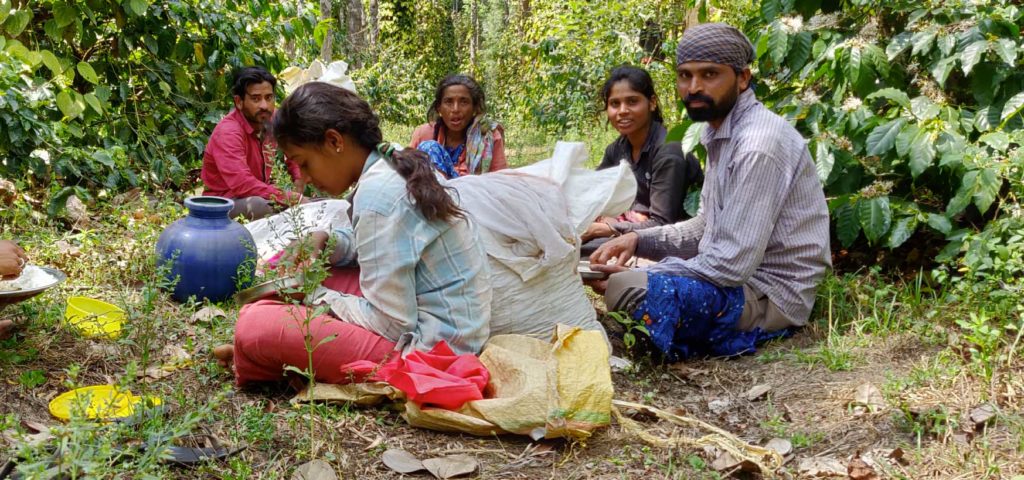
Coffee Krishi Taranga
Since August 2018, PxD has partnered with the Coffee Board of India to provide the CKT service to coffee growers. The CKT service is modeled on PxD’s flagship two-way Interactive Voice Response (IVR) service, which comprises an outgoing service that provides regular advisory to growers on their mobile phones and an inbound hotline that farmers can call to access free information services, including market-related information, and leave messages to be answered by agronomists. As of April 2022, the CKT services approximately 74,000 coffee growers across the states of Karnataka, Tamil Nadu, and Kerala. The team plans to expand the reach of the service to growers in Andhra Pradesh soon.
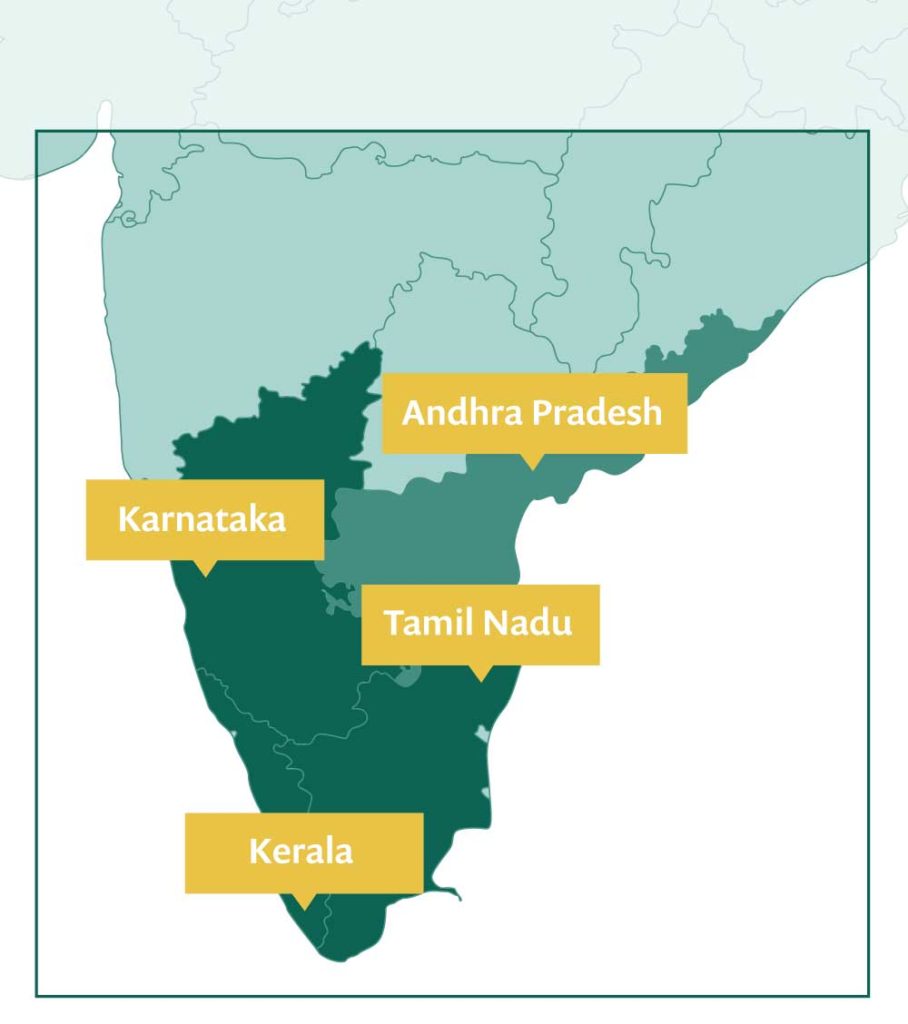
Key findings
Sustainability
Coffee growers in India face multiple risks linked to weather unpredictability, a challenge that has been exacerbated by climate change. Coffee is a sensitive crop, and heat and rainfall are widely considered to be the two most important factors for coffee growth1Haggar, J. and Schepp, K. (2012). Coffee and Climate Change Impacts and options for adaptation in Brazil, Guatemala, Tanzania and Vietnam. National Resources Institute Working Paper Series: Climate Change, Agriculture and Natural Resources, [online] No. 4, pp.1–50. Available at: https://www.nri.org/publications/working-paper-series/4-coffee-and-climate-change/file [Accessed 14 Sep. 2021].. In farmer interviews conducted in September 2021, 92% of farmers (N=83) said they had faced a weather-related challenge in the past year2Haggar, J. and Schepp, K. (2012). Coffee and Climate Change Impacts and options for adaptation in Brazil, Guatemala, Tanzania and Vietnam. National Resources Institute Working Paper Series: Climate Change, Agriculture and Natural Resources, [online] No. 4, pp.1–50. Available at: https://www.nri.org/publications/working-paper-series/4-coffee-and-climate-change/file [Accessed 14 Sep. 2021].. Weather can negatively impact the cultivation of coffee in a variety of ways, including crop damage at sensitive times such as blooming3Pokiya, T. (2021). Interview: Agronomist, PxD. 16 Jun. , increased incidence of pests and disease, increased soil erosion, and more.
What are we doing?
One obvious solution to mitigate the risks of weather variability is weather forecasts, in particular providing customized weather forecasts or real-time weather information, potentially coupled with relevant agronomic recommendations. However, access to high-quality forecasts is limited. In our farmer interviews, only 16% (N=73) said they have access to forecasts4 Krishi Taranga coffee growers (2021). Qualitative farmer surveys: Round 5. 24 Sep.. Our team is currently in the process of putting together a pilot to test the impact of providing customized weather forecasts on key agricultural practices (if you’re interested in learning more about PxD’s weather-related learnings, check out this recent series of blogs).
“The weather imbalance leads to severe black rot and we cannot use spray at the right time.”
Interview with D.S. Sathish, Basrikatte, Chikmagalur
The increase in average temperature and erratic rainfall also exacerbates risks associated with certain pests5 Watts, C. (2016). A Brewing Storm: The climate change risks to coffee. [online] The Climate Institute, pp.1–14. Available at: https://www.juntospelaagua.com.br/wp-content/uploads/2016/09/Pesquisa-sobre-caf—The-Climate-Institute.pdf [Accessed 14 Sep. 2021].. The impact of climate change on pests varies, but overall heavy rain and warmer temperatures are likely to increase the conditions in which several pests thrive. These pests can cause varying levels of damage — some can be devastating, resulting in crop losses of up to 70% if not treated timeously and effectively.6Machenahalli, S., Ranjini, A. P., Madhu S., Giri, Sudha M., Daivasikamani, S. and Surya Prakash Rao N. (2019). Disease of Coffee during monsoon season and their management. [online] Planter’s World, May, pp.4–7. Available at: https://krishi.icar.gov.in/jspui/bitstream/123456789/23682/1/coffee%20disease%20during%20monsoon.pdf [Accessed 14 Sep. 2021].
To explore ways to provide more targeted and actionable recommendations for pest management, we ran an A/B test in November 2021 that looked at the impact of sending multiple reminders on farmers’ knowledge and adoption of high impact practices. We focused on the treatment of white stem borer, an increasingly common pest for coffee growers in India. The results from this test will be shared shortly!
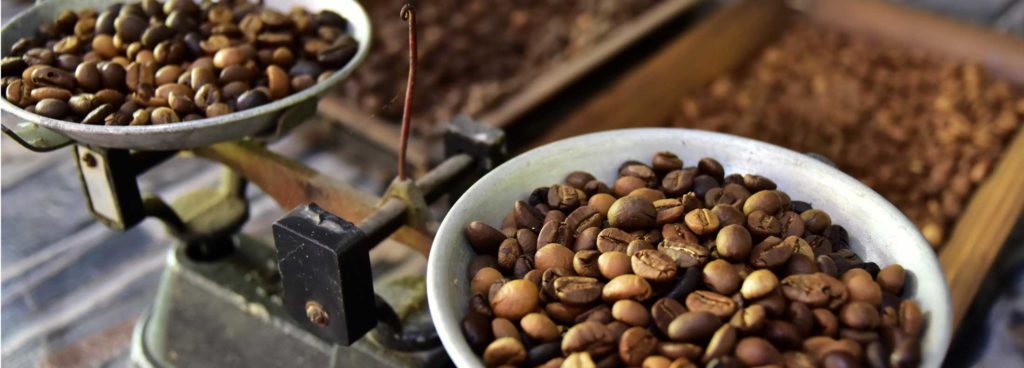
Markets
Smallholder coffee growers sell their produce in fragmented and exploitative local markets. A survey from Chikmagalur and Hassan districts (Karnataka) found that over 90% of growers sold their produce at the farm gate7 Babu, P. (2019). Value Chain Upgrading Strategies for Integration of Indian Small Coffee Growers in Global Coffee Value Chain. Economic Affairs, 64(4).. In our interviews, we found approximately 50% of farmers (N=140) sell their coffee to local traders or markets8Krishi Taranga coffee growers (2021). Qualitative farmer surveys: Round 1. 6 Jul.. There are several reasons why these selling conditions are less than ideal. This includes a lack of infrastructure: smallholders, who deal with relatively small amounts of coffee, usually sell directly to a local trader or agent who pays them on the spot and bears the costs of transporting the coffee to the curing agent. This is where smallholders often lose value on their coffee as local traders set the price for the farmers’ produce.
Another concern is high price variability and lack of transparency. Local traders set coffee prices according to international coffee trends. When buying from farmers on the ground, this price is adjusted based on the quality of the product, which is measured by moisture and out-turn tests. However, the degree to which prices are adjusted based on these metrics is not always clear, leaving farmers feeling frustrated.
“Traders will not buy coffee at existing coffee prices. When traders provide information about prices [they say] it will be more, but [when it comes to] selling the coffee, traders fix a certain [lower] rate and give the unnecessary reason that the moisture content is not good.”
Interview with A.G Nannaiah, Virajpete, near Madikeri
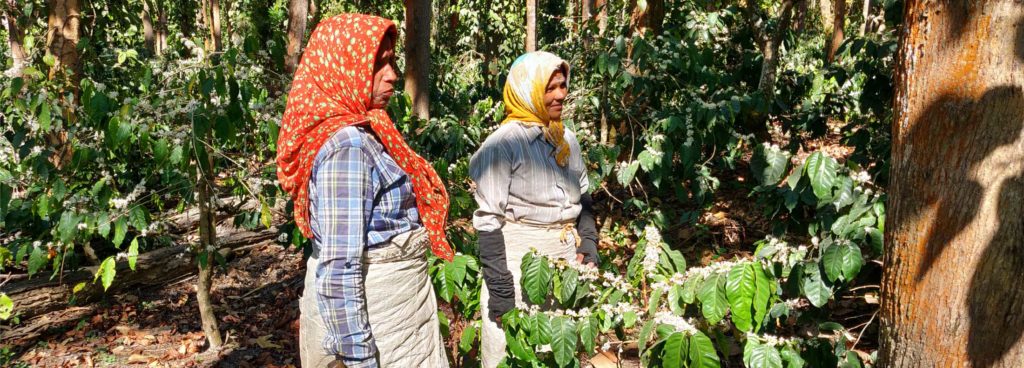
What are we doing?
As part of the CKT hotline, we offer a free price feature which farmers access to listen to daily local and international price information. This is our most used feature, indicating interest in price information. However, overall usage of the hotline is low. We are currently exploring alternative ways of delivering price information to our farmer base, in the hope of reducing frictions and increasing the use of market price tools and information. Lines of relevant inquiry include exploring the use of WhatsApp and SMS to provide price alerts.
To explore ways of reducing price variability, which contributes to income volatility and uncertainty, the PxD team is running a market linkages pilot with the Sustainable Trade Initiative (IDH) in Karnataka. IDH will facilitate contracts between interested buyers and smallholder growers, in which buyers commit to purchasing produce (granted it meets certain quality conditions) at a fixed price. PxD will support growers in meeting these conditions by disseminating relevant agricultural information.
Gender
“My wife visits the estate whenever it is necessary, for example if I am away from the station she looks after things, and after the harvest and the coffee is dried, she weighs it and keeps a record of the quantity of coffee available after it has dried.”
Interview with Virajpete Madhayya, Madikeri
As per India’s Census 2011, coffee plantations were major employers of women workers in Karnataka; out of a total of 480,000 average daily workers employed in coffee plantations, 62% were women. Women appear to be employed for specific activities such as coffee picking, weed management, and applying manure and chemical fertilizers 9Joy, C.V. (2004). Small Coffee Growers of Sulthan Bathery, Wayanad Kerala Research Programme on Local Level Development Centre for Development Studies Thiruvananthapuram. [online] Centre for Development Studies, Kerala, India: Centre for Development Studies, pp.1–43. Available at: http://www.cds.ac.in/krpcds/publication/downloads/83.pdf [Accessed 29 Oct. 2021].. In our interviews with women, we found that women are heavily involved in specific coffee-related activities, including weeding and coffee picking. While women are generally not primary decision-makers for most activities, they appear to be included in the decision-making process. We also learned that women are often part of community groups including self-help groups like “Swasahaya Sangha” (for more information, see our blog post on women’s groups).
What are we doing?
We would like to explore the role of women’s groups and whether these can be leveraged to increase engagement with, and provide relevant support to, female farmers. Evidence from our other programs and the literature suggests that women can increase their collective knowledge and engagement through participating in community groups. The fact that many women in our service are generally involved in day-to-day decision-making suggests that there is room to cater specifically to the areas in which women work. This includes exploring value chains adjacent to coffee cultivation where women may have more involvement, for example, intercrops like spices.
Looking forward
The landscape analysis helped our team gain a broader understanding of the range of challenges and opportunities that exist within the coffee sector in Southern India. In doing so, we have been able to strategize and set evidence-based priorities. This includes focusing on addressing weather-related risks through a pilot to test the impact of providing customized weather forecasts to coffee growers, and a market-focused pilot with IDH.
At the same time, we are also scaling our program with the support of the Walmart Foundation. This includes expanding to another coffee-growing state, Andhra Pradesh. Coffee growers in Andhra Pradesh are different from those in Karnataka, as they are primarily based in tribal regions and practice more traditional farming. We are excited to learn more about coffee growers in this region and adapt our existing service to address their unique information needs.

Precision Development (PxD) recognizes that the informational needs of poor women farmers, and the challenges they confront, are unique. As a consequence, our services must be tailored to reach and be relevant to the needs of women users. Driven largely by the onboarding of women active in livestock-related activities, the number of women farmers active on platforms built by PxD increased by approximately 46% over the course of 2021. This included the onboarding of over 150,000 women farmers to our Ama Krushi (AK) service, which we deliver in partnership with the Government of Odisha, India. As we mark International Women’s Day, we reflect on efforts we have made to improve our understanding of gendered divisions of labor and bargaining power within Odishan smallholder households, and steps we are taking to assist women farmers make more informed decisions.
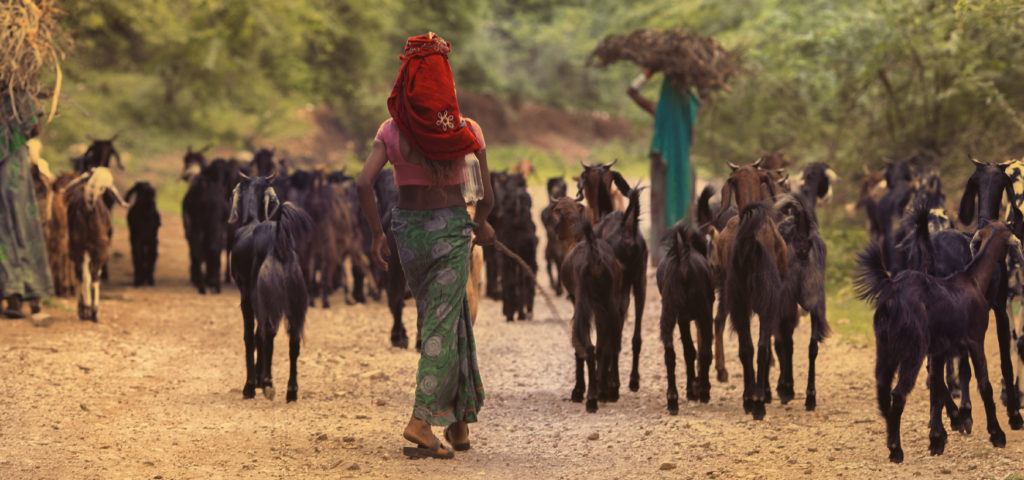
Scoping work undertaken by PxD suggests that women farmers spend more productive hours on livestock farming than men. However, women farmers disproportionately lack access to mobile phones and, by extension, digitally conveyed information. Perhaps the largest impediment to increased engagement with PxD’s advisory on the part of women farmers is access to information, and patterns of information sharing within households. This could have knock-on effects that undermine women’s productivity and bargaining power within the household. To further understand these dynamics, we explored if sending messages encouraging information sharing within households can assist in breaking this cycle.
The motivation
Gendered roles in livestock farming
In June 2021, we conducted a survey to improve our understanding of gender roles in livestock farming in Odisha. The sample consisted of 5,354 AK farmers who have subscribed to livestock-related advisory, practice cow-rearing, and had received at least one livestock advisory message via the AK service. The sample included equal numbers of male and female users and was stratified by the farmer’s district. Of this sample, we successfully surveyed 1,475 AK farmer users.
We found that, on average, women AK users allocate more time to livestock rearing and household chores than male AK users (Table 1). Relative to male AK users, women spend less time on cropping activities and on other non-livestock-related income-generating activities.
The survey also found that men AK users are significantly more likely to perform—and be the primary decision-maker for—livestock-related tasks that require travel outside of the home. These types of activities include veterinary visits, purchases of livestock-related inputs, selling milk, and sourcing fodder. Women, on the other hand, are more likely to be involved in livestock-related activities performed at home, such as cleaning sheds, feeding, and milking animals. Given the heavy involvement of women farmers in livestock-related activities, it is important that livestock advisory broadcast via our AK service is communicated to women household members if it is to be practical.
Importantly, many income-related improvements in livestock outcomes—such as increasing milk yields and successful breeding—depend on the coordination of multiple tasks performed by both men and women within a household. For example, successful breeding requires the completion and timely sequencing of tasks and processes, including the provision of sufficient nutrition, deworming, heat detection, and accessing artificial insemination (AI) services. To achieve these ends, it is important that livestock advisory reaches both women and men in the household, and that intra-household communication is sufficient to coordinate improved livestock outcomes and household welfare maximization.
Barriers to information for female farmers
Reaching female farmers through mobile phone extension services is challenging as men farmers are more likely to be the primary owners of mobile phones in the household (OECD, 2018; Baroni et. al., 2018). Evidence suggests that women registered as subscribers to PxD’s mobile advisory services have shared access to phones and male partners are the devices’ primary users. PxD uses polling surveys to maintain and improve quality service delivery, and to source feedback from users. Women AK users polled for our May 2021 livestock survey self-reported lower pick-up rates than male respondents. However, actual outbound AK administrative data does not reflect a gendered disjuncture in pick-up rates. An explanation of this could be that the household member who picked up the phone when an AK call was placed to a women farmer was not the registered woman user. Similarly, during this gender survey in Odisha, we asked the respondent who picked up the phone if they were the registered AK user. In the case of registered women AK users, someone else picked up the call 12% of the time, compared to only 5% in the case of registered men AK users. This difference is statistically significant at the 1% level. This suggests that when a phone is being shared, registered users that are women have less time with the phone than men. Given the greater engagement of women in livestock-related activities, this gendered barrier in mobile phone extension services is a significant challenge.
To gather more evidence on AK users’ individual access to mobile phones, we asked about a quarter of the AK users in the Gender Scoping Survey (n=370) about their typical access to mobile phones between 6 a.m. and 9 p.m. every day. Women AK users reported less availability at all times of the day (Figure 1). However, the difference is only statistically significant at the 10% level for the 3 p.m. to 4 p.m. period (both in the full sample and the married-only sample). Due to the smaller sample size, we may be underpowered to detect other differences.
Figure 1: Gender differences in individual access to phone
Interestingly, when we restrict the analysis to household heads only, women report higher average access to their mobile phones than men. The Gender Scoping Survey finds that the time-use patterns of women heads of households closely follow those of men heads of households (Table A1), there are a few possible reasons for this deviation in self-reported access to mobile phones. A possibility is that male heads of households are more likely to share their phones with their spouses or children. By contrast, the Gender Scoping Survey found that women heads of household are typically unmarried (or widowed, separated, or divorced) and therefore may not need to share their phones as much as men heads of household.
Consistent with the evidence above, the Gender Scoping Survey finds that men AK users are significantly more likely to cite Ama Krushi as a primary source of livestock information than women AK users (Table 2), while the polling survey finds that women AK users are significantly less likely to answer knowledge questions based on livestock advisory sent in the month preceding the survey correctly.
Importantly, AK users seldom cite their spouses as a source of livestock information or as someone they discuss new livestock information with, a gap in intra-household information transfer that PxD could potentially influence. Improving intra-household communication can potentially increase the reach of PxD’s advisory to existing registered women AK users who may not be picking up the outbound advisory, but also extend the reach of our advisory to the wives and women children of men registered as AK users on the livestock service.
Adoption: Individual vs joint access to information
To better understand intra-household dynamics of information transmission and adoption, we asked respondents to the Gender Scoping Survey if they find it easy to convince their spouses to adopt new livestock practices when they receive such information. Of the respondents, 76% replied yes to this question, and we found no significant differences by gender. This percentage increased to 90% when we asked if listening to the advisory jointly with their spouses on the phone’s speaker would make it easier for them to adopt the recommended practices. A gendered analysis of this increase did not detect a statistically significant difference between men and women users.
Therefore, we find suggestive evidence that getting livestock recommendations to female farmers is the primary barrier to increasing the benefits accruing to our digital advisory. When women farmers receive advisory, they may be just as likely to influence adoption decisions as men farmers. Additionally, increasing the shared knowledge of the spouses has a greater potential to increase adoption rates than individual access to information.
Calibrating solutions
The phone’s speaker
One possible solution to reach more women farmers and promote information sharing among spouses is to encourage respondents who pick up advisory calls to use their phones’ speakers to listen to the advisory with other household members. We wanted to pilot a nudge to male livestock farmers to listen to advisory messages with their speakerphone turned on with other household members engaged in livestock-related activities. However, we first needed to know if farmers could use their phone’s speaker. We conducted a speakerphone feasibility survey to understand:
- Whether farmers can use their phone’s speaker by themselves.?
- If not, can we deliver simple instructions during the phone call so that farmers can use the phone’s speaker?
- Whether we need to build in a time allowance for farmers to activate their speaker and listen to advisory with their household members.? If so, then how much time?
- Whether farmers are willing to use their phone’s speaker and listen to the advisory with other household members.?
Of the 90 respondents who consented to the survey, 76.67% could turn on their phone’s speaker without any instructions (67.92% of feature phone users and 89.19% of smartphone users). Following simple instructions on how to use their speaker, 84.44% of respondents could do so. Overall, 89.19% of respondents were able to turn on their phone’s speaker within 10 seconds of being asked to do so, and of those, 96.2% were willing to use their phone’s speaker to listen to future AK advisory with their family members. As a consequence we are confident there are no large technical or aspirational barriers to adopting the nudge and we moved to pilot it in different forms.
Assessing potential interventions
These results encouraged us to test nudges in three ways for one month:
- A separate IVR nudge asking users to call into our inbound service for joint-listening over their speakerphone (n=600);
- A text 20 minutes before the weekly livestock advisory asking them to turn on their phone’s speaker and listen to the advisory with members of the household involved in livestock-related activities (n=500);
- An additional script at the start of the weekly livestock outbound with the same nudge as in Method 2 (n=500).
All the nudges were sent between 6 and 8 pm based on the findings on joint availability in the gender survey. Before implementing an A/B test to measure the effectiveness of these interventions, we conducted small pilots to select the most promising methods.
In the pilot, we did not find that nudging farmers to use the inbound services (Method 1) was very successful. We sent a nudge call to 600 farmers, asking them to dial a toll-free number to listen to the livestock advisory on the speakerphone with their family. A total of 12 people (and 14 total calls) dialed into the service within a week of the nudge, but none accessed the feature to listen to the livestock advisory. While this does not eliminate the possibility that nudged farmers discussed the call’s content with their spouses, we did not pursue this method to achieve the specific objective of joint listening.
For farmers who were nudged through an SMS (Method 2), using a short survey, we found that only 4% of respondents recalled the nudge’s content (n=126). We concluded that this method was unlikely to translate into increased joint-listening or improved knowledge and adoption.
Using another short survey, we found that farmers who were nudged in the introduction of the weekly livestock outbound advisory (Method 3) were 22 percentage points more likely to report having listened to the advisory message jointly with household members than those who received the regular outbound advisory (ntreatment = 61; ncontrol=45). As this method showed the most promise, we conducted an A/B test deploying it to 17,000 farmers over ten weeks starting in late October. We are currently reviewing data from this test and will share the learnings when they are available.
The authors would like to thank Qi Xue, PxD Intern, who offered valuable assistance in executing the surveys and preliminary analysis underpinning this post, as well as Niriksha Shetty, Tomoko Harigaya, and Otini Mpinganjira for their insights and guidance.
Appendix:
Precision Development (PxD) leverages needs assessment research to inform our agricultural extension services, and we survey our farmers to gauge their opinion of our services. Sourcing information from farmers gives us direct insight into the challenges and opportunities farmers face. We use these insights to improve the design of our services and the content of our advisory messages in an effort to align them most closely to farmers’ informational needs.

Through the course of 2021, as we designed and rolled out a new advisory service for farmers in Nigeria, we conducted five surveys to inform more evidence-based decision-making:
- Baseline survey (Jan 21)
- Dry season feedback survey (7th April)
- Wet season feedback survey (3rd August)
- Wet mid-season adoption and knowledge survey (20th August)
- End-line survey (December – analysis is ongoing)
Having a clear line of sight into the needs of farmers has been critical as the COVID-19 pandemic has evolved and created new and shifting challenges for farmers in remote areas.
At PxD we believe the information revolution and the spread of mobile technology to people living in poverty offer unprecedented opportunities for increasing access to information at scale and at a very low cost. We promote digital information-sharing systems to distribute quality, actionable and targeted information. By obtaining regular feedback from farmers through research in behavioral economics and social learning our services are improved to encourage the adoption and assimilation of practical information and improved or adapted production practices during the COVID-19 pandemic.
Gathering Insights on Farmers’ Needs
Utilizing an emergency grant from the International Fund for Agricultural Development (IFAD), PxD began working in Nigeria in November 2020 – eight months after the World Health Organization’s assessment of COVID-19 as a “pandemic”. PxD’s initial service, delivered during the dry season, reached more than 5,000 smallholder farmers within three months of the program’s launch. The service was then scaled to serve more than 100,000 users during Nigeria’s primary growing season, the wet season. PxD collaborated with the Federal Ministry of Agriculture and Rural Development (FMARD) to implement the Nigeria Rural Poor Stimulus Facility (RPSF), funded by the International Fund for Agricultural Development (IFAD). IFAD’s funding objective was to assist Nigeria to mitigate the impact of COVID-19 on smallholder farmers and its goal was to insulate domestic food supply by supporting access to affordable inputs and advisory to sustain production.
We believe that gathering baseline information from farmers about their needs was a critical factor that contributed to the success of PxD’s digital advisory service in Nigeria. We conducted a baseline survey in January 2021 to collect information on:
- Farmers’ socio-economic, demographic, and institutional characteristics;
- Their knowledge about dry season cultivation of crops and Good Agricultural Practices (GAPs); and
- Their perception of and willingness to receive mobile advisory services.
The survey interviewed 254 farmers randomly selected from a database of over 5,000 farmers. Findings from the baseline survey showed that 95% of the respondents indicated they would be interested in planting during the dry season. The remaining five percent identified lack of water and access to land as major barriers to engaging in any planting in the dry season. The survey also revealed that a lack of appropriate inputs, pests and disease problems, personal preferences, bad harvests, distance from water, and knowledge gaps are important challenges for the smallholder farmers.
Listening to the Farmers from the ‘Get-go’!
At PxD, we prioritize offering our users valuable and practical information to change or improve farmer behaviors and farm productivity. We do this by providing information customized – wherever possible – to a farmer’s location, market conditions, and personal characteristics. To calibrate our systems effectively, it is essential that we hear from the farmers themselves to understand their needs as they relate to their socio-economic realities. The results of our dry season baseline survey provided useful insights about farmers’ crop choices as well as their previous or existing crop practices. This information was vital for informing our product development and service delivery.
Only 56% of farmers surveyed during our baseline assessment had ever attended any training or workshops on crop production techniques. The survey also revealed that rice was the preferred crop for the dry season, followed by onions, tomatoes, and other vegetable crops. These and other findings helped us develop recommendations for specific topics, crop value chains, and farmer groups.
While just over half of farmers surveyed at baseline had experienced some kind of extension outreach, the advisory content received varied. For example, fewer than 50% of farmers had received training on GAPs such as:
- Weed management;
- Harvest and postharvest handling;
- Water management;
- Nursery establishment;
- Transplanting; and
- Input selection.
Whereas more than 50% had received training on:
- Pest and disease management;
- Fertilizer application; and
- Land preparation.
Importantly, the team also learned that fewer than 50% of the respondents had applied any of the GAPs or any other training they had received.
Monitoring Farmers’ Engagement and Feedback
One crucial aspect of our work at PxD is to gather evidence on the impact of our services on smallholder farmers. We are a learning organization that rigorously tests our services through experimentation and research. We have a high level of flexibility to adapt to the complexities of the various geographies where we work. Regular monitoring and evaluation of our interventions help us understand how our services are impacting our users and give us early insights into potential problems. PxD incorporates insights from behavioral economics, human-centered design, and social learning theory, and uses A/B testing and data science to identify what types of information and delivery mechanisms work best for our users.
In Nigeria, a feedback survey was conducted at the end of the 2021 dry season to assess farmers’ perceptions and use of the push call services, and to analyze factors that influenced their engagement with the service. The sample comprised 700 farmers randomly drawn from the seven states where the service was provided (Borno, Jigawa, Katsina, Kebbi, Sokoto, Yobe, and Zamfara). The sample distribution was 500 farmers from the ‘high participation’ group (with a more than 50% average listening rate) and 200 farmers from the ‘low participation’ group (with a less than 50% average listening rate). The survey results indicated that 88% of respondents, or a member of their family, recalled listening to any of the push call messages, while 86% reported “continuing to listen” to the calls (a proxy for continued engagement). This was particularly significant as it was the first season of the PxD program in West Africa.
Furthermore, a knowledge and adoption survey conducted in August, during the wet season campaign, indicated that 85% of respondents reported adopting at least one GAP, while 95% of respondents correctly answered one or more of the five knowledge questions asked in the survey. The survey also measured service satisfaction. Analysis of the survey results revealed a positive net promoter score of 39 (on a scale of -100 to 100), indicating that a majority of respondents (53%) said that they were likely to promote the service to other users, while only 14% of the sample reported being unlikely to recommend it or continue using the service.
To achieve behavioral change, the information conveyed should be accessible and of practical use to rural farmers. Ninety-four percent of respondents to the wet season feedback survey answered ‘Yes’ when asked: Were the messages clear and loud enough so that you could understand their content? In addition, 96% confirmed that they or a household member adopted the agronomic advice during the planting season.
Research shows that access to extension services is a key driver of technology adoption. Farmers are usually informed about new technology and its effective use by extension agents (Genius et al., 2010). Furthermore, the extension agents form a link between the researchers and users of the information, which helps to reduce transaction costs incurred when passing on the information about the new technology to a large heterogeneous population of farmers (Genius et al., 2010).
However, in-person extension services are expensive and time-consuming to deliver, and very difficult to scale. One can’t copy-and-paste trained extension agents, or their means of transportation, or guarantee that when extension agents make contact with a farmer the information they carry with them will be temporally valuable or practical. As evidenced by feedback from our farmers, very few Nigerian smallholder farmers have benefitted from extension services in the past. Feedback from farmers suggests that PxD’s model of digital agricultural extension in Nigeria, implemented in collaboration with partner organizations to maximize scale and at very low costs per farmer served1 Our Nigeria service was delivered at an average annual cost of $3.45 per farmer served, which compares extremely favorably with the costs of in-person extension services. With further scaling, we expect this number would fall further, and more closely align with PxD’s average cost per user served which at the time of writing was $1.61 per user per year., was considered by farmers to be valuable and relevant. Many farmers reported implementing the advice we broadcast to them. Digital delivery channels meant that we were able to deliver extension services under pandemic conditions when human movement and personal interactions were limited or prohibited.
The success and rapid scaling of our Nigeria service were built on strong partnerships, a portable and customizable in–house technology platform, and a service delivery model that we constantly update with information sourced from the farmers we serve, the results of surveys and experimentation, and rigorous evidence on the impact of our work. We look forward to building on our Nigerian successes and further assisting farmers in need as they confront wide-ranging challenges in very difficult conditions.
Acknowledgement
We would like to acknowledge the RPSF financial support of IFAD. Many thanks to the Nigerian team for their collective effort in drafting this post, and Emmanuel Bakirdjian, Theresa Solenski, Moira Levy, and Jonathan Faull for their contributions.
References
Balana B.B., Oyeyemi M.A., Ogunniyi A.I., Fasoranti A., Edeh H., Aiki J., and Andam K.S. (2020). The effects of COVID-19 policies on livelihoods and food security of smallholder farm households in Nigeria: Descriptive results from a phone survey. IFPRI Discussion Paper 1979. Washington, DC: International Food Policy Research Institute (IFPRI). https://doi.org/10.2499/p15738coll2.134179
Mungai L.M., Snapp S., Messina J.P., Chikowo R., Smith A., Anders E., Richardson R.B., and Li G. (2016). Smallholder Farms and the Potential for Sustainable Intensification. Front. Plant Sci. 7:1720. https://doi.org/10.3389/fpls.2016.01720
Paul A. Francis, John T. Milimo, Chosani A. Njobvu, and Stephen P. M. Tembo (2013). Listening to Farmers. Participatory Assessment of Policy Reform in Zambia’s Agriculture Sector. https://doi.org/10.1596/0-8213-4025-5
Genius, M., Koundouri, M., Nauges, C., and Tzouvelekas, V. (2010). Information Transmission in Irrigation Technology Adoption and Diffusion: Social Learning, Extension Services and Spatial Effects. https://doi.org/10.1093/ajae/aat054
Precision Development’s goal is to generate large aggregate impacts for the poor. Research plays a central role in advancing that objective. In a collaborative post, our Research Team surveys their work in 2021 and outlines an exciting portfolio of activities planned for 2022.
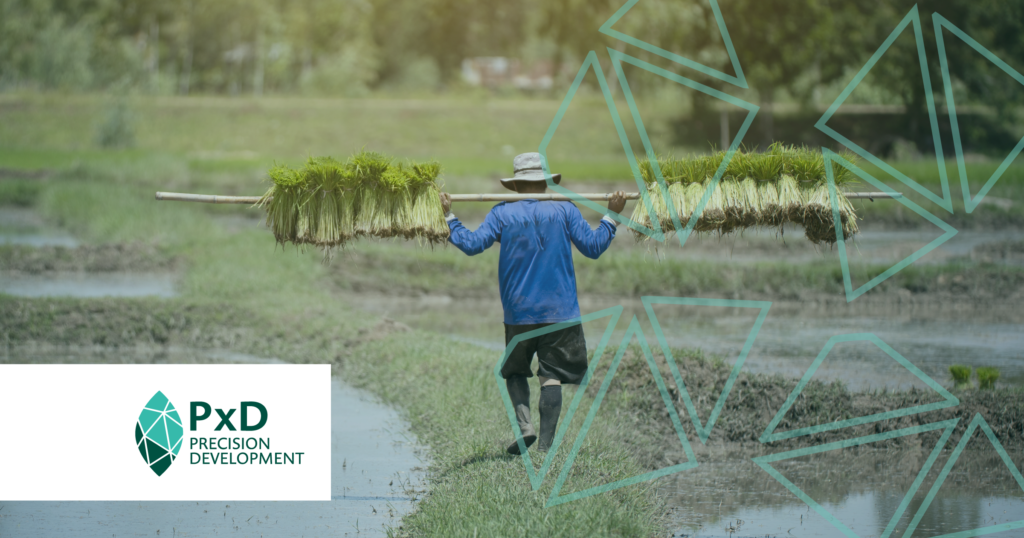
As a recent video produced by our colleagues at J-PAL recounts, Precision Development would not exist were it not for the practical application of research in the world. By intentionally deploying experiments and other methods, we continue to use research to inform the design of our services (innovation research) and to evaluate our impact (evaluation research), and these two types of research often overlap. PxD’s research practice aims to integrate with service design and delivery, and we leverage research to iterate our theory of change, identify learning objectives, and gather insights in every program and initiative.
Needless to say, in 2021 we were busy! Our research and operations teams have collaborated on 26 experiments, of which 14 are completed and 12 are ongoing.
Evaluation Research
At the end of 2021, PxD has three ongoing randomized controlled trials (RCTs) to rigorously evaluate the impact of our services on downstream user outcomes, such as the adoption of improved farming practices, improved agricultural yields, or impacts on learning. In addition to these three evaluations of our own services, we are collaborating with One Acre Fund (OAF) to evaluate aspects of their work with Farmer Promoters.
Excitingly, PxD is running a large-scale RCT with nearly 15,000 rice farmers in India to estimate the impact of the Ama Krushi service on farmers’ practices and yields, and how the magnitude of these impacts vary by farmer characteristics. Data on production costs and revenues will be collected from a subset of farmers for a back-of-the-envelope calculation on the service’s benefit-cost ratio. This RCT also aims to test the effectiveness of using satellite-based imagery to detect yield changes in GPS-measured smallholder rice plots and to compare these to self-reported farmer yields. Early in 2022, we will conduct the midline survey and process satellite images to assess the impact in the first season. We are eager to share our initial findings!
In western Uganda, PxD is collaborating with the International Food Policy Research Institute (IFPRI), the Hanns R, Neumann Stiftung (HRNS), and Technoserve to measure the stand-alone impact of PxD’s two-way voice-based advisory service and the complementary impact of digital reminders implemented by PxD as part of the Uganda Coffee Agronomy Training (UCAT) program. This RCT plans to integrate the use of machine learning to identify agricultural practices that have the highest impact on improving coffee yields and to identify farmer characteristics that are most closely associated with the increased adoption of such practices. The COVID-19 pandemic pushed back the initial implementation schedule for UCAT and we now plan to collect endline data for approximately 4,000 farmers in 2022.
In the education sector, Innovations for Poverty Action (IPA) and PxD have concluded data collection for a randomized evaluation to assess the impact of our two-way SMS math education service, ElimuLeo, on learning and knowledge. Implementation of the RCT has now concluded and we have extended access to the platform to children in the control group. We have recently surpassed the milestone of over 500,000 problems solved on the platform!
Since 2018, PxD has partnered with One Acre Fund (OAF) to test low-cost incentives to enhance the performance of approximately 11,000 Rwandan volunteer extension agents, commonly known as Farmer Promoters (FPs). With one FP in each of Rwanda’s 14,500 villages, PxD’s collaborative intervention targets a majority of FPs in the country. Importantly, FPs do not receive monetary compensation for their service, but rather receive in-kind benefits such as free inputs. Throughout 2021, PxD and OAF have been conducting an RCT to examine whether motivational SMS messages improve FPs’ performance, and to test whether motivational messages designed to appeal to the FP’s specific personality traits lead to improved FP performance and farmer outcomes. This evaluation includes three main interventions: a subsidized input promotion campaign, a demonstration plot and farmer training campaign, and an agroforestry tree planting campaign. We aim to launch endline surveys in early 2022.
Service Design and Innovation Research
As part of our efforts to leverage research to improve service design and delivery, we often conduct rapid hypothesis testing. We are also exploring ways of increasing engagement with our Ama Krushi push call service. In 2021 we deployed an A/B test that experimented with sending “heads up” SMS messages at different times to alert farmer users of an impending IVR call from the Ama Krushi service. Results are very promising: sending an SMS reminder 10 minutes before a service call increases pick-up rates by 5.9 pp (a 17% increase from the control mean pick-up rate of 34%). Conditional on picking up, the 10-minute SMS reminder also increases average listening rates by 4 pp (a 25% increase over a control mean of 15.4%). Considering both the success of the 10-minute reminders and the relatively high costs of sending SMS messages via the Ama Krushi service, one implication of this experiment would be to send short SMS reminders to farmers who are at risk of becoming inactive on the service to nudge engagement for a limited period and to promote recommendations that have particularly high-impact or are time-sensitive.
Reminders also play an important role in nudging farmers to take action on optimal planting dates. Planting at the optimal time is positively correlated with yields, yet misconceptions, lack of knowledge, or limited resources often result in farmers planting at a later date. In the 2021 Long Rains season in Kenya, we tested whether sending SMS messages recommending optimal planting times would nudge adoption. This experiment targeted a sample of approximately 15,000 OAF farmers and included additional treatments such as messages addressing misconceptions on planting times and direct endorsements from Field Officers. We found that SMS recommendations for optimal planting times are effective in nudging average self-reported planting dates closer to the optimal date. This effect is larger for late planters. Late planters in treatment groups reported planting, on average, four days closer to the optimal date relative to the late planters in the control groups. These results are valuable for improving service delivery in Kenya and for nudging farmers toward more timely planting. We are keen to conduct further research on the mechanisms underlying planting time decisions.
A/B tests deployed by PxD have shown that a narrator’s voice can impact user engagement in various contexts. In 2021 we completed a first A/B test on our nascent program in Nigeria to measure the effect of the narrator’s gender on pick-up and listening rates for PxD’s push call platform. Over the course of a seven-week period in the Wet Season, a sample of over 45,000 farmers was randomly allocated into two groups, receiving weekly audio content narrated either by a female or male voice, respectively. We found that female farmers have systematically lower pick-up rates than male farmers, yet this gap is slightly mitigated when the narrator is female. In addition, we found that all farmers (both male and female) when listening to content voiced by a female narrator were 1.4 pp more likely to listen to the full push call, given a mean completion rate of 51.8% of the audio content. Going forward, our service in Nigeria will primarily use female narrators when recording audio content for push calls. Nevertheless, we will benefit from further research to generate evidence on the long-term effect of this action on user engagement.
Our nascent research agenda in our newest program in Colombia is leveraging past experimentation on human contact and direct endorsements, particularly when it comes to increasing user engagement in the early stages of service delivery when name recognition and trust levels are limited. We have recently concluded profiling surveys and are analyzing how user engagement with PxD’s Un Mensaje por El Campo platform varies before and after farmers receive the profiling survey. SMS messages are not broadly used by smallholders in the Meta region of Colombia and many farmers need to be guided on how to access and navigate their SMS inbox to realize that they have been receiving messages from our service. Surveys and direct contact with surveyors from our team provide an opportunity to mitigate low digital literacy and improve trust in our service.
Moreover, we continue to explore ways to support farmer access to recommended agricultural inputs. In Kenya, we are building a proof-of-concept digital tool to improve linkages between farmers and agro-dealers by providing local agro-dealer contact information on our MoA-INFO platform. This digital Agro-dealer Contact Directory (ACD tool) will help us gather insights on the perceived value of reducing search costs among farmers and agro-dealers, as well as potential effects on farmers’ input search behavior and input access. Using these insights, we can then determine if there are other low-touch, scalable engagements with agro-dealers that will help us to improve farmers’ welfare. Drawing on the evidence from the literature on digital phone books, we have launched a two-way agro-dealer pilot with over 33,000 MoA-INFO farmers and 142 agro-dealers. This pilot aims to elicit feedback from farmers and convey information about their input demand to agro-dealers, mitigating informational barriers that prevent agro-dealers from consistently stocking inventory. Farmers are often uncertain about which inputs are in stock and agro-dealers are uncertain about quantities of inputs demanded by farmers, with many reporting being out-of-stock during peak times of the year. Stock-outs raise uncertainty and search costs for farmers and can lower adoption rates for improved inputs, especially if farmers have to travel far to other markets. Experimentation with the ACD tool aims to reduce search costs and improve access to recommended inputs.
Crowdsourcing local information from farmers and other actors along the agricultural value chain holds many potential advantages for our services. The key is to identify scalable ways to crowdsource sufficiently granular information to improve the quality of our advisory content. In Gujarat, we are generating insights on the operational feasibility and scalability of collecting accurate and timely information on crop health issues from locally recruited gig workers and tracking the volume and quality of data submitted by these workers via a tailored WhatsApp chatbot.
Finally, sourcing and providing information on pest prevention and management continues to be one of our research priorities. We are particularly excited about an ongoing pilot in Karnataka, India, which is reinforcing good management practices for white stem borer, a major coffee pest. In a recent round of qualitative surveys, we found that a majority of respondents had experienced white stem borer infestation in the previous coffee season, and many farmers reported using antiquated corrective measures that are no longer recommended by the Indian Coffee Board, or even practices that have been banned. Research undertaken in 2021 on Fall Armyworm infestation in Kenya and Zambia, provides some indicative evidence that our advisory increases knowledge and adoption of recommended pest prevention and management practices, and that sending reminders for priority practices may result in higher knowledge and adoption. Building on this evidence, we are partnering with J-PAL to test whether repeating key advisory messages on white stem borer and using different types of reminders and nudges, lead to higher rates of adoption for recommended practices among a sample of 2,400 coffee farmers. This experiment is ongoing and we aim to share results by mid-2022.
Looking forward to exciting research opportunities in 2022
Throughout 2021, PxD expanded dairy and livestock advisory services in Kenya, Ethiopia, Pakistan, and India. In Kenya, we are partnering with three dairy cooperatives to iterate and build a two-way SMS advisory service for dairy farmers. Building on the results of a gender survey to assess the gendered division of labor within dairy-producing smallholder households, we are excited to commence an RCT of the service in early 2022, ahead of the Long Rains seasons. We aim to rigorously evaluate the impact of the service on milk production (both in terms of quality and quantity) and sales for a random sample of 5,000 dairy farmers using administrative data made available from our dairy cooperative partners.
Finally, we are excited about our nascent climate research agenda, which includes both adaptation and mitigation efforts, and aim to continue scoping opportunities within our services and geographies to strengthen smallholders’ climate resilience, generate scalable low-cost climate mitigation innovations, and, above all, to improve smallholders’ agricultural productivity and income. We are excited to launch new products integrating granular weather forecasting with actionable advisory in Punjab, Pakistan, and Karnataka, India. Our weather pilots aim to incorporate innovation research to understand how to communicate uncertainty and probabilistic events in low-literacy settings, as well as the value of forecasting versus tracking advisory. Moreover, after recently securing new climate mitigation funding, we are eager to conceptualize research pilots to measure low-cost scalable innovations and rigorously measure changes in both farmer and climate outcomes. We intend to establish a proof of concept for our environmental theory of change and seek further validation of the applicability of PxD’s communication for behavior change model on new research areas, such as the potential for cash payments to farmers for activities that sequester soil carbon and contribute to climate change mitigation efforts.
At PxD our decision-making draws on existing evidence and scientific knowledge; understanding about how humans, institutions, firms, and markets behave and function; contextual information and knowledge about targeted users and local conditions; and our prior experience (as well as resource envelopes and other pesky exogenous factors). Research and inquiry are critical to generating insights and uncovering new information across all of these categories of knowledge. We are privileged to work with colleagues who rigorously generate and leverage evidence to guide our work and decision-making as we develop, iterate, and scale innovations that impact poverty at scale.
We look forward to sharing new insights with you throughout 2022!
The Abdul Latif Jameel Poverty Action Lab’s (J-PAL) has showcased PxD as an organization that leveraged the value of randomized evaluations to launch more effective approaches to reducing poverty on a global scale.
The video was produced as part of J-PAL’s “Evidence to Policy” series which was envisaged as a vehicle to highlight the use of rigorous testing to inform policy and scale effective change.
The producers interviewed Shawn Cole, PxD co-founder, Chair of our Board and a J-PAL affiliated professor, Tomoko Harigaya, Chief Economist, and Niriksha Shetty, India Country Director, discuss how evidence from rigorous evaluations catalyzed the scale-up of a low-cost, mobile phone-based agricultural information delivery system to support smallholder farmers.
We thank J-PAL for this rather excellent production!
Women play important roles in smallholder dairy production. As PxD prepares to roll out a dairy advisory initiative in Kenya, we conducted a gender survey to better understand the division of labor within households. In this post, the second of a two-part series, Sam Strimling, Research Associate, presents an analysis of the results. The first post laid out the importance of understanding the specific needs of women in designing effective service delivery for women.
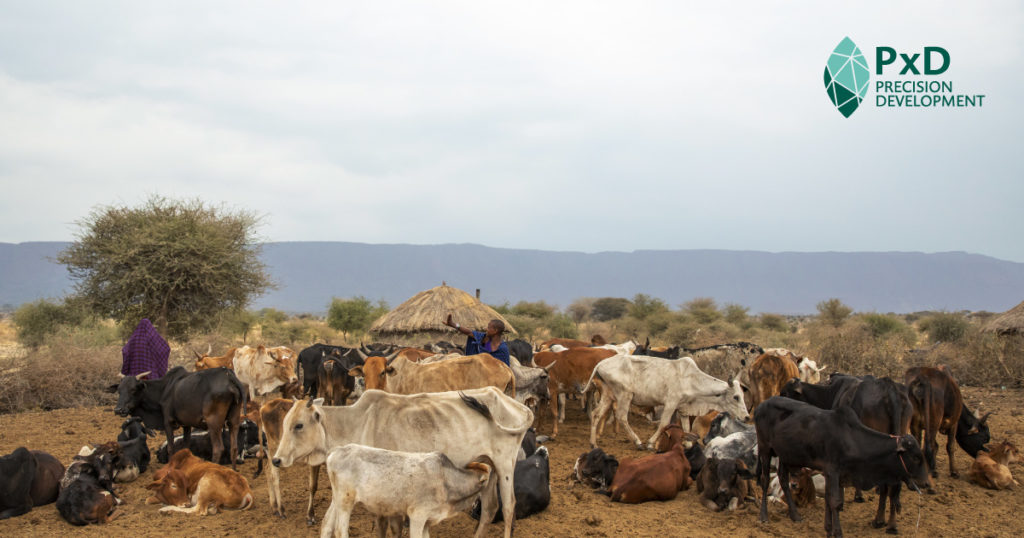
In many smallholder households, labor relating to the tending of livestock – particularly dairy animal husbandry and dairy production – is derived disproportionately from women. This culturally entrenched division of labor has direct implications for PxD as we expand into supporting dairy farming activities and seek to target our digital advisory services appropriately.
There is a plethora of evidence – much of it detailed in the excellent book, Invisible Women, by Caroline Criado Pérez – of service providers who failed to understand women’s specific needs and preferences and thus designed inferior products. Providers of digital advisory services are no exception to this disappointing phenomenon.
As PxD prepares to roll out a dairy advisory initiative in Kenya, we considered it a top priority to conduct a gender survey to better understand the roles played by each household member with a focus on tasks performed, decision-making, and financial agency. The results of this survey will be used to inform the dairy content we are developing as part of an upcoming randomized controlled trial (RCT) we are implementing in partnership with several dairy cooperatives across different regions in Kenya. We will use the results of the survey to inform the type of content we write, as well as how and to whom we deliver it.
As detailed in a previous blog post about the survey, the PxD Kenya team used a novel and rich dataset to inform survey design. In addition to gaining insights into the roles played by different members of the household, we also sought to better understand the technical and analytical abilities of each respondent, as well as perceived technical knowledge for each household member. Finally, we used methods from behavioral economics to empirically evaluate trust within the household.
Survey Structure
We started with a total sample of 600 households randomly selected from two dairy cooperatives, in the Rift Valley and Eastern regions. The sample was stratified by geography, milk sales to the dairy, and deductions for purchases from the dairy-affiliated agrovet (in which farmers are able to purchase animal medicines and farming inputs using income from milk).
We called 464 unique respondents, of whom 357 answered at least one call. Respondents who lived with or made decisions with their spouses were asked to provide contact information. Single respondents – many of whom were widows or widowers – were encouraged to complete the survey, but were not asked a series of subjective questions about the degree to which they made decisions or discussed activities with their spouses. Single respondents were also not asked to participate in the public goods game. In total, 114 spousal pairs completed the full survey. These spouses, and their respective households, will be the focus of this post. The demographics of the survey respondents and their households are shown in the table below.
Intra-household dairy roles. At the start of the survey, each respondent was asked to list the members of the household above the age of five, and state their age, gender, and education. The survey enumerators used tablets to record responses that allowed them to capture this information to be used later in the survey. Respondents were then asked to select from this list to indicate which member(s) of the household:
- Practiced crop farming, grazing, fetching water, wage employment [Respondents were specifically asked if they held “a job outside the home.”], schoolwork, childcare, and/or leisure in any given week. Respondents were also asked to indicate the number of hours each selected household member spent on each task in a typical day.
- Practiced various dairy tasks, selected from a list of tasks generated by our Staff Dairy Livestock Expert. For each task selected, respondents were asked to indicate which household member took primary responsibility, and how many minutes this individual typically spent on that task per day. This is the only household roster question for which the respondent was asked to select a single respondent rather than having the option to select multiple members.
- Were knowledgeable about nutrition, artificial insemination, hygiene, disease, and feed and fodder. The respondent was also asked to rank the selected household members in terms of their knowledge on that particular topic.
- Had taken various financial actions, including purchased a personal asset, purchased a productive asset, sold crops on behalf of the household, received payment for crops on behalf of the household, received payment for milk production, and made decisions about spending dairy income.
Analytical ability and dairy knowledge. Respondents were asked to answer a series of scenario-based analytical questions as well as questions to assess technical dairy knowledge on a broad range of topics. We then calculated the percentage of analytical and technical questions the respondent answered correctly.
Subjective assessment of financial agency and cooperation. Respondents were also asked to provide information on their personal knowledge and feelings of financial agency. To assess financial agency, respondents were asked to indicate using a Likert scale the degree to which they discussed finances with their spouse, trusted their spouse’s financial decisions, talked with their spouses about agricultural work, and talked with their spouse about their day generally.
Intra-household cooperation – the public goods game. Finally, all respondents who completed the survey were awarded 100 Ksh (approximately $1) in airtime, and – if their corresponding spouse had also completed the survey – they were invited to increase their earnings by contributing some portion of their earnings into a common account with their spouse. Since the amount contributed to this common account was doubled and then split evenly, the respondent’s contribution could be interpreted as an empirical measurement of cooperation with their spouse.
Information asymmetry. For the 115 households in which we collected information from both spouses, we were able to calculate the degree of coherence in their responses in terms of the intra-household (inter-spousal) correlation coefficient.
General Time Use & Dairy Tasks
Male and female respondents broadly agreed on the division of labor within the household by gender of household members. We focus our description of intra-household gender-specific roles on the share of time spent by males and females within the household and checked whether men and women respondents generally agree on this proportion. This is presented in Figure 1 below, which organizes respondents’ perceptions by the proportion of hours household members of different genders spend on pre-specified activities within the household (p-values reflect tests of the null that there is no difference in responses across spouses). While male and female respondents differed in their reports of the time spent by gender of the household member, these differences were not significant for any time-use category other than crop farming. In this instance, the difference in perceived hours on task from the perspective of male and female respondents was statistically significant at the 5% level (as demarcated by the p-values next to each bar). In general, respondents of both genders reported that crop farming, grazing, school, and leisure were split nearly evenly by gender. Female household members, however, were reported to spend more time fetching water and engaging in childcare relative to male household members, and male household members were more likely to have a job outside the home.
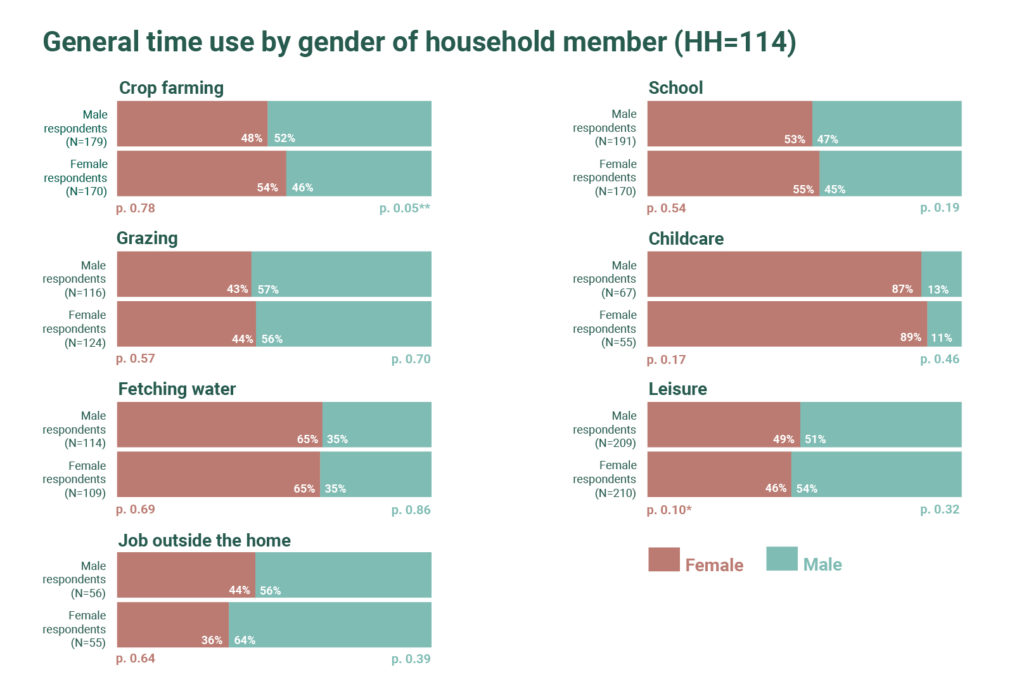
There was an overall alignment between male and female respondents on the reported activities of different age groups (Figure 2). The overwhelming majority of those in school were aged 5-20, while those aged 26-50 performed the bulk of income-generating labor, including crop farming, tending to grazing animals, and jobs outside the home, as well as tasks culturally associated with “women’s work” (fetching water and childcare). Leisure was fairly equally distributed across age groups.
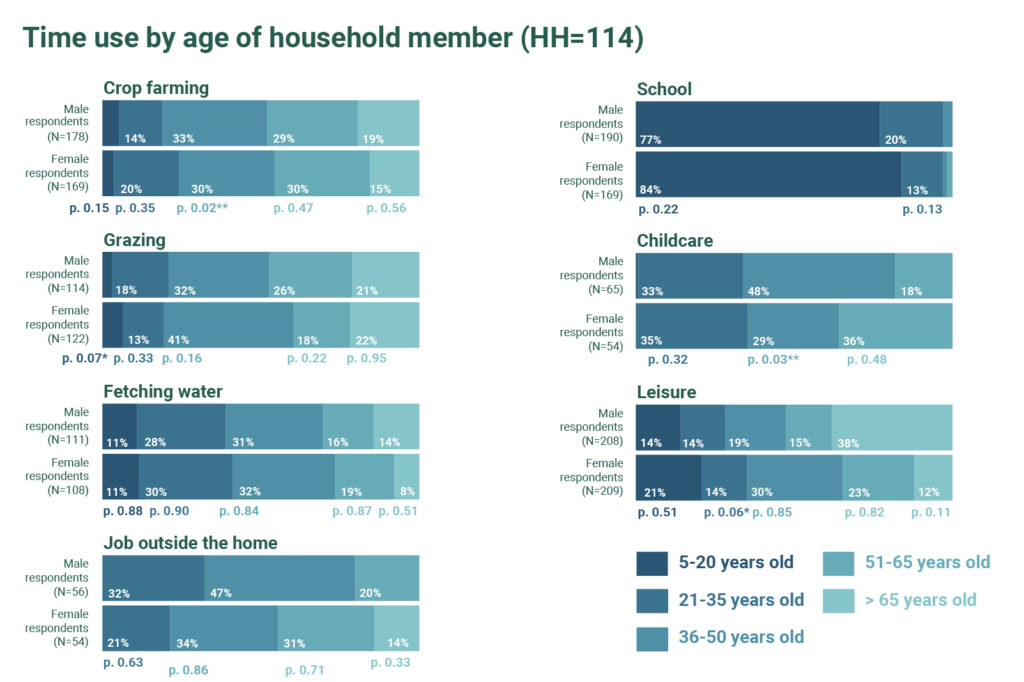
Of the 20 dairy tasks that each respondent was able to select from, nine were selected by respondents in our sample: cleaning the milking equipment, giving the cows water, feeding the cows, milking the cows, feeding the calves, transporting and selling milk, cleaning the housing unit, sourcing and threshing fodder, and sourcing feed and fodder. Figures 3 and 4 below applies the same analysis to these tasks as applied above to the responses on household time use: that is, Figure 3 analyzes the differences in male versus female respondents’ perceptions of household members’ dairy time-use by the gender of the household member, and Figure 4 analyzes this in terms of household member age group.
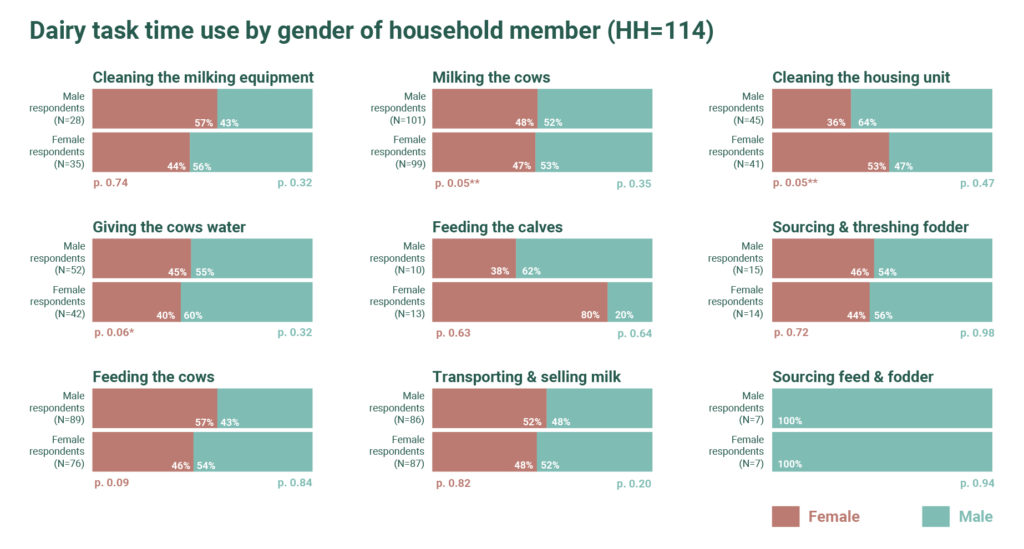
For most tasks, labor appears to be split fairly evenly by gender. A possible exception to this rule is feeding of calves, which female respondents assert is performed more by women than by men at a ratio of 4:1; men disagree on this, however, which is statistically significant at the 5% level, though the relatively low sample size makes it hard to put too much stock in this comparison. Further analysis could examine whether there is a difference based on a household’s production system. For example, in zero-grazing (or semi-zero-grazing) households, domestic tasks may account for a larger share of household labor, in turn skewing labor allocation toward the purview of women.
In addition to splitting labor by gender, dairy-related labor also appears to be distributed relatively evenly across age groups. The exceptions to this rule are “feeding the calves” and “cleaning the housing unit,” which according to female respondents – but not male respondents – is overwhelmingly performed by younger populations. Though difficult to say conclusively, a possible explanation for this difference in reporting is that female respondents may be more aware of how labor is divided on these tasks, which tend to be domestic in nature.
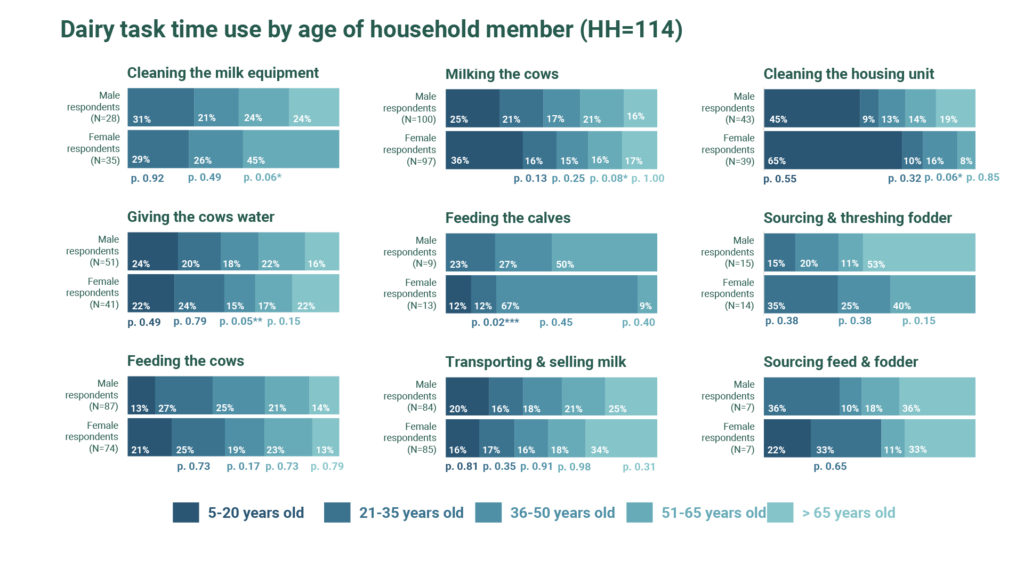
While on average there seems to be a great deal of agreement between spouses in our sample, this does not preclude the possibility of variation in the degree of agreement across households. Figure 5 below displays a measure of within household agreement by calculating the correlation coefficient in the vector of responses provided by women and men respondents in the same household. If, for example, on average, most husband and wife pairs agree on the time spent within the household on childcare, the correlation coefficient will be closer to 1. If they systematically disagree, the correlation coefficient will approach -1. If the correlation coefficient is close to zero, there is no clear agreement between husbands and wives within the same household on how tasks are distributed among household members. In our survey, there was a high degree of correlation between spousal responses for general time-use categories (i.e., crop farming, childcare, leisure, etc.).

Knowledge
Prior to measuring actual analytical skills and technical knowledge, we asked respondents to subjectively indicate which household members possessed knowledge in five categories: nutrition, artificial insemination, hygiene, disease, and feed. We then calculated the total percentage of individuals within a household perceived to have knowledge on a topic by gender (Figure 6) and age group (Figure 7).
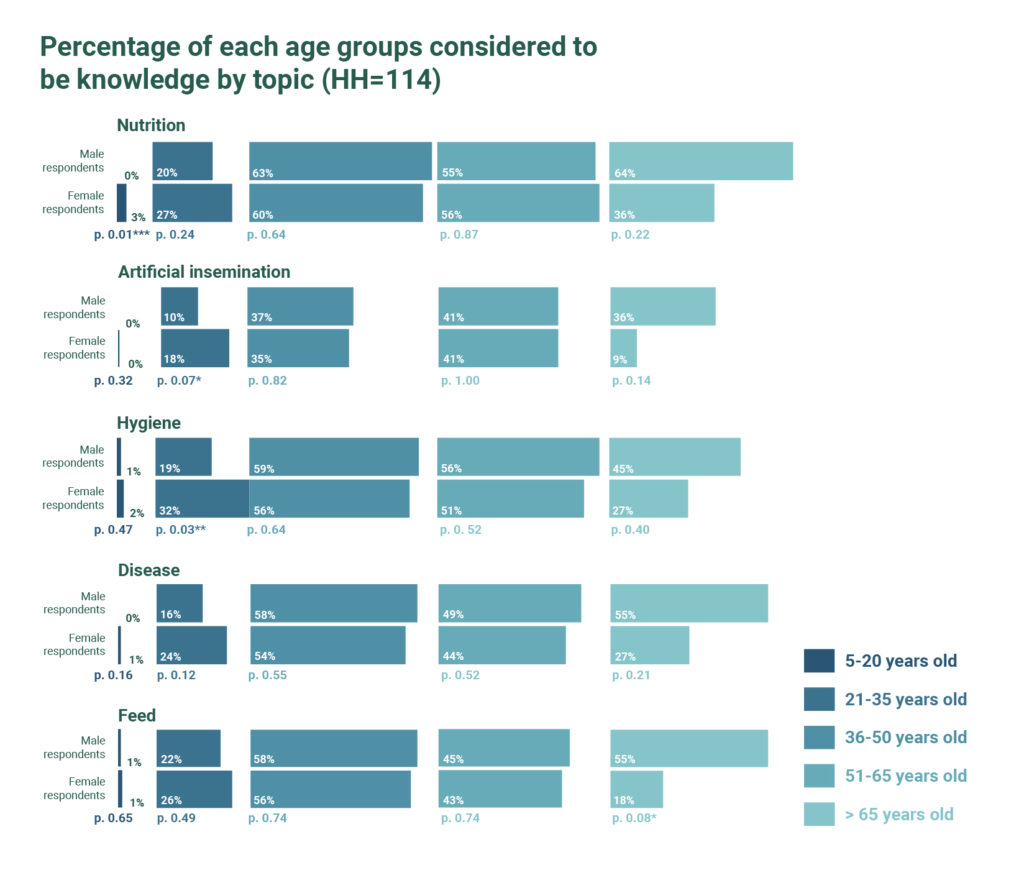

Across all categories, both male and female respondents perceived male household members to be more knowledgeable; there was broad intra-household agreement on knowledge perceptions as well (see Figure 8). Interestingly, male household members were judged to be especially knowledgeable in categories such as disease and artificial insemination; this was particularly true in the eyes of male respondents, who judged male household members to be at least twice as knowledgeable as women about these subjects. One hypothesis for this is that these subjects may carry a connotation of expertise due to their affiliation with actual professionals (i.e. veterinarians). By contrast, the perceived knowledge gap was a lot lower for other categories, such as nutrition and hygiene.
In fact, when tested, male respondents did perform significantly better than female respondents in terms of technical knowledge, with a mean score seven percentage points higher. That said, male respondents performed no better than female respondents on a test that used scenario-based questions to measure analytical thinking.
That said, two caveats must be considered in drawing conclusions from these results (shown in Figure 9): First, these results measure respondent knowledge rather than directly evaluating the knowledge of all household members. Second, the tests were brief and covered a broad array of subjects, making it impossible to evaluate whether the respondent may have deep knowledge on a particular topic. Both of these gaps suggest promising areas for future research in order to better understand the degree to which perceptions of knowledge match reality, rather than merely reflecting cultural biases; in reality, the answer may well be both, though additional empirical analysis is needed to make this claim.
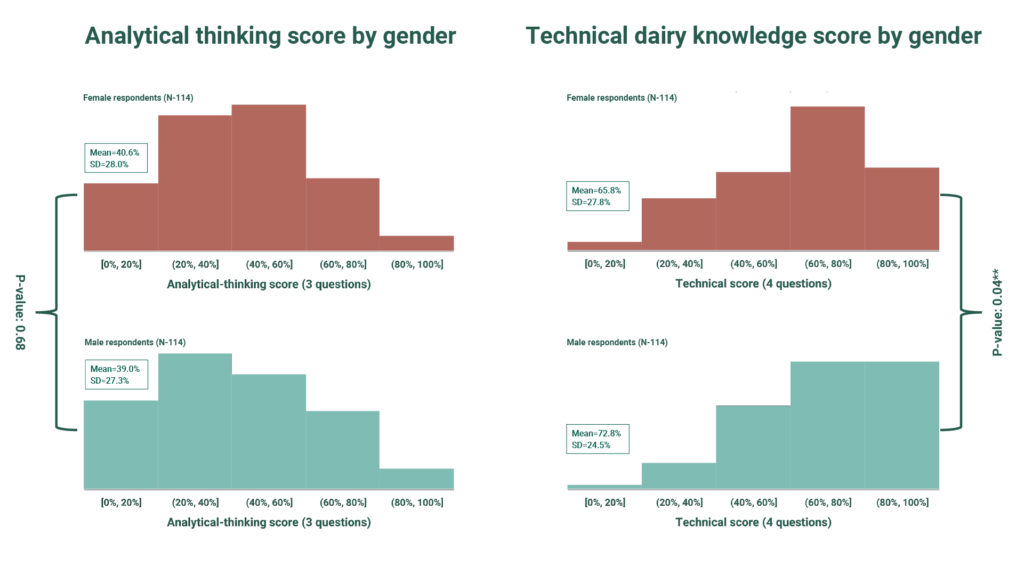
Financial Agency, Intra-Household Decision-Making, and Trust
Respondents were asked a series of questions regarding their perceptions about who controlled money within the household: who in the household purchased productive assets, purchased personal assets, purchased inputs, sold household crops, received payments for crops, received payments for milk money, made decisions about spending milk money, and owned a financial account. Figures 10 and 11, respectively, analyze these results by gender and age of the household members.
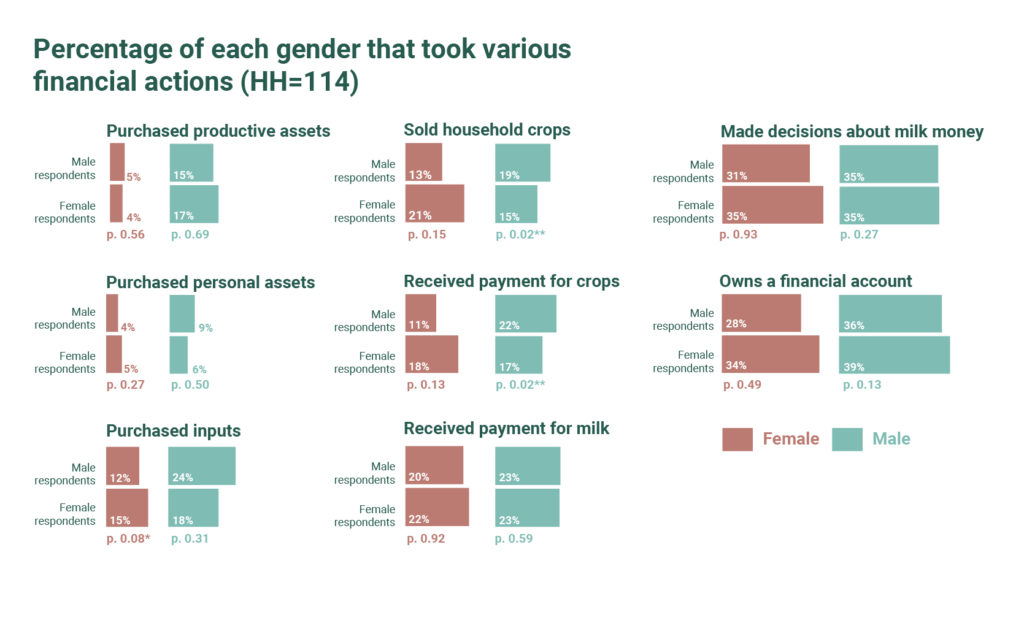
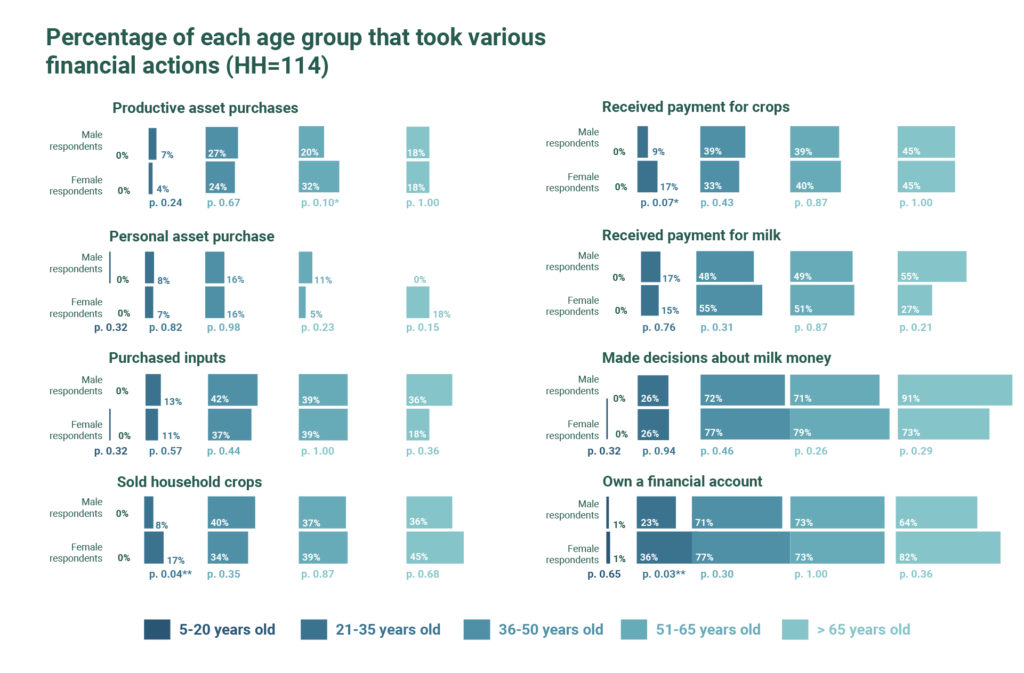
Very few household members were reported to have purchased personal assets; more – overwhelmingly men – purchased productive assets, according to both male and female respondents. Male and female respondents also agreed that payment for milk money and decisions about milk money were generally split evenly within the household. Both male and female respondents also reported that household members of both genders owned financial accounts (though men did so to a slightly higher degree).
There was less agreement by respondent gender about crop farming. Male respondents reported that male household members played a larger role in selling crops, whereas female respondents reported the opposite. This same pattern was true regarding respondent perceptions of who received payment for crops. In both cases, the difference in the perception of different genders was statistically significant at the 5% level. Additionally, while respondents of both genders agreed that more male household members purchase inputs than female household members, male respondents reported the ratio to be 2:1, while female respondents reported this difference to be marginal; this disagreement was weakly statistically significant (at the 10% level). Within households, there was also comparatively more disagreement on the measures related to crop farming and associated income, as shown in Figure 12.

There are several potential explanations for the disagreement on this measure. One potential reason is there may be an internal lack of clarity within the household about who performed which category of tasks. This does not necessarily mean that individual tasks do not have a “clear” owner; alternatively, the divisions we at PxD made for the purposes of this survey may not correspond to household constructs around the division of finances. This suggests a possible area for future research: an open-ended survey consisting of structured interviews on this topic may yield interesting insights regarding financial accountability and power within the household.
Moreover, the disagreement may reflect the fact that some tasks may be performed jointly (or in an alternating fashion) with other household members; this possibility need not be mutually exclusive with alternative divisions of labor within the household. The results in Figure 13 suggest this possibility. When asked who makes financial decisions about the farm, the majority of women (62%) and men (82%) said they made this decision together with their spouse; an additional 25% of women said they did so jointly with the household head. Even who the “primary” decision-maker was could be muddled, with 72% of women and 50% of men claiming to occupy this role jointly with either a spouse or household head.
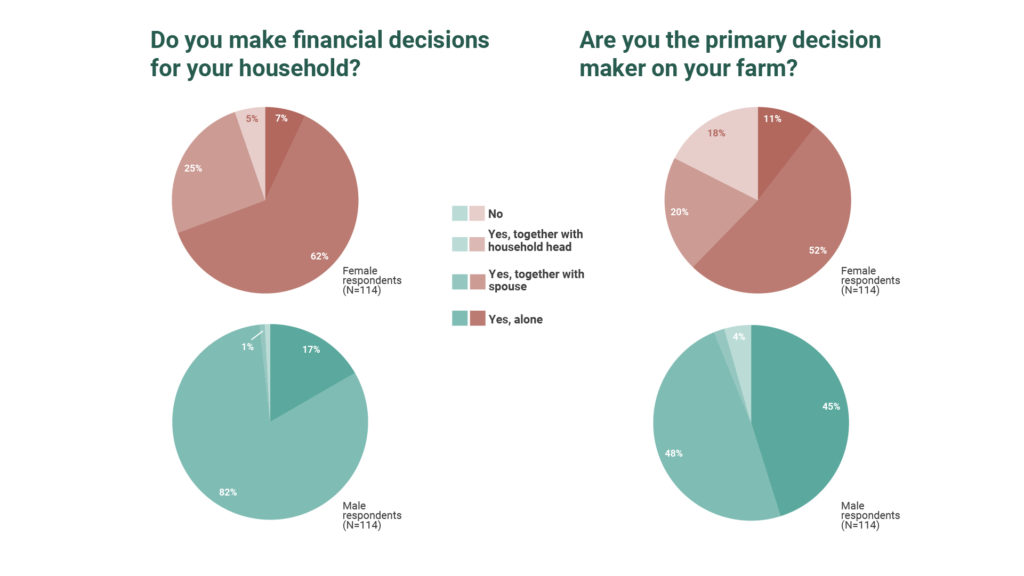
These results are ambiguous regarding whether each decision is made jointly or whether men and women have different spheres of influence within the household (and financial discretion within those spheres). However, the Likert scale questions, in which respondents were asked to agree or disagree with a number of statements about intra-household decision-making suggest that many decisions are made jointly – or at least with a substantial discussion between household members. (Figure 14)
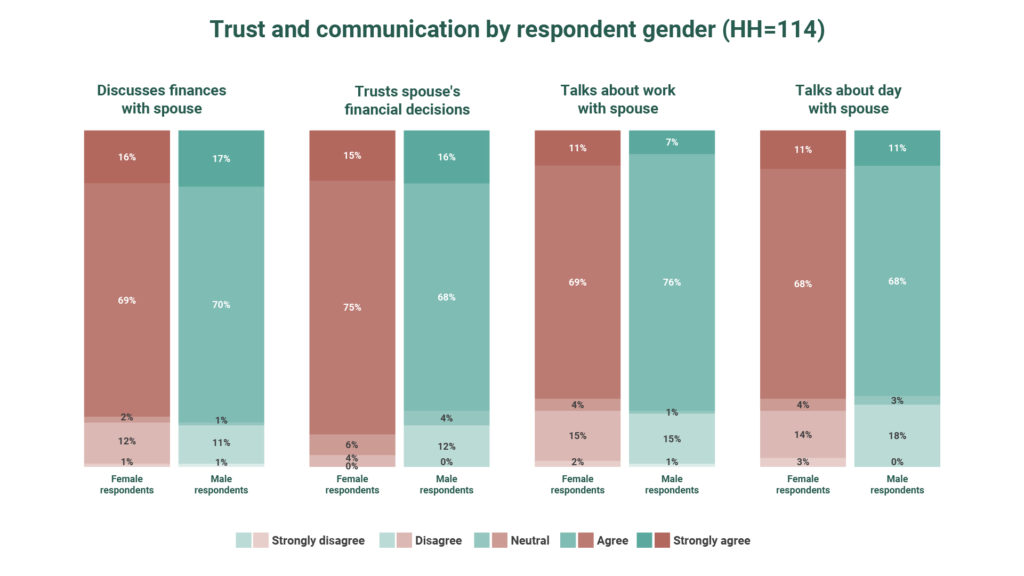
Eighty-five percent of female respondents and 87% of male respondents reported that they discussed finances with their spouse; moreover, 90% of female respondents and 84% of male respondents reported that they trusted their spouse’s financial decisions.
In order to empirically test these subjective responses, we also asked respondents to participate in a “public goods game,” in which they could choose to augment a portion of the financial incentive they earned for completing the survey (100 Ksh, or about 1USD) to a common account. Contributing a greater amount theoretically indicates a greater degree of cooperation with one’s spouse since the amount in the common account was split evenly between spouses after both completed the exercise, regardless of how much each spouse contributed individually. The results of this game suggest a moderate amount of trust, with contributions for both women and men clustering around the midpoint of the range between zero and the total possible contribution. Figure 15 displays the distribution of these respondents’ contributions. While male respondents contributed more on average (statistically significant at the 5% level), the plurality of respondents of both gender contributed a medium amount (i.e., 40-80 Ksh)
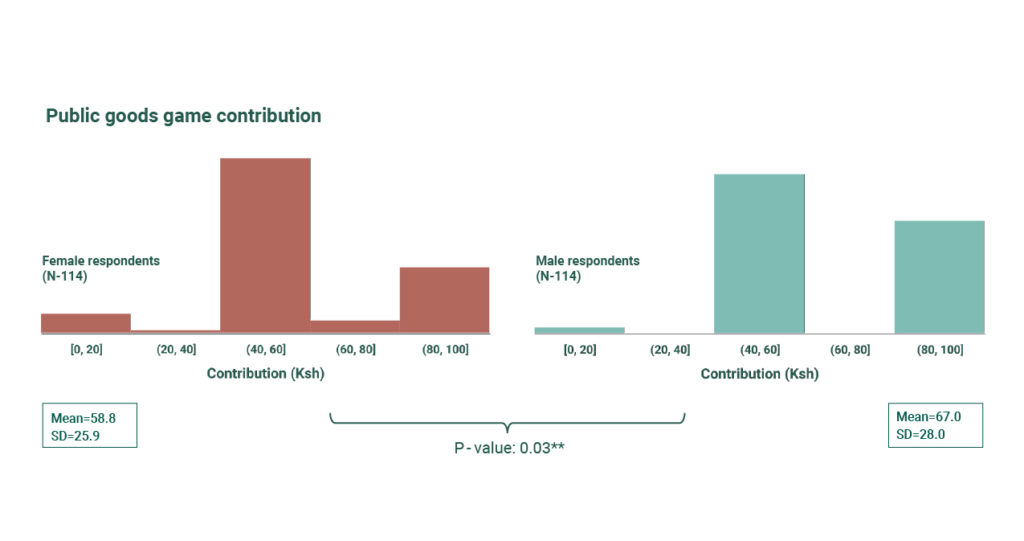
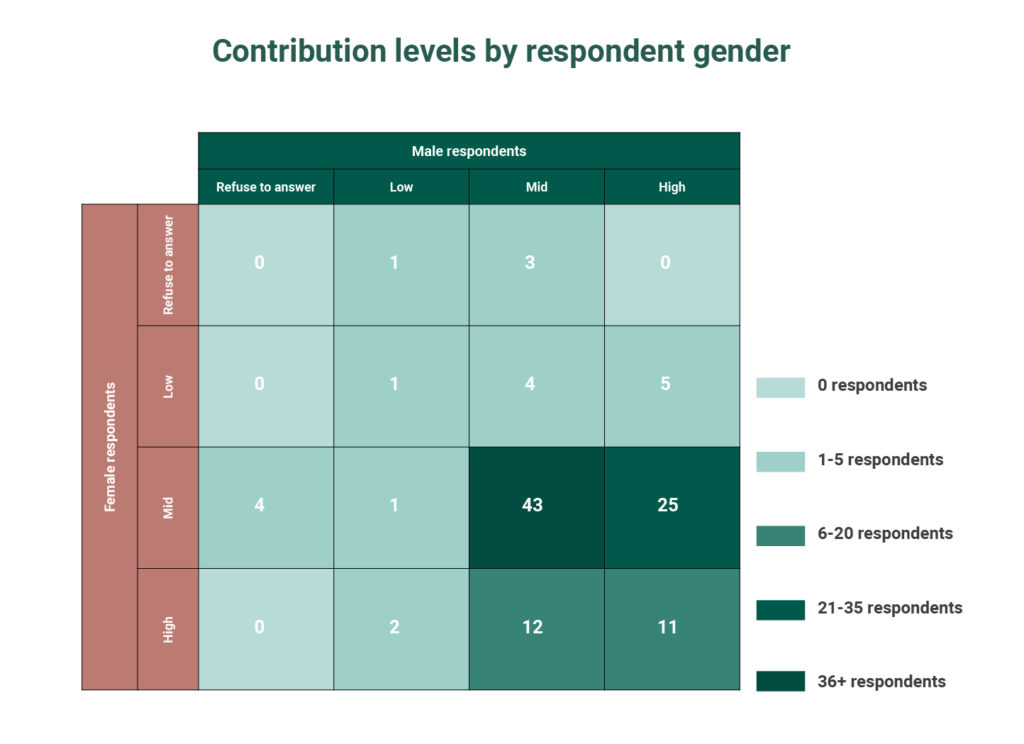
One way to empirically evaluate whether the public goods game in practice aligns with subjective cooperation in the household is to directly compare these results. First, we regressed the correlation coefficient between the spouse’s individual Likert responses – that is, the degree to which husband and wife agreed about their level of trust or communication – on the various contribution categories (limited the covariates to the bottom quadrant of Figure 16, to make sure each category reflects a sufficient sample of people to draw meaningful conclusions). The results of this regression are shown in Table 2. There was not a high correlation between these metrics, with none of the contribution categories predicting agreement between the spouses regarding the degree of cooperation.
The next stage of analysis was to compare directly the responses to the Likert scale questions on intra-household communication and trust to the public goods game contributions. To do so, we first split the sample by respondent gender and then ran ordered logit regressions separately for each sample (Table 3). In these regressions, a positive coefficient signifies that a member of a household in that specific contribution category is more likely to “strongly agree” with the statement. To make this concrete, the variable “female mid, male high” in the female sample is equal to one for a member of that population who contributed a medium amount (40-80 Ksh) and whose husband contributed a high amount (80-100 Ksh), and is equal to zero otherwise. A positive coefficient on this variable means that a respondent in this category is more likely to “strongly agree” with an affirmative statement on the Likert response; e.g. for the first regression in the table, she is more likely to say she often discusses finances with her spouse. While all the coefficients for the regressions on the male sample and about half of the coefficient for the regressions on the female sample are positive, none of the results in either sample are statistically significant.
Since the public goods game contributions do not align with subjective measures of intrahousehold cooperation, it is unclear whether respondents are less trusting in practice than they aspirationally report to be on the subjective questions, or whether the public goods game does not accurately measure intrahousehold trust. The answer may be a combination of the two or may vary by Likert category. This suggests an area for future research.
Next Steps
This information is valuable for informing the design and operation of a dairy service that empowers rather than further marginalizes female farmers. It bears mentioning that we will continue to monitor engagement by gender to validate the insights of this survey on an ongoing basis and to make sure that we continue to reach women farmers.
That said, there are a few points we can take away from this dataset –
and we can use it to identify areas for additional research:
- In general, women and men reported that they split labor related to crop farming and grazing, and both females and males reported going to school and pursuing leisure activities. Unsurprisingly, women reported spending more time fetching water and engaging in childcare relative to men, and men were more likely to have a job outside the home. Perhaps more surprisingly, most dairy tasks were split relatively evenly by gender. Further research could investigate the ways different production systems influence household division of labor: for example, since women generally take charge of more domestic tasks, in zero-grazing households is dairy-related labor more commonly performed by women?
- Both men and women perceived men to be more knowledgeable on all topics asked about (nutrition, hygiene, artificial insemination, and feed). One positive of digital advisory compared to traditional in-person systems is that both women and men are able to read the advice on their own, and thus may be less subjected to the influence (and doubts) of peers and other household members. However, this knowledge gap may have implications for marketing: if women are systematically viewed as less knowledgeable, men may find a service that aims to disrupt that balance in the household to be threatening. Additionally, the perceived knowledge gap may pose a barrier to adoption of recommendations by women if proposed without male buy-in and perceived to not know what they are talking about.
- The allocation of financial power in the household was far from clear-cut. A similar proportion of both genders received payment for and made decisions regarding milk money, and respondents of each gender disagreed as a group about which gender sold and received payment for crops. Additionally, the majority of respondents of both genders reported making financial decisions and being a “primary decision-maker” – either individually or jointly with a spouse or household head. Finally, both male and female respondents reported discussing finances with their spouse and trusting their spouse’s financial decisions. While this has positive implications for adoption of advice by both genders, it also suggests that many decisions are made jointly and buy-in from both spouses is necessary for implementation.
- The responses of respondents of both genders to the Likert scale questions suggest a high level of intra-household communication, trust, and cooperation, at least in the subjective opinions of respondents. Similarly, the vast majority of respondents of both genders contributed at least a medium amount (40 out of a possible 100 Ksh) to the common account in the public goods game. This has positive implications for adopting recommendations, which in many cases will require collective household buy-in. That said, there remains opportunity for a more granular understanding of intra-household cooperation. For example, how does it differ in households with more defined household and/or farming roles, or in households where one spouse is clearly knowledgeable? (While this dataset contains questions to this effect, the sample size is too small to draw meaningful conclusions about precise subsets of respondents.) Outside of this data, what impact do production systems (i.e. zero-grazing) and use of particular technologies (e.g. machinery such as chaff cutters or other equipment, such as durable water tanks) have on the level of intra-household cooperation?
While the effort to better understand our service users is ongoing and our efforts to improve content and delivery are constantly evolving, this data collection yielded meaningful insights and constituted a significant step towards inclusive product and service design that can be put to use in PxD’s Kenyan dairy service – and more broadly in programming across the region.
Can e-commerce address constraints that inhibit growth and productivity among Indian smallholder farmers? Rohit Goel, a Research and Operations Associate on PxD’s India Team, investigates and traces the contours of an exciting PxD pilot in Gujarat which aims to connect smallholder farmers to online vendors and marketplaces.
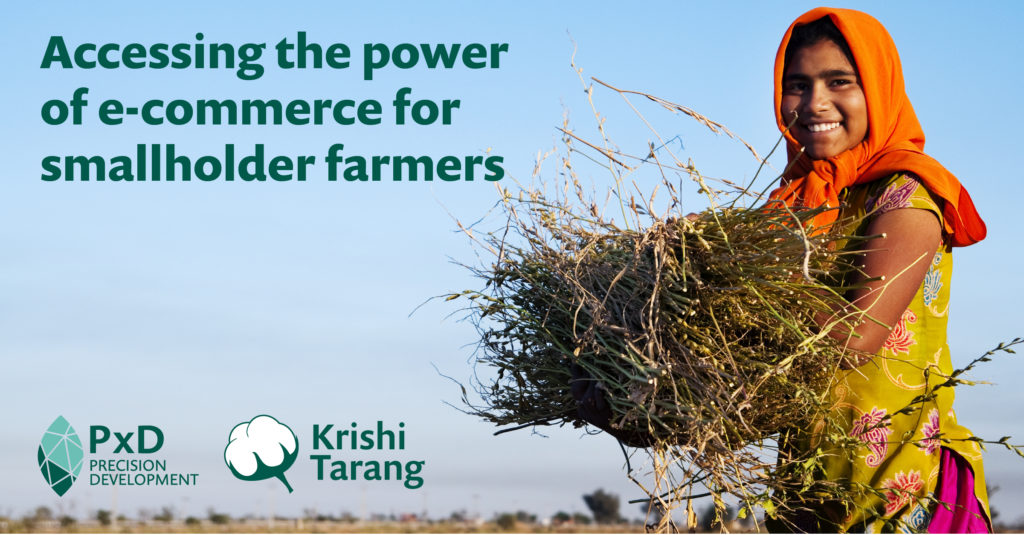
E-commerce – the buying and selling of goods and services over an electronic network – has transformed business operations in India. In 2020, the market size of e-commerce in India was assessed at 64 billion USD in 2020 and is expected to rise to 200 billion USD by 2027. This rapid growth in e-commerce has the potential to address long-standing deficiencies in the Indian agricultural sector, and transform Indian agriculture – a sector that accounts for 18.3% of India’s GDP (2020) and is the primary source of income for a majority of Indian households. This opportunity presents itself at a time when the sector is declining in productivity due to a range of challenges including a constrained supply of inputs, inefficient sales markets, and low levels of competition among intermediaries across supply chains. However, India’s agriculture sector is poorly positioned to capitalize on the opportunities presented by e-commerce due to challenges confronting smallholder farmers in rural areas, such as low levels of digital literacy, poor ICT infrastructure, a lack of familiarity with digital transactions, and inequitable access to smartphones and/or the internet.
Precision Development (PxD) is well-positioned to assist firms and farmers overcome these and other access and market-related challenges. With support from the Swiss Re Foundation, we are utilizing our voice-based, two-way information exchange service – dubbed Krishi Tarang – to pilot an initiative to inform farmers about, and connect them with, a variety of businesses that address unmet needs at different points across the agricultural value chain – including, but not limited to, input suppliers, crop offtakers, lending agencies, crop insurance providers, soil testers, and carbon traders. Krishi Tarang operates using Paddy, PxD’s in-house communications platform, and is compatible with very basic mobile phones that lack internet capabilities. The pilot will also explore revenue generation opportunities to support the scaling of free, customized, and timely agricultural advisory services to smallholder farmers and endeavors to complement the work of other not-for-profit organizations working to improve farmer livelihoods so that their farmers can take advantage of these new partnerships too.
Creating an online ecosystem for smallholder and village farmers
With support from the Swiss Re Foundation, PxD is working to holistically address farmer needs by creating an ecosystem of private partners along the agricultural value chain. Moreover, we are investigating ways in which new partnerships can generate revenue to support free digital agricultural advisory services for smallholders. The successful implementation of an integrated service offering at scale has the potential to reduce farmers’ overall costs while enhancing their revenues. We also hope that this initiative will generate new insights that help us to make our advisory service more relevant and, by extension, improve adoption rates of PxD’s recommendations among farmers.
Since December 2020, PxD has run a pilot project with farmers registered on our Krishi Tarang advisory service in Gujarat. As part of the pilot, PxD contacts farmers via channels, such as automated and live calls, to promote the services of our partners. Farmers who show interest in a particular service are then connected to service providers. PxD takes a nominal commission on every successful transaction initiated by Krishi Tarang farmers and, in certain instances, a fixed fee for connecting each new farmer. In this way, PxD’s farmers can connect with a series of legitimate e-commerce partners to access various goods and services such as business development and market linkages, agricultural inputs, financial support, and field-level technology. Since the farmers do not need an internet connection or smartphone to access these services, we can circumvent some persistent barriers to entry and access, and connect marginal and smallholder farmers to online vendors. We hope that competition among vendors will improve and draw an increased number of users and service providers to the village and smallholder marketplace.
E-commerce’s transformative potential
In 2016, 59% of India’s workforce was employed in agriculture. In rural areas, dependence on farming activity is widespread, with 70% of households relying on agriculture to support their livelihoods. According to the Food and Agriculture Organization (FAO), 82% of India’s farmers are small and marginal farmers. Despite the importance of agriculture for so many Indian households, the contribution of agriculture to GDP has fallen precipitously in recent decades, declining from 41.3% in 1960 to 18.3% in 2020. Given the large share of Indian households that continue to depend on agriculture to support their livelihoods, and the number of poor households dependent on the fortunes of the sector in particular, declining productivity and profitability in the sector is a significant concern.
E-commerce has the potential to address several challenges constraining the performance of India’s agriculture sector by creating new links between participants along the agricultural value chain. Examples of potential benefits include:
- Waste reduction: According to the Food and Agriculture Organization (FAO), a third of food produced for human consumption is wasted. A study by the Indian Council of Agricultural Research in 2016 reported losses of approximately 5.5% for cereals, pulses, and oilseeds, and approximately 11% for fruits and vegetables, due to waste during harvesting, post-harvesting, handling, and storage. Agriculture e-commerce services can reduce post-harvest waste by minimizing the number of intermediaries farmers need to liaise with, improve access to more efficient transportation, and quicker access to quality storage facilities. At the aggregate level, these effects can substantially reduce the time it takes for produce to reach consumers.
- Overcoming information asymmetries: There is some evidence that mobile phones improve farmers’ access to information with potentially positive implications for their incomes, although the findings are mixed. Muto & Yamano (2009) found that increased phone coverage in rural Uganda, between 2005 and 2009, was associated with a higher probability of banana sales and an increase in the sale price of bananas. However, this pattern was not evident for maize, a non-perishable crop, suggesting that price information may be more important for products with a shorter shelf life. Jensen (2007) found that the introduction of mobile phones in Kerala was associated with an increase of 8% in fishermen’s profits, driven by reduced wastage. However, other papers have found little impact of ICT on farm prices and farmer income. For example, Aker and Fafchamps (2015) examined mobile phone expansion in Niger, and Futh and McIntosh (2009) examined the introduction of village phones in Rwanda. Neither evaluation found evidence that increased access to phones was associated with price changes.
- Financial inclusion: When agricultural e-commerce platforms store transaction records, they may offer farmers an opportunity to build a “digital history” that could, in turn, allow them to demonstrate farmers’ creditworthiness to financial service providers. Francis, Blumenstock and Robinson (2017) identified credit scores, captured from the historical user data using mobile phones, as one of the major factors leading to creating a digital credit system. Digital credit lowers transaction time and reduces costs compared to conventional credit, and borrowers generally do not need collateral to be approved for digital loans. According to GSMA’s report, in 2018, 866 million people have mobile money accounts processing 1.3 billion USD daily. Sub-Saharan Africa accounted for 45.6% of the mobile money activity in the world; and technology companies, credit bureaus, and banks are opting for smartphone digital credit scoring for their business.
- Improved cost and market efficiency: The potential economic benefits of agriculture e-commerce may serve as an incentive for farmers to increase their on-farm investments and productivity. In addition, farmers may gain access to higher-quality inputs through online suppliers than they can find in their local markets. For example, Bergquist and McIntosh (2021) find that the introduction of a mobile phone-based marketplace for agricultural produce in Uganda led to increased trade flows and reduced-price dispersion across markets, generating a cost-effective increase in farmer profits.
Ongoing Challenges
Agritech startups and other private firms are leveraging technology to provide farmers with access to new input suppliers and improve linkages to output markets. The market for digital agriculture services in India has grown rapidly in the past few years, with companies like Ninjakart, Big Basket, Grofers Agrostar, and BigHaat raising millions of dollars in start-up capital.
Despite the actions of these and other stakeholders, and evidence of benefits associated with e-commerce, the take-up of e-commerce services to support the agricultural sector in India has been limited. Key challenges include:
- Rural India lacks infrastructure for e-commerce. 70% of the rural households do not have an active internet connection, and only 4.4% of rural households own a computer.
- Middlemen continue to play a dominant role in agriculture markets and rural economies. Poor market linkages increase transaction costs and post-harvest losses. Poor market development enables middlemen to dominate critical roles and transactions across the supply chain in such a way that only a very small share of the final sales price reaches smallholder farmers. Moreover, middlemen and money lenders at the local level may function as local monopolies, further depressing farmers’ bargaining power and the prices paid for produce.
- Underdeveloped cold chains and long transportation times limit the transport of perishable goods, increase post-harvest losses and constrain market development.
- Farmers are unable or reluctant to adapt to online opportunities. PxD conducted qualitative interviews with 119 farmers registered on PxD’s service in Gujarat and Haryana in March, April, and May of 2021. Ninety-six percent of respondents reported that they bought their inputs locally, citing the quality of the inputs received, trust in the seller, and credit availability as their reasons for doing so. Only 13 farmers (11%) had ever purchased agricultural inputs online.
- In 2018, more than 19,500 languages or dialects are spoken by Indians as their mother tongue. The diversity of spoken and written languages and cultures makes it difficult for small firms to scale their services.
- While access to financial services has increased throughout the country in recent years – in 2017, 80% of adults had an account at a bank or other financial institution, more than twice the rate of account ownership in 2011, which was 35% – access to credit remains limited. And, while credit does not seem to be the primary constraint hindering farmers’ profits, credit products that are specifically designed to address farmers’ unique needs have been found to increase agricultural investment, output, and revenues (though impacts are affected by contextual factors like unpredictable price fluctuations and farmers’ relationships with traders). Limited borrowing ability may prevent farmers from taking advantage of the opportunities that e-commerce presents.
- Small, early-stage firms may struggle to enter and survive in the market. MicroSave Consulting highlights three key challenges confronting start-ups in India: Investors have limited willingness to offer long-term capital in a context in which agricultural investments typically take time to offer returns. Second, agricultural e-commerce may require partnering with the banks or government players, which impose operational hurdles. Third, agriculture-related data, required for many start-ups to identify and reach the farmers who might benefit from their services, can be difficult for new players to access.
Promising progress!
Leveraging this pilot, PxD aims to more systematically understand opportunities for, and constraints to, establishing an ecosystem of free agricultural advisory with a spectrum of agricultural and allied private organizations and service providers. By October 2021, PxD had signed partnership agreements with three input supply companies (BigHaat, Agrostar, and Behtar Zindagi), three market linkage organizations (Agri10x, Impagro, and Fruitfal); and we are actively discussing partnership opportunities with six other private sector firms that cater to different farmer needs across the cropping cycle from pre- to post-harvest.
There is growing interest among other farmer-facing non-profit organizations to join PxD so that farmers enrolled in their structures and services can benefit from this expanding ecosystem of private sector partners. In the medium term, we hope that government entities focused on improving agricultural outcomes will support similar models of engagement. We are confident that the development of such an ecosystem of non-profit, non-governmental, private, and public organizations will be effective in holistically addressing farmer needs in a cost-effective and more impactful manner.
Tomoko Harigaya, PxD’s Chief Economist and Director of Research, and Caitlin McKee, Global Research Support Manager (with input from across the Research Team) detail lines of new inquiry intended to build our research base and increase the impact of our advice and services.
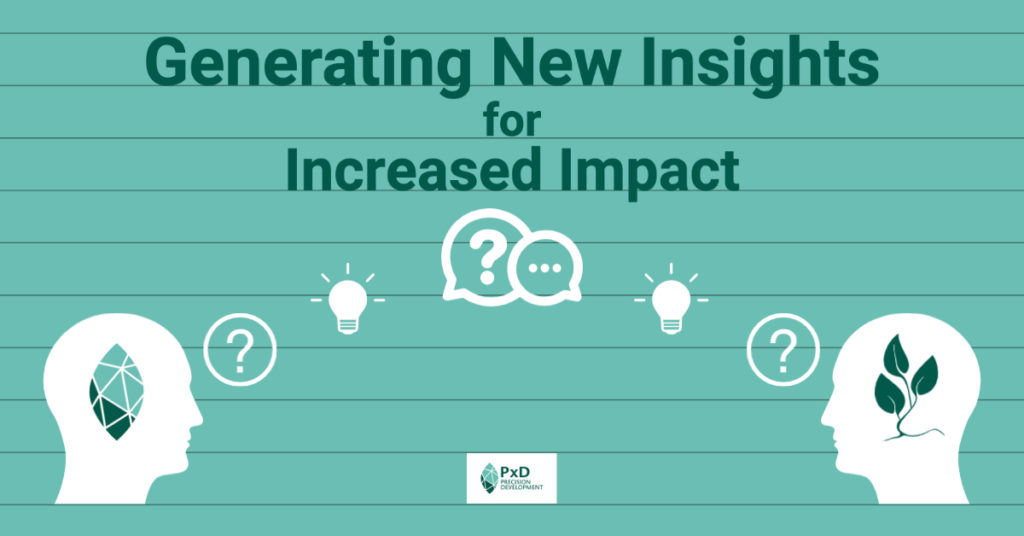
In 2020, PxD’s research team received dedicated funding to build out our evidence base. We are deploying these funds to support a portfolio of complementary and reinforcing projects in multiple geographic settings. This blog post describes how these new initiatives – many of which deploy innovative research methods – fit together and generate insights to advance PxD’s learning and the impact of our services.
Through the course of 2021, we commenced various innovative research initiatives with the intention of generating insights about how customized agronomic advice – facilitated and delivered by digital tools – affects farmer behavior and outcomes. A concurrent objective is to demonstrate the potential of digital agricultural extension to increase impacts over time – and at scale – through rigorous, evidence-based iteration and experimentation.
These new research activities consist of a mix of rigorous impact evaluations of PxD’s advisory services and smaller-scale testing of deep customization utilizing local or dynamic information with each project has been designed to develop insights on a combination of the following:
- Rigorous impact evidence on farmer outcomes;
- Theory of change supported by existing evidence, local data, and behavioral theories;
- Proof of concept, operational feasibility, or scalability in customizing and delivering advice; and
- Quantitative evidence to show improvements in intermediate outcomes like adoption of recommended inputs or practices.
Here are some of the ways in which these research projects will generate insights:
1. Rigorous evidence from impact evaluation on farmer outcomes:
Three impact evaluations will generate evidence on outcomes of farmer welfare:
- An impact evaluation of our Ama Krushi service for rice farmers in Odisha, for example, will measure rice yields. This impact evaluation also includes an assessment of the feasibility and accuracy of satellite-based approaches to rice yield measurement.
- An impact evaluation of Dairy Advisory Services in Kenya will make use of partner dairy cooperatives’ administrative data on output and sales to evaluate the impact of dairy advisory on farmers’ welfare, measured by milk production and profits.
- A third impact evaluation of the Coffee Agronomy Training in Uganda (UCAT) service will generate evidence on the impact of PxD’s stand-alone mobile phone-based advisory service on coffee yields, and the impact of PxD’s advisory messages as a complementary service to an in-person agronomy training on management practices.
2. Theory of change supported by existing evidence, local data, and behavioral theories:
In its second year of implementation, the treatment arm of the Ama Krushi impact evaluation will incorporate A/B tests to generate evidence against hypothesized causal mechanisms about how digital advisory can encourage farmers to adopt recommended practices, further building out PxD’s theory of change. The Dairy Advisory Service in Kenya will run content development workshops to source local insights to build out our theory of change and refine our understanding about how digital advice can address barriers to improved livestock management and achieve desired welfare gains.
3. Proof of concept, operational feasibility, or scalability of customization and the delivery of advice:
Agro-dealer engagement activities in Kenya will include mechanisms to identify a low-touch and scalable model for building a network of agro-dealers we can tap into to complement and reinforce MoA-INFO messaging with, and improve market linkages for, farmers. Our intention is to design and create services that agro-dealers will find valuable and engage with, and then generate insights about how these services can affect farmer’s input search behavior and access to inputs. We are piloting various strategies via our Krishi Tarang service in Gujarat to recruit and collect information from agents who live and work in communities where PxD’s farmer users live. This project will assess the feasibility of different approaches for crowdsourcing information from agents and farmers to improve the relevance and timeliness of advisory content. Crowdsourcing techniques can potentially inform approaches for collecting other time-dependent and/or locally relevant information such as GPS location data, the prices that farmers pay for inputs, the prices that farmers receive for produce, and weather-related information.
4. Quantitative evidence to show improvements in intermediate outcomes:
The Digital Tools for Extension Agents project in Rwanda aims to understand the motivations of volunteer community extension agents known as Farmer Promoters (FPs), and test the impact of motivational messages, customized to individual agent’s personality traits, on the performance and outcomes of the farmers they advise. We will generate quantitative evidence on FP performance to assess the marginal impact of better-targeted advice for FPs on farmer learning and outcomes, the impact of nudges on different activities, and how FPs allocate their effort when they’re being incentivized to work on a particular task. The Peer Group Learning project in Kenya aims to demonstrate the potential value of organizing users of PxD’s digital agricultural advisory service into peer groups. This project will generate quantitative evidence on improved knowledge and adoption of recommended practices through peer learning promoted via farmers’ organizations. In order to better understand this learning pathway, we will measure engagement with the MoA-INFO platform, the volume of communication within a peer group, and user trust in the information that is shared.
Summary of projects with categories and insight types to be generated
| Project | Location | Insight types |
| 1. Impact evaluation of Ama Krushi service for rice farmers | Odisha, India | i, ii, iii, iv |
| 2. Impact evaluation of Dairy Advisory Services | Kenya | i, ii, iii, iv |
| 3. Impact evaluation of Coffee Agronomy Training | Uganda | i, iii, iv |
| 4. Digital Tools for Extension Agents | Rwanda | iii, iv |
| 5. Peer Group Learning | Kenya | iii, iv |
| 6. Crowdsourcing Pest Information | Gujarat, India | iii |
| 7. Agro-dealer Engagement | Kenya | iii |
We have intentionally designed these initiatives so that they reinforce and complement one another. While these activities remain nascent, we are very excited by their potential to generate insights and increase the impact of our work across geographies and contexts.
Make an Impact Today

